VOLUME
ISSUE 02
Echo: The Poetics of Translation
Of the theme Echo:
Walter Benjamin once compared translation to hearing an echo in a forest. Such a metaphor for the act of translation suggests the sonic if not oral dimension of language and reminds us of the way in which there is a space between the original and its repetition. Translation then is a rich terrain of exploration for the arts.
ISSUE 02
2013
Echo: The Poetics of Translation
ISSN : 23154802
Introduction
Essays
Contributors’ Bios
Introduction
Introduction: Echo
Essays
When the Eye Frames Red with Trinh Minh-ha
Calendars (2020-2096): Heman Chong in Conversation
On Dying Alone
From Plato’s Cave to the Bat Cave
Echo as a Musical Metaphor
Contributors’ Bios
Contributors’ Bios
Introduction
Editor-in-Chief
Dr Charles Merewether
Editor
Venka Purushothaman
Associate Editor
Susie Wong
Copy-Editor
Lisa Li
Advisor
Milenko Prvacki
Senior Fellow
LASALLE College of the Arts
Manager
Olivia Cain
Contributors
Ahmad Mashadi
Akira Mizuta Lippit
Alex Mitchell
Darren Moore
Jecheol Park
Joanne Leow
Lauren Reid
Michael Lee
Miguel Escobar Varela Richard Streitmatter-Tran
Introduction
Introduction: Echo
The second volume of ISSUE commences with a provocation that Walter Benjamin compared translation to hearing an echo in a forest; and that the echo is not the original sound, and the copy not the original.1 To investigate this, we need to resuscitate the flailing nymph Echo pinning for the love of Narcissus, and one has to return to the primordial scene: the sighting.
In this volume, we have echoed two interviews, revisiting them to gain new insights, new reverberances: Trinh T. Minh-Ha’s “When the Eyes Frames Red” 1999 interview and Heman Chong’s “Calendars (2020-2096)” 2011 interview. Both have been selected to serve as parasites for the primordial scene. Trinh’s work paves a perspectival way to seeing and framing while Chong’s provides a critical rendition of time’s own entrapment within the condition of structure.
The ensuing essays by artists, filmmakers, academics and musicians represent a plethora of viewpoints, starting points and end points responding in their own to the echoes. They are intended to serve as counterpoints to the para-sites thereby providing a new rendition to an age-old conundrum regarding the real and original.
Footnotes
1 Introductory statement by renowned art historian, Dr. Charles Merewether at the international art residency, Tropical Lab 2013: LASALLE College of the Arts, Singapore.
Essays
When the Eye Frames Red with Trinh Minh-ha
Lippit
I want to begin by thanking you for agreeing to sit for this interview. It’s perhaps worth noting that this interview is destined, at least in the first instance, for a Japanese audience. There has been a vibrant interest in your films and written work in Japan, where you have recently spent some time, so perhaps we can touch upon those experiences and your reception there a little later.
It is in some ways an extremely difficult task to approach you for an interview. The conventions of this medium assume some notion of a constant or discernable identity, an interviewee whose essential features are either already known or can be known. In the case of Trinh T. Minh-ha, one recognises a filmmaker and a scholar, but also an artist of many shades, a perpetual traveler, and a person whose own history in the world is marked by the epistemic shifts that characterise this century and its thought. Looking back on the various interviews collected in Framer Framed, I’m struck by the sheer diversity of subjects that you speak of, but also by the sometimes anxious ways in which the interviewer tries, at times, to situate you within established traditions of experimental filmmaking, the critique of anthropology and conventional documentary, ethnography, poetics, post-colonial thought, feminist thought and activity and so forth. I’ll try to resist the temptation to identify, as it were, a fixed dwelling and try instead to follow the nomadic qualities of your expansive work.
Since many of your previous interviews speak to your cultural politics and positions vis-à-vis the subject of alterity, I thought we might approach this conversation from the vantage of your films, which represent, in my opinion, absolutely discrete and distinct pieces of work, which are nonetheless bound by a very particular spirit or desire. So, perhaps to begin with this notion of a project, how do you define your film project—if you accept the notion of a project—and how does your film work fit into your broader artistic and intellectual projects?
Trinh
When I work on a film, I am drawn very intensely to the world of images and sounds. On a basic level, such a state of creative availability and of active receptivity is in itself a “project.” But the making of a film also opens up many doors to other means of creativity. It sharpens the edge between, let’s say, writing for a book and writing for a film—a difference one constantly faces when words are part of the film fabric. Not only does the use of language differ markedly from one medium to another, but working with storytelling, poetry and everyday speech in cinema also makes me aware of music in ways I never thought of before. If a poem is an invisible painting, as Chinese artists put it, then a film can be all at once visible poetry, musical painting and pictorial music. The spaces between image, sound and text remain spaces of generative multiplicity, in which the function of each is not to serve nor to rule over the other, but to expose, in their tight interactions, each other’s limit. What I cannot avoid experiencing at certain moments of the process is both the different strengths and limits of these tools of creativity. So it is in working constantly with these limits and with the circumstances that define them that I advance, quite blindly, actually. Even though in discussions, it does seem as if all my projects are very lucidly thought out, this comes in the making process, not before it. Most of the time I jump into a project blindly, and this is how boundaries are also displaced.
Lippit
So you see the production of a film as something that opens up a space for writing, thinking, and learning, even as you are creating the work itself?
Trinh
Yes, very strongly. There’s a whole web of activities involved in and triggered by the making of cinematic images. I have no such thing as a preconceived idea that I want to visualise or illustrate through film. It doesn’t happen that way; it’s more likely through an encounter—with a person, with a group of people, with an event, or with a current of energy that is sparked by a specific situation.
Lippit
Your body of films suggests a certain consistency, an idea not of any totality, but of a shared quality. When thinking in the abstract about your films, they seem to offer a shape, to have and take shape, yet when one looks at the films individually, they are in many ways radically different. There persists, however, a common desire or spirit that motivates them. One motif that appears strongly in all your work involves an aesthetic or politics of travel. Another is the notion of encounter and portraiture. A portraiture that is not always of people or places but sometimes of relations to places, producing a sense in which the viewer finds herself or himself the subject of a portrait—as if the spectator is being watched.
I am interested in this dual sense of absolutely discrete projects with completely separate foci and emphases on the one hand, and the persistence of a communal space that works in your films on the other. I have noticed that interviewers often try to identify you within very specific communities and it seems impossible to do so. There is, it seems, something fundamentally nomadic about your work both in its geographical momentum but also in its intellectual or creative capacity to wander, as it were, and move—
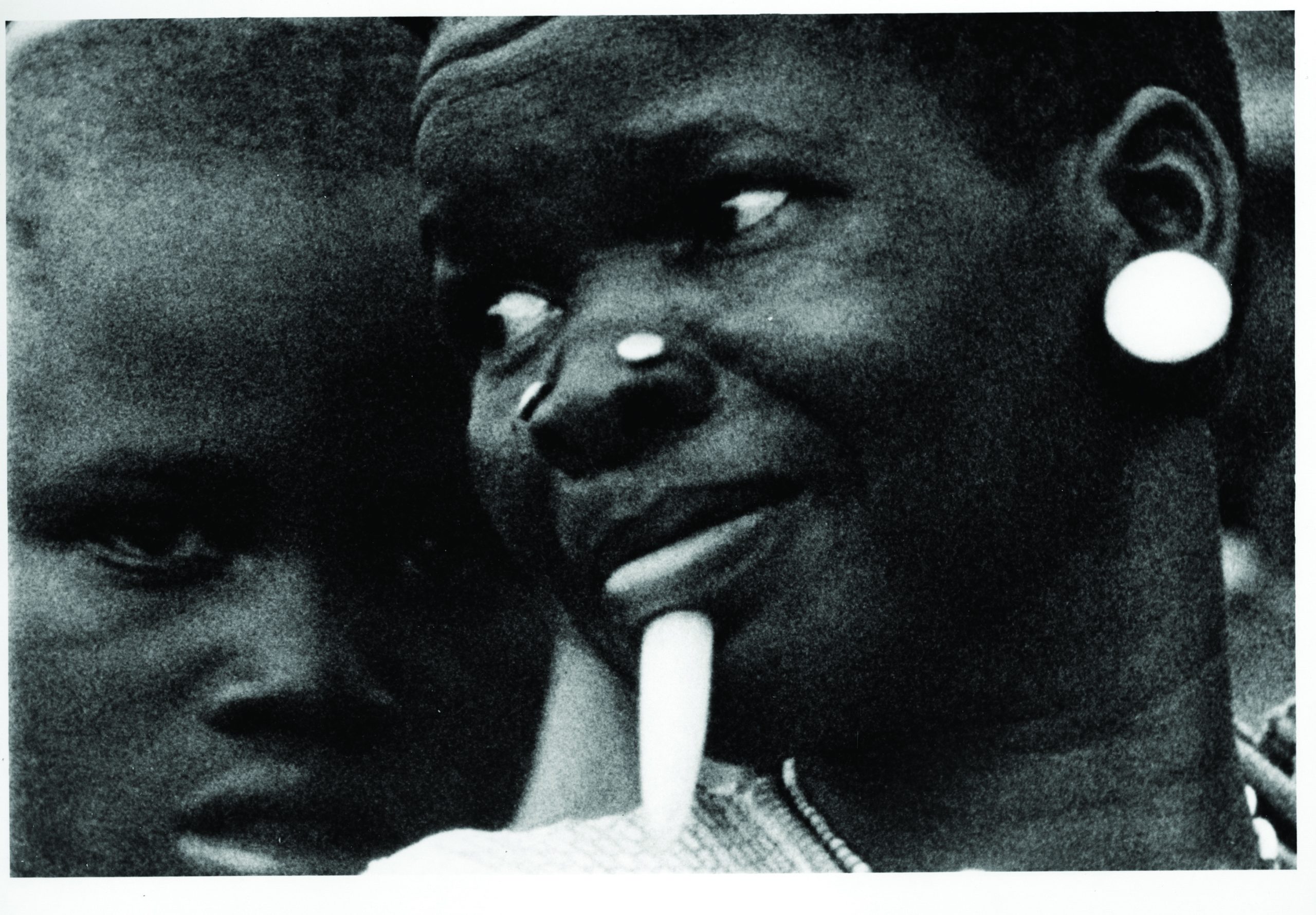
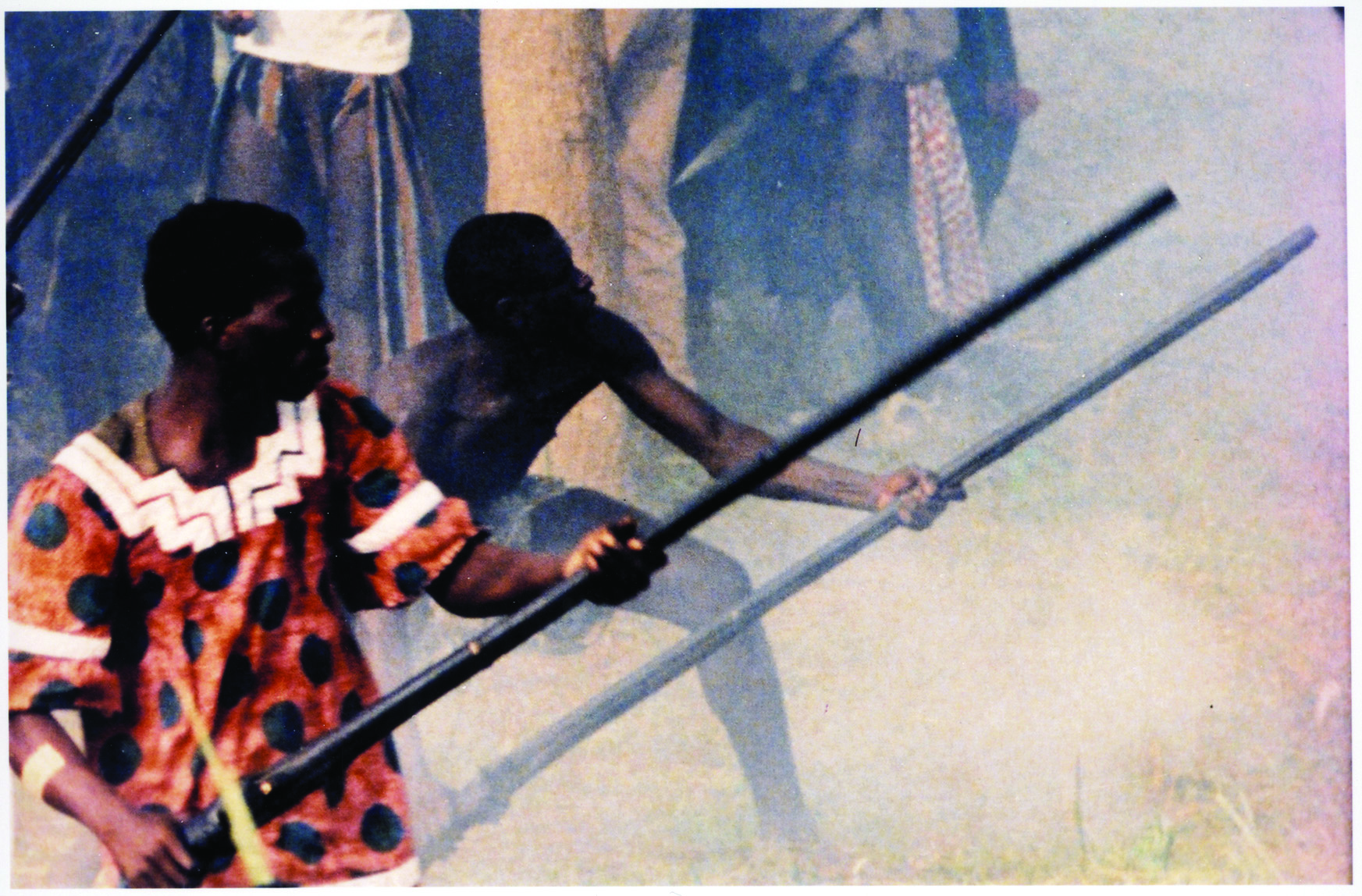
1, 2 Stills from Naked Spaces by Trinh T. Minh-ha, Courtesy Moongift Films.
Trinh
Perhaps something that seems recognisable in my work and can only be realised intuitively with each film, is this tendency in pushing the limits, to lead the work, just when its structure emerges, to the very edge where its potential to return to nothing also becomes tangible. Whatever takes shape does not do so simply in order to address form. In that sense, nothing really takes shape. By going towards things while letting them come to me in the mutually transformative process of filmmaking, I am not merely “giving form.” Taking shape is not a moment of arrival, and the question is not that of bringing something vague into visibility. Rather, the coming into shape is always a way to address the fact that there is no shape. Form is here an instance of formlessness, and vice-versa.
So when you talk about this sense of traveling, of wandering, and of not fitting comfortably in one group, it’s not so much something that constitutes an agenda on my part as something rather intuitive that corresponds to the way I live, to the skills of survival I’ve had to develop, and to my own sense of identity. I’m not at all interested in giving form to the formless, which is often what many creators reach for. Rather, I’m taken in by the creative process through which the form attained acutely speaks to the fragile and infinite reality of the world of forms—or, of living and dying.
How to incorporate that sense of the infinite in film is most exciting, even though we know that we always need a beginning and an ending, and that making a film is already to stop the flow or to offer a form. But rather than reaching a point of completion where form closes down on form, a closure can act simultaneously as an opening when it addresses the impossibility of framing reality in its subtle mobility. This is certainly one way of looking at what happens with all of my films.
The other aspect which you mentioned, which I love very much, is that, yes, there is a tendency to see the two films I shot in Africa as being alike and sometimes they are even scheduled to be screened one after the other in the same program slot. This is a terrible mistake, for Reassemblage and Naked Spaces need to be viewed as far apart from one another as possible, if the spectator’s creative and critical ability is to be solicited. Such a programming decision, detrimental to the reception of the films, tells us how people continue to see films predominantly in terms of subject matter. Yet how the two films are realised and how they physically affect the viewer are radically different. As I mentioned earlier, each encounter is so utterly bound to the elements that define it, that for me, it is impossible to reproduce, identically, what has been made at different moments of one’s itinerary, and with different peoples, circumstances and locations. The specificity of each encounter would dictate a different move for each film. In other words, each film has its own . . . field of energies.
Lippit
Yes, a vitality. It is surprising to think of Reassemblage and Naked Spaces as similar films. Do you feel that sometimes because the subject matter can be so powerful in your work that it interferes or disrupts other elements in the work? The subject matter you select is often very powerful.
Trinh
I’m very glad it comes out that way for you. There’s always a tendency to think that because I don’t come into a project with an idea in mind or with a preconceived political agenda, the content is of little account, which is not at all the case. I feel very strongly about the subject matter of each of the films—again, not as something that precedes but something that comes with the making of these films. In fact, people bewildered by the freedom with which my films are structured often react by saying, “Well then this film could have been made anywhere.” And I would have to say “No,” because each film generates its own bodyscape—as related to specific places, movements, events and peoples—which cannot be reproduced elsewhere.
But yes, I would agree that if the subject matter comes out strongly, then what we call structure, form, or even process, become less noticeable. Not because they are in any way less important, but because when everything clicks together in a film, it’s no longer possible to speak of form and content as separate entities. This reminds me of the other dimension, which you touched on earlier, namely, that the subject who films is always caught in the process of relating—or of making and re-presenting—and is not to be found outside that process. All of my films are actually attempts to bring out that process with and within the image. Because of the very tight “always-in-relation-to” situation, it is also difficult to simply indulge in the subject matter, as if it pre-exists out there, waiting to be retrieved “as it is.” There should always be some kind of a split somewhere that compels the viewer to pull out of the illusory screen space where subject matter tends to take over film reality.
Lippit
In watching your films again recently, but also following from what you have just spoken of, I am interested in your sense of framing. It has a peculiar tendency, although different from film to film, to make the familiar look unfamiliar, even peculiar and unknown. I am thinking especially of Reassemblage, where one looks at images that are part of a cultural vocabulary and yet the look of that film is so absolutely distinct that one begins to notice the very consistent but subtle sense of framing. Perhaps that also relates to your earlier comments about edges and borders. The framing doesn’t operate according to conventions, to the demands of balance or symmetry. Could you speak of your ideas regarding framing?
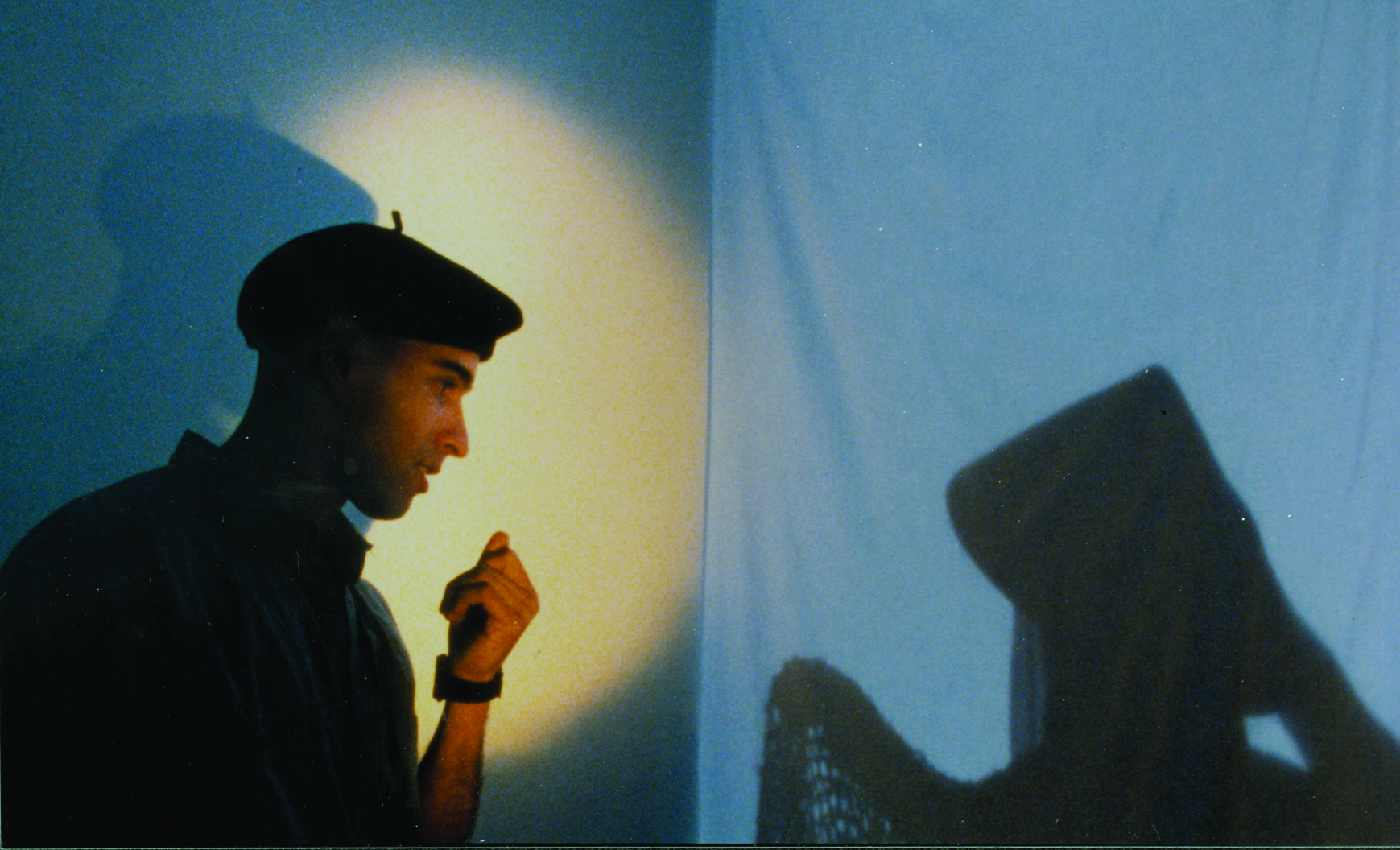
3 Still from A Tale of Love by Trinh T. Minh-ha and Jean-Paul Bourdier, Courtesy Moongift Films.
Trinh
Yes, actually we can go in many directions with this because it reminds me that when Reassemblage was first released, there were often, unavoidably, a couple of viewers in the audience at each screening who either praised the film or got very upset because they related it to a National Geographic product. Even today, I still occasionally encounter those kinds of response, whether in the U.S., in Europe or in Asia. And of course, there have also been instances where there is someone in the room who works for National Geographic who immediately says, “We would never accept such a film.”
Sometimes the mere fact that the subject matter is located in rural contexts or in remote parts of the non-Western world (what the Japanese film milieu commonly calls “ethnic films”), and the fact that, in addition, the images are bright and colourful, with no immediately definable or recognisable political agenda attached, are sufficient for some viewers to attribute the film’s look to the more familiar one of National Geographic images. I once said in response to a similar, aggressively voiced reaction that, ah yes, for some people all reds look alike, and that for them there’s no difference between the red of a rose, the red of a ruby and the red of a flag; nor is there any difference within the reds of blood flowing unseen in life and of blood spilled out conspicuously in death.
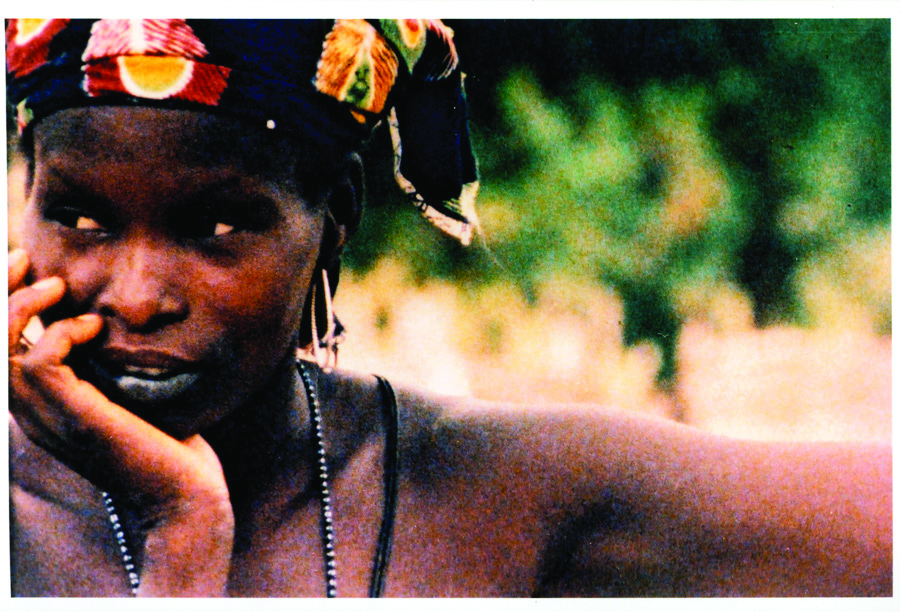

4, 5 Stills from Naked Spaces by Trinh T. Minh-h, Courtesy Moongift Films.
Trinh
Fortunately, a number of viewers do come to acknowledge on their own that what they first thought of as a National Geographic-type film does work on them, as the film advances, in such a way as to leave them ultimately perplexed and troubled. Days and even weeks after, they say, their perceptions of the film continue subtly to expand and to open onto unexpected views and directions. For me, this is largely due to a process of shooting and framing in which, as I mentioned earlier, the filming subject and the filming tools are always caught in the subject filmed. I don’t mind it when viewers in Europe link my films to those of Johan Van der Keuken, who is known as one of those truly “mad about framing.” I am not so much concerned here with composition, but as you’ve noted, I’m sensitive to the borders, edges and margins of an image—not only in terms of its rectangular confines, which today’s digital technology easily modifies, but in the wider sense of framing as an intrinsic activity of image-making and of relation-forming. Working with Jean-Paul Bourdier, who is an architect, has incited me to see in terms of space so as to decide where to put the camera and how to move with it. This is quite prominent in A Tale of Love, for example. While Reassemblage and a large part of Naked Spaces were shot intuitively with the camera placed very close to ground level, where most daily activities are carried out in African villages. Such a decision has an important impact on the image, but the frame itself is very intimately created while I am shooting.
Most of the time, if a good cinematographer sees an interesting subject and wants to use a pan, for example, she rehearses the gesture until the movement effected from one object to another is impeccable in its precision and certainty. In my case, I usually shoot with no forepractice and often with only one eye—the kino-eye, as Vertov called it. I may at times shoot the same subject more than once, but well, the first time always turns out to be the best, because when one repeats the gesture one becomes sure of oneself, which is what most cinematographers value—the sureness and smoothness of the gesture. But what I value is the hesitation or whatever happens when I first encounter what I am seeing through the camera lens. So the way one looks becomes totally unpredictable. Like wearing blinders and not seeing where one is going, the camera just moves with you according to the pace of your own body, or the pace of your camera pan. It is this attentive half-blindness that interests me. Rather than merely conforming to the ideal of seeing with both eyes while shooting—one inside, the other outside the lens and the frame so as to foresee one’s moves—I largely confine myself in the films I’ve shot to the eye that only sees reality via the camera. There is, in the look that goes toward things while letting things come to it unplanned, no desire to capture per se. You start a move and then simply continue it to see what comes into that framing in time and space.
Now there are films where I’ve worked with a cameraperson because I had to do more directing. Here, it is difficult to talk about one approach, because mine is necessarily mediated by the camera operator. In Surname Viet Given Name Nam, in the interview scenes of Shoot for the Contents, and especially in A Tale of Love where fiction intensifies framing, the sureness of the cinematographer’s hand is inevitable. But I value that element as well, when it doesn’t come from me. For it is then simply another element that contributes to the experience of film as an activity of production. Non-knowingness is an attitude, not a technique to perform. What is specific to the cinematographer also has a place, and even if that cinematographer does not decide on the framing, the gesture, rhythm and sureness developed are hers. Treating these as her contribution to the process also means that one necessarily creates a different space for the film. What you have is something, let’s say, between the open-ended process of the filmmaker and the skilled expertise of the operator.
Lippit
The images are beautiful in your films, strikingly beautiful—much more so than in National Geographic—and that may be an effect precisely of what you have described. Your description of the process of filmmaking for you suggests something more on the order of the sublime. Rather positing mastery over her medium, her subject matter, the filmmaker here loses herself in the process of making a film. It’s very different from the more popular notion of the filmmaker as a master of one’s craft, of one’s subject, of one’s space. Your description of the first gesture, the first movement as the one that you regularly prefer suggests a kind of dissipation or a loss of the self in the act of filmmaking. And the result can be a very beautiful image that emerges from the encounter with that dissipation, rather than from the assertion of one’s mastery in the form of a pan, or tilt, or some kind of practiced gesture.
Trinh
What you’ve just elucidated is very different from how people usually understand it. I feel much more affinity with the terms you use—“the loss of oneself,” by which one gains everything else, and hence no mere loss. The tendency among many, when I try to put this process of filmmaking into word, is immediately to recast it in terms of spontaneity and personal subjectivity. The first gesture is then viewed as the more truthful one. But the moment of spontaneity, which is so sacred for modernist art in general, has its limits. One can be quite clichéd, when being spontaneous. And there are often more instances, where instead of encountering elements of surprise or newness in spontaneity, one simply faces a form of reification of the individualist self.
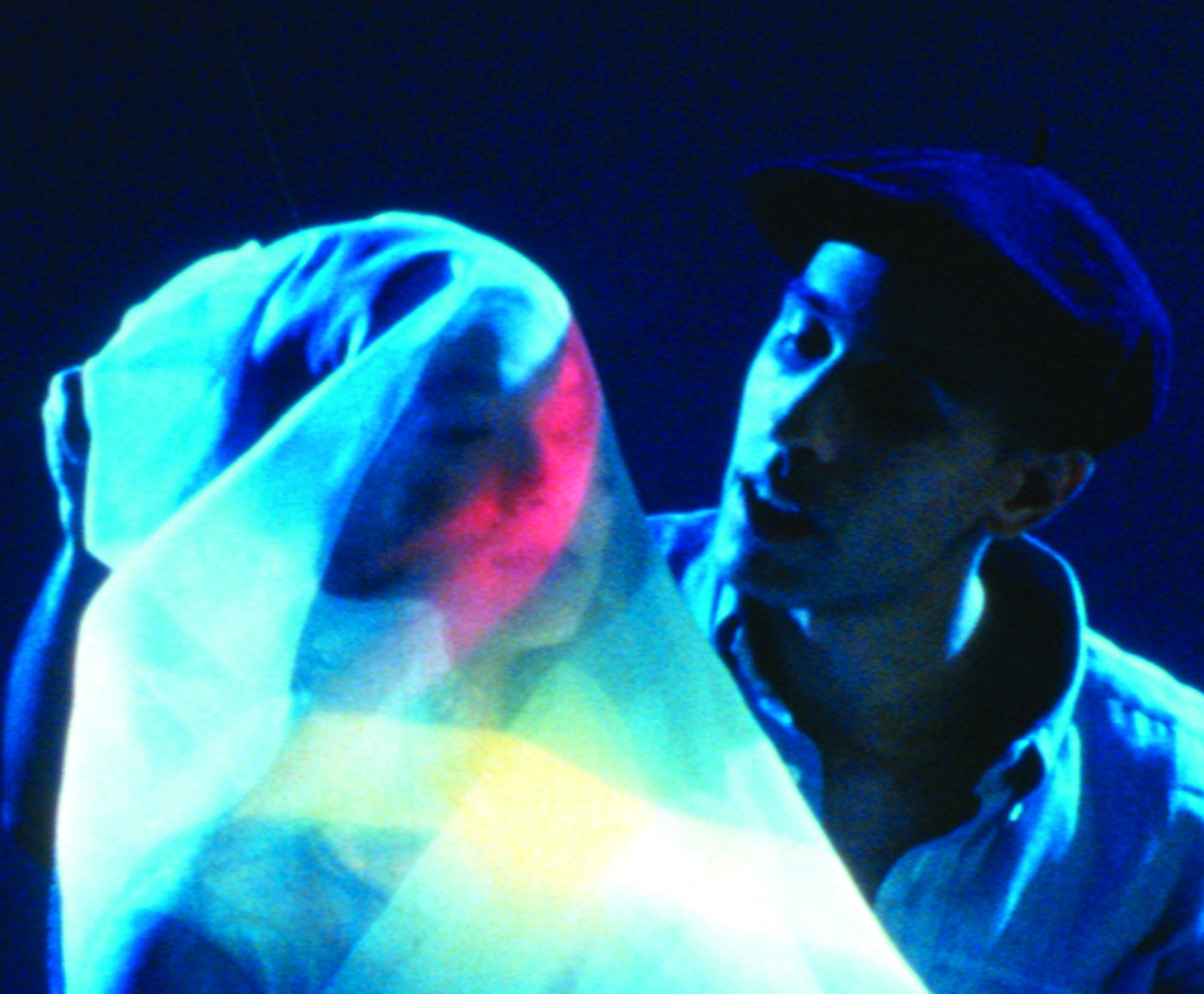
6 Still from A Tale of Love by Trinh T. Minh-ha and Jean-Paul Bourdier, Courtesy Moongift Films.
Lippit
The fantasy of a spontaneous gesture does suggest the emergence of an authentic or genuine self: A truer self that escapes in the inattention of spontaneity. Another feature that I find striking in your work is the adamant tension between images but also the sounds that are sometimes naturalistic and at others synthetic, artificial, and staged. Sounds are often broken, just when one is ready to be drawn into their flow. And one feels this at work in a variety of places, certainly I would say in Shoot for the Contents. During the interview with the Chinese filmmaker, for example, one recognises a very theatrical mise-en-scène – similarly in the interviews that constitute Surname Viet Given Name Nam. Do you see these tensions between naturalistic and synthetic representations as an element of your style, or do you see them as a dialectic that works between the notion of nature, naturalism, or things as they are, and the process of reflecting, commenting, filmmaking—“being nearby”?
Trinh
Neither one of those. Perhaps if I can find a way to say it on my own terms, it would be to say that what is viewed as being natural on the one hand and staged on the other belongs to a whole process. If one looks at the image in terms of representation, then I’m not simply representing “substance,” but I’m actually bringing out what one can call “function” or “condition.” In Shoot for the Contents, the image is mediated by the translator—a literal translator during the interview with the Chinese filmmaker, but also other translators heard or seen through the voices of the narrators and of myself as writer, editor and photographer of images of China. The fact that both makers and viewers depend here on translation in order to have an “entry” into the culture was clearly brought out in the sound-image. On one level, this interdependence made visible and audible may appear artificial, but on the level of its function within the process of producing meaning and images, it is totally natural.
This “natural” process is precisely what has been widely suppressed in films that try to get at “substance” while forgetting the importance of function and field in the mediation of reality on film. As the Indian philosopher Coomaraswamy said, one cannot imitate nature; one can only operate the way nature operates. When one thinks in those terms, the two currents you mentioned (one naturalistic, the other synthetic) are one and the same. To call attention to the subjectivity at work and to show the activity of production in the production is to deal with film in its most natural, realistic and truthful aspect. So I don’t see the separation. This largely applies to my first four films; with A Tale of Love, where everything was thought out down to the smallest detail, the situation is different. Ultimately, despite the contrasting way with which this last film fractures conventions of genre and of narrativity—or of psychological realism in acting and in consuming—its direction expands the one adopted by the previous films.
Lippit
In A Tale of Love, I was struck by, among other things, your use of colours and filters, which reminded me of the beginning of Naked Spaces, where you use a very saturated, seemingly tinted image. It creates a disorienting space because the colours and textures are so vibrant and voluptuous throughout the film that one begins to distrust one’s own senses. One can no longer tell what the so-called real colours of a scene are and those colours begin to infuse more than just the image, but all of one’s perceptions, projections, fantasies. It produces a kind of hybrid space, fantastic and actual. This colouring also seems to operate in A Tale of Love, which replays a previous tale, The Tale of Kieu, not as a historical citation, but as something that forms a hybrid text between a historical document and one’s interpretations of it. You make this clear in the film and in an encounter I saw you have with a member of the audience at a screening of A Tale of Love. She was an older Vietnamese woman who insisted that A Tale of Love was very different from the text she had studied in school. It seemed to be a perfect response to the film precisely because you suggest that there are always these hybrids that are forming between an external space grounded in reality and one’s encounter with it, which immediately creates some sort of space in between. Could you talk about your own motivation in A Tale of Love and the kind of interest that drew you to that project?
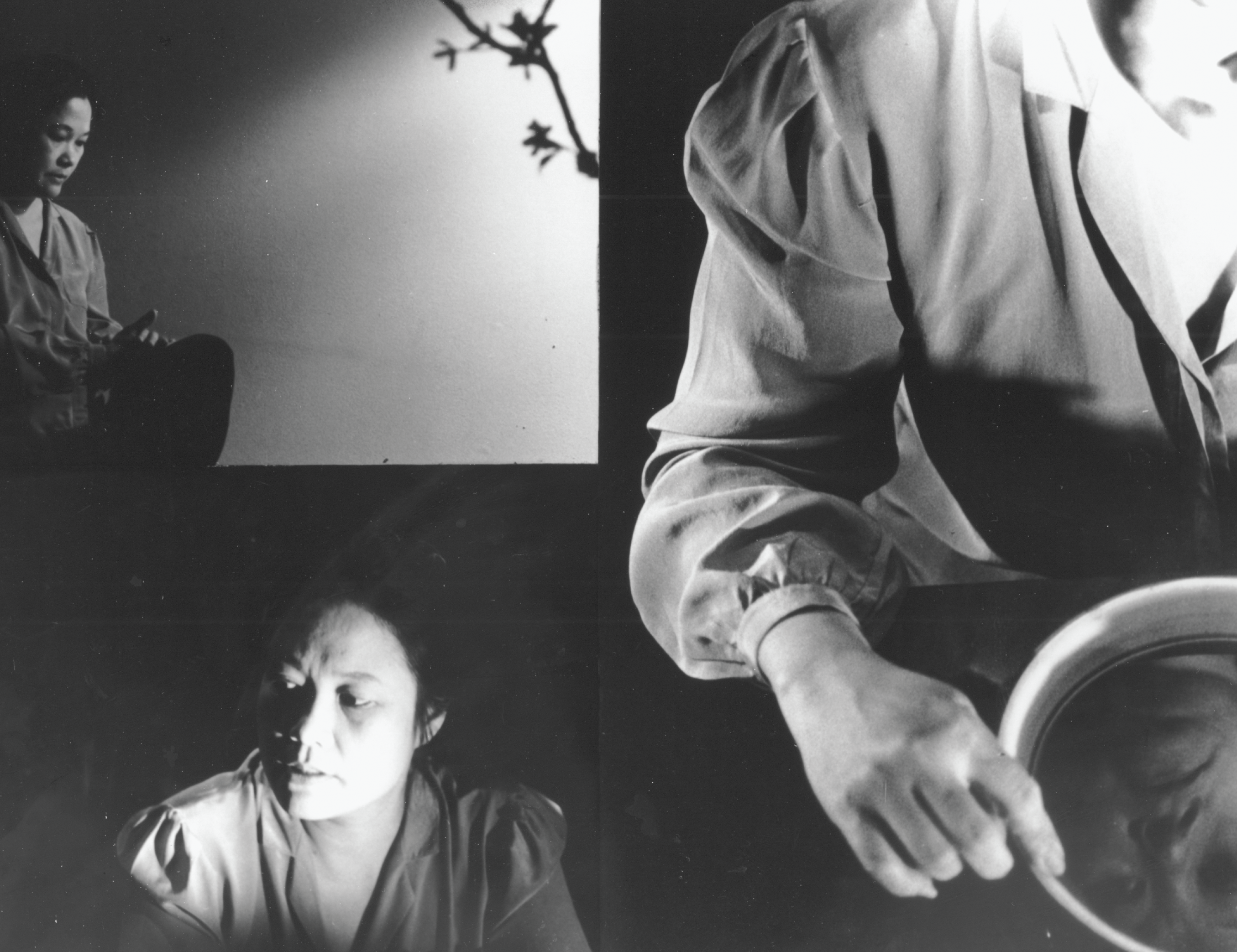
7 Still from Surname Viet Given Name Nam by Trinh T. Minh-ha, Courtesy Moongift Films.
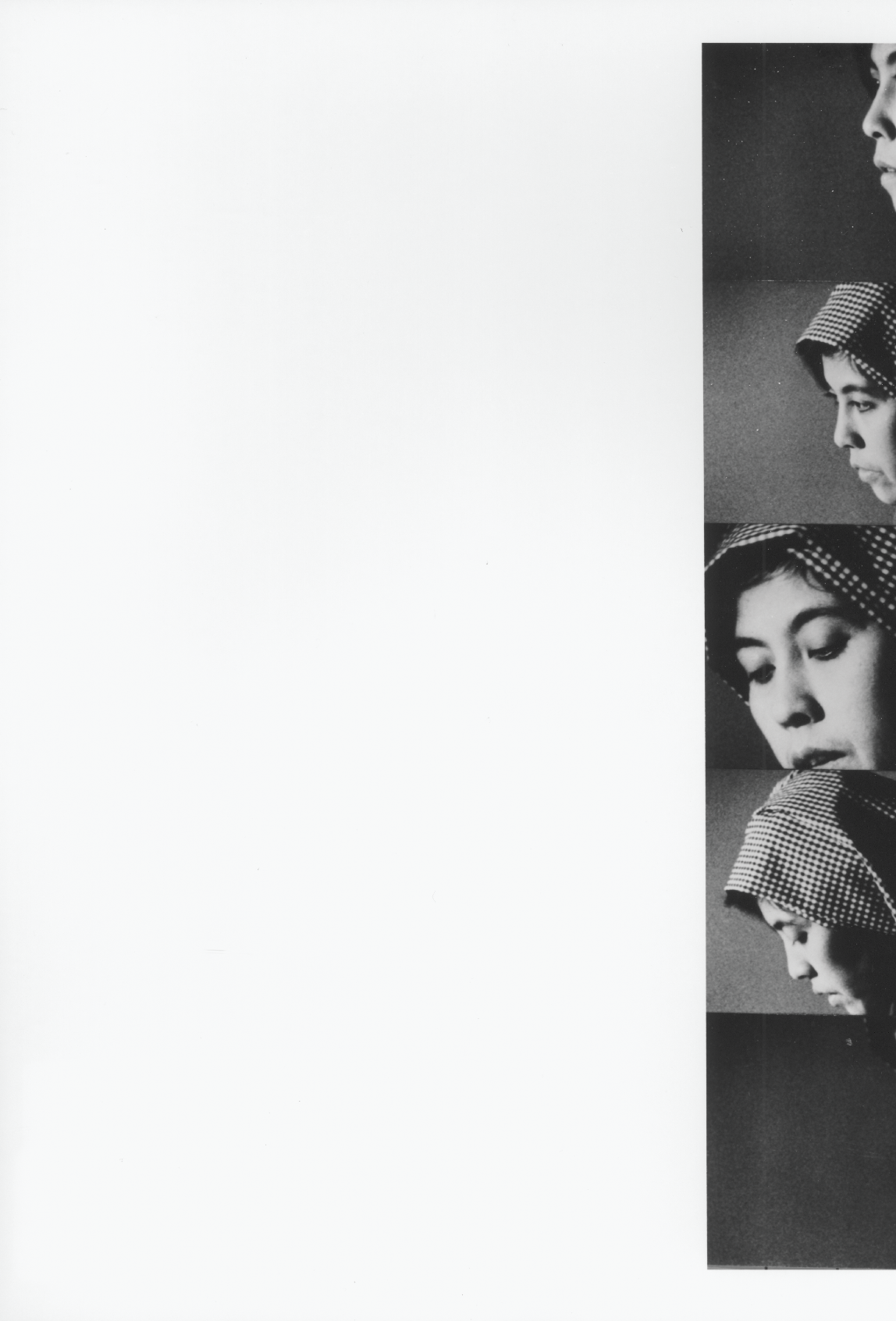
8 Still from Surname Viet Given Name Nam by Trinh T. Minh-ha, Courtesy Moongift Films.
Trinh
There are actually two things in your response that I would love to discuss. First, I find it very interesting that you link the two films through colour. Second, I would come back to the twist you’ve brought out, which turns the Vietnamese woman’s negative response into an accurate response for the space created. Other members of the Vietnamese community who have seen the film have also given a number of very interesting reactions. For example, the epigraph seen on screen at the beginning of the film is a quotation of the ending lines of the 3254-verse poem. So “Why begin with the ending?” some asked and added, “Not only that, but afterwards, you enter the poem in such diverse places that it throws us off and we are confused.” One man told me, however, that because of these decisive cuts into the different parts of the poem, he saw through the film, the space between makers and characters. This was wonderful for me, even though he didn’t mean it in a positive way and was telling me about this undesirable split in which “your character is timorous and undecided but you are a very tough person.”
In the context of patriarchal Vietnamese culture, this was no praise at all. But then I was very curious and I asked more specifically why he thought so. He said the way I edited the film was such that every time he started settling in with a recognisable thread of the poem, the cuts again and again jerked him out of the story space. He saw in the edits what one can call the split of voices, which is an interesting reaction when compared to the tendency among Western audiences to identify the filmmaker with the main character. The question asked often revolves around whether the film tells of a personal experience. “Does this come from your personal life?” It makes things very difficult because certainly, I would have been totally unable to make a film if it hadn’t engaged me strongly in a personal way, but this has little to do with one’s own particular life. It would be of no interest if filmmaking and filmviewing merely invited identification rather than offered an encounter with what is larger than one’s individual self—that is, with one’s own spaciousness.
To come back to the question of colour, the tinted effect of that very first sequence of images in Naked Spaces actually comes from a rather “natural” process. The Kodak film stock we carried with much care with us over a period of nine months of travel across West Africa was, in general, quite reliable. But perhaps the heat played a role here, because amidst all this footage of accurate colours, we suddenly found two rolls that came out all red. When I called the lab to ask what had happened, nobody understood why it had come out that red—because it could have turned out slightly tinted, brownish or partly reddish, which is the usual case with older film stock. I was actually quite happy with the look, and since I didn’t cause this effect on purpose, I immediately saw it as part of this solicited “otherness” in filming.
Trinh
One of the film’s foci was the wall paintings of African dwellings, whose colours change with our perception and with the shift of light through the day. Light and darkness also structure people’s living spaces and influence women’s daily activities. There is a whole network of relationships built up in Naked Spaces between film, music, architecture, and social life through elements such as light, colour and sound. So the red incidentally caused by the heat appears as a natural process that easily finds its place in the main threads of the film. But by opening the film with this red sequence, I‘m also using the colour as a marker to invite the viewer to come into the film differently—with a light that can pull you far in, as differentiated from the green that pulls you out in the subsequent images; and a light by which you are projected into another state of mind even while you look at things “as they are.” When you encounter colours in such a state, as you so nicely put it, the dualism of inside and outside loses its pertinence; you are no longer so sure of how colours come to you, from in here or from out there. This is also how I see those houses: as you stay with a space and try to shoot it at different times of the day, you can see how light and colours are shifting in ways that open onto an inner landscape unseen by your daily purblind eyes.
In A Tale of Love, the question of colour is almost the opposite: you create it as an explicit part of lighting. Since we had to plan out all the details in a “narrative film,” with a large crew shooting from a script, we were dealing with a very constraining space. How is one to conceive of lighting when it is not simply used to fill in a space, to make things legible, to hierarchise and to dramatise according to psychological realism? By visualising it, for example, in terms not only of projection but also of absorption. The move here is to experience light as it is formed by the differing qualities of darkness and by the receptive properties of things (texture, tone, movement, reflective potential) in relation to their surrounding. Here, colour (as an attribute of life in Naked Spaces) comes in as one of the ways by which light itself takes shape. Just as the primary colours featured in the film stand on their own in a challenging relationship of multiplicity (rather than of complementarity), many of the lights that cross the frame have a distinct shape and colour of their own. We might say then, to use a term we discussed earlier, that this space in A Tale of Love is saturated with artificiality, which is fine with me because it’s what the making of a film with a script should acknowledge—a space carefully fabricated, if not entirely fabulated. But again, “artificial” is not opposed to “real” or “true,” for to materialise a reality, one has to resort to the “non-true,” and it is finally through the fictional—be it image or word—that truth is addressed.
Lippit
The story of colour in Naked Spaces is quite fascinating. It is as if the place, or the process, as heat had pressed itself onto the film directly, created a tactile trace of having been touched—a fortuitous disaster it seems. In a similar vein, I know you have discussed in the past your relationship to the interval, to uses of silence, or a variation of silence, speechlessness, which comes up as a motif in a number of your works. I am interested in not only the intervals of sound or silence that appear on your soundtracks, but the ways in which one feels those intervals or silences even when there is sound. Which is to say that the exploration of intervals or silence in your work seems to be at such a sophisticated level that it occurs even when it isn’t, strictly speaking, a moment of silence or pause, or some interruption of the sound. I was wondering if you could situate your interest in the concept of silence, and how it works in relation to your work, which is also very discursive too.
Trinh
When I discuss my work with an audience, what I generate from their reception of the film is something different from the film. I can’t tell them what “the film is all about” (which is what film reviewers often claim to do), for I do not wish to imitate what the film is doing. Rather, what I try to give to the audience is yet another space with the film. Very often discussants tend to confuse this discursive verbal space with the film and say, “it’s so complex, how can people who haven’t heard you understand the film?” But film and discussion are two different realities. Aside from the fact that you can’t assume that nobody understands because you don’t understand, “understanding” also cannot account for the whole of film experience; it is only one among the many other possible activities of reception. Once, in a public discussion of my work, a viewer made a very complicated and long-winded remark that ended disapprovingly with this statement: “Art should be simple.” And I agree. Even when the opinion comes from someone who can’t be simple in his response. Simplicity has always been a big challenge for artists. But the simplicity of a film has little to do with the complex responses it can generate. The simplest work tends to yield the widest range of readings and of critical thinking. Simplicity and complexity, as it is stated several times in Naked Spaces, really go together.
Similarly, silence expresses itself in many ways and can be said to be a whole language of its own. Sometimes speaking is a way of keeping silence and being silent is an effective way of speaking. This is often the case in repressed political contexts, such as for example the case of the calligrapher who appeared on screen towards the end of Shoot for the Contents, and whose answer to the question, “Why did you move from Shanghai?” was so clearly a form of silence, that I decided the best way to translate it, was not to translate. This moment of non-translation in a film that directly addresses the issue of translation has raised questions among a lot of people.
As you said, silence can be a moment when you don’t hear sound and this can be radically disturbing when taken literally. In film, silence usually means filling the soundtrack with discreet environmental sound like birds singing or water lapping, or else with what is technically called “room tone.” In Reassemblage I actually cut off all sound from time to time, creating this dreadful phenomenon for filmmakers known as sound holes. A very perceptive viewer told me that when he saw Reassemblage, because of the way that the soundtrack was cut off, he suddenly had glimpses of a spectral reality that addressed him directly. He said that it was an experience of death irrupting between images and in a way, he’s an ideal viewer for that film. Rather than simply equating a sound hole with a technical mistake, one can ask what effect this has on the viewer, what reality is brought about? The reality of something we call death, or among others, the reality of the room in which the film is showing—the snoring of the audience, the squeaking of seats, the noise of the projector or the pulsation of one’s own body, as Cage musically experienced it.
It’s very difficult to simply talk about silence as a homogeneous phenomenon. As you’ve noticed, even when there’s sound or a lot of talking, you can still feel that interval. I really appreciate that, because, unlike with the films shot in Africa, Surname Viet Given Name Nam, Shoot for the Contents and A Tale of Love feature language in its excess as it outdoes the will to speak and to mean. There are also moments when words become nonsense, which is another aspect of language that I often work with humorously. After so much speech, you come to a state where opposites really meet. You may say or hear one thing but you’re supposed to mean or to understand exactly the opposite, which was the case with such terms as left and right, right and wrong, as related to China’s politics. But that’s the nature of language. When one pushes it far enough, words start to mingle, they are no longer opposites and the more one goes into it, the more one sees how these words used excessively can also silently open up a critical space.
Lippit
What I find especially liberating in your films is the way in which you track the movement of language from a place to its destination. And frequently, it doesn’t arrive at its destination, which is a much more compelling way of thinking about language, communication, all of the complexities of its transmission, and translation. That non-arrival, or missed arrival seems much more provocative and much more familiar, even, as an experience than the shot/reverse-shot convention in which movie conversations are usually sent and received. In another interview, you relate the experience of a translator running up to you frantically and saying “But there are two voices here, which one do we translate?” The fact that things are lost or miscommunicated or fail to arrive at their destinations is hardly frustrating, but actually a relief to see in film, because it really begins to address the circuitry of language. It seems that in your films the interview is never a stable phenomenon, even from film to film, but something that is addressed and created as a space each time anew, never occurring in the same way. Each space seems to be driven or motivated by the particularities of that space and your relationship to it.
Trinh
If people thought about language in the way you just described it, then my films are very simple. It’s the same with my books. I do hear from a number of academics that my books are very difficult. And I don’t deny this. On the other hand, I’ve also met people who left school at the age of fifteen or who have no training for theoretical thought. They come across these books by accident and they can’t read many pages in one go, but they have no concern for that, they just steadily read a few pages at a time and say it’s incredible, because they feel a lot of affinity with the process of my thought and can follow it so well. If one simply observes how language operates—creating all these circuits within itself, as you said—and how it works on us constantly, then these films are very easy to “understand.”
When an interview is dense and intense, as in the case of those in Surname Viet Given Name Nam, then even in moments when one is not in front of the interviewee, the conversation continues, not in one voice, but sometimes in several voices, or in fragments that come and go and get superimposed on one another. There’s nothing difficult in the film when one thinks inclusively in terms of what language does to us—how it speaks us as we speak it—rather than exclusively in terms of ourselves as the ones who manipulate language. Any one of those instances that may irritate the viewer by its so-called incomprehensibility is for me as clear as a river. They happen all the time in our daily reality with language.
Regarding the anecdote about which voice to translate when there are several simultaneous voices, I was amazed by the Japanese solution. Actually, with Japanese characters, that problem did not even arise; my distributor at Image Forum simply decided to have one voice subtitled vertically, the other, horizontally. Not only do calligraphic characters destroy the image much less, but you also have this flexibility of going vertical or horizontal.
Lippit
When A Tale of Love was about to be released there was a small fervor that Trinh T. Minh-ha had made a narrative film, and there was something of a scent of scandal about the whole thing. When I heard this rumour, I was little surprised because it is not as if your previous films could be classified as strictly non-narrative work either. They had elements or traces of things that one might call documentary, for example, or experimental or art film, or music film. And then when I saw A Tale of Love I was reassured that this wasn’t a narrative in the way that people seemed to be disparaging the term either. Certainly it was a narrative and it engaged aspects of narrative. But it was also done in 35mm. Could you talk about your decision to work with this format and this narrative structure? What prompted you to explore this particular set of elements?
Trinh
It’s just like with the colour red discussed earlier in Naked Spaces. The decision was bound to circumstances. I didn’t have the budget to shoot a “feature narrative film,” not even a budget for 16 mm. So in a desperate move, the line producer called everywhere searching for donations. Panavision donated the camera equipment in 35mm for the whole shoot, rather than in 16mm as we had asked, which was such an incredible thing. But I paid dearly for that, because I got stuck after the film was finished. The final edited version was completed in 1995 but I had to wait until 1996 before the film could be released in an acceptable form because there was no money left to make a print.
Certainly, there’s also another decision that comes into play. And as you said, it’s not so much a question of narrative versus documentary, it’s more a question of exploring a different terrain of cinema. Since I’ve explored at length the terrain of, let’s say, information and truth, I wanted to explore this other terrain which is that of the lie and its truth in love stories. I wanted to see what happens when you deal with something as commonly consumed in our society as the love story. But as you can see, despite the difference in realisation, the direction explored is similar to the one taken in the previous films.
Lippit
In each of your films, one senses the particularity of a place and a space that seems to orient the film. One feels that the space is dictating or directing the movements of the film, a mixing of geography and fantasy, experience and projection. Knowing that you have spent some time in Japan recently, and that you are also working on a new project, I was wondering if you could talk about your new project and also about your sense of Japanese space?
Trinh
It’s difficult to talk about a visual space before you get a chance to see it realised on film or video. I’ve just only started work on it, but let’s say that after having been to Japan, I think, five times, my experience of the culture during this last four-month stay, which was the longest stay, has changed quite a bit. It was a thoroughly demystifying experience, although not in a negative sense. You just have a reality that is differently nuanced, less romantic, but also less exotically other.
As with many foreigners, I am drawn to the spiritually ritualised aspects of Japanese life and art. The integrated dimension of aesthetics and ethics has been quite striking in a number of Japanese works, for example. I am very attracted to shooting in Japan partly because of its architectural landscape, which really favours the graphic line and the mobility of sliding frames. Here, the line between outside and inside is always shifting. It seems as if everything—from the art of building houses to the way the railroad network functions, or the way dance and music structure theatrical performances and festival parades—partakes in a system whose organisation is largely based on micro-structures or on prefabricated cells (the melodic, the rhythmic, the action-propelling and the structure-bearing cells in a parade, for example). There’s also a striking encounter between light, colour, and graphics in the scenography of life and stage events that I would love to work with. But as always, I have to remain very flexible as to what I can do, since I don’t work with unlimited finances and everything still depends very much on that. I have to take into consideration the fact that maybe I will not be able to get permission for the locations where I would love to shoot, such as in temples, since the next film is very much related to a spiritual quest.
At the end of this millennium the notion of spirituality may continue to raise skepticism because what is spiritual is often identified, at least in the modern world, with mystification and institutionalized religion. A return to the traditions of old is also to be rejected as long as these are viewed only through activities of retrieval and of imitation rather than of creation in the present. This, I think, is the very problem we face today, both in the modern East and in the West, with our inability to see the spiritual in any other way than smugly and narrow-mindedly, as a form of parasitical occultism and of transcendentalism. The situations with Tibet or with Islam are glaring examples. As a spiritual force that gathers people across geographies and nations, Islam certainly stands, despite all controversies, as the one visible power that continues to challenge the West at the end of the millenium. It is necessary in these times to look at spirituality in a different way. And certainly, Japan has had a strong tradition of writers and filmmakers who have struggled with this dimension of life, from which I also draw inspiration.
Lippit
These glimpses are very intriguing. The quest for a spiritual existence or identity, a rethinking of spirituality, should be of interest to late-capitalist Japan as well. Thank you very much.
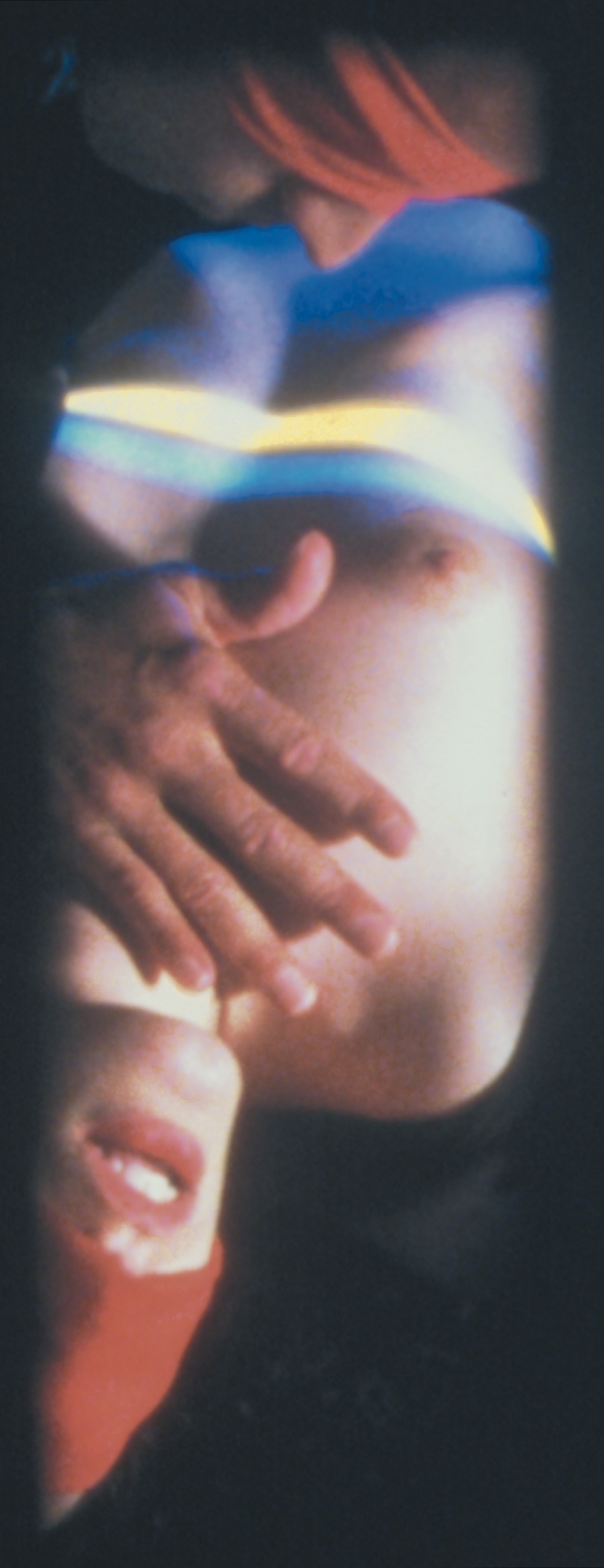
9 Still from A Tale of Love by Trinh T. Minh-ha and Jean-Paul Bourdier, Courtesy Moongift Films.
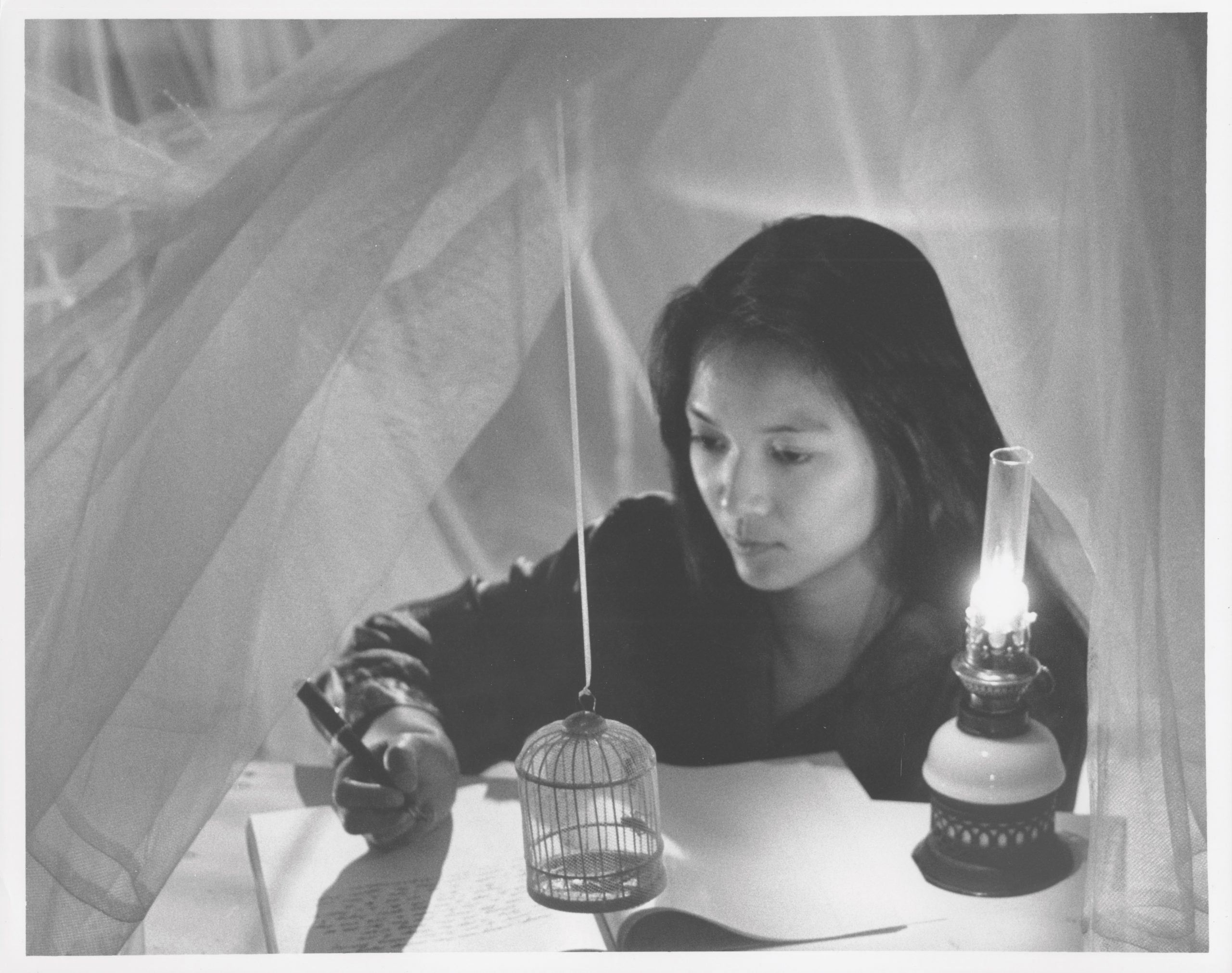
10 Still from A Tale of Love by Trinh T. Minh-ha and Jean-Paul Bourdier, Courtesy Moongift Films.
11 Still from A Tale of Love by Trinh T. Minh-ha and Jean-Paul Bourdier, Courtesy Moongift Films.
Published with permission of Trinh T. Minh-ha and Akira Mizuta Lippit, 2013.
Copyright Trinh T. Minh-ha and Akira Mizuta Lippit.
First published in Japanese in Intercommunications (Journal of Art and Technology, Tokyo, Japan), No. 28, Spring 1999 (for part I); and No. 29, Summer 1999 (for part II).
Published in 2005 in The Digital Film Event: Trinh T. Minh-ha, by Routledge, Taylor and Francis Group, New York.
Essays
Calendars (2020-2096): Heman Chong in Conversation
The following article was published in Calendars (2020-2096) for the exhibition of the same title of Heman Chong’s work, in 2011 at NUS Museum, Singapore.
Heman Chong’s installation at the NUS Museum consists of 1,001 photographs presented as 2020 to 2096 calendars. Collated over a period of seven years, the production of these images was guided by a set of simple rules: these photographs are taken during periods of public access, and that they are emptied of people. Photographed in various parts of Singapore, places visited by the artist included public housing estates, shopping malls, eateries, tourist sites, and an airport; these emptied spaces were conceived as tableaux, within which subjectivities may be deployed or e nacted by their viewers, complicated by a conceptual interplay with the calendar as a notion of linear time. Chong describes the work, installed in a gridded format occupying an entire gallery, as a “dream machine”, an intriguing apparatus without an operations manual characterised by its servitude to the impulse of imaginings rather than objectively determined: “How can this construction be useful to anybody except myself?” Heman Chong discusses Calendars (2020-2096) with Ahmad Mashadi in relation to his expansive practice as artist and a curator, and authorial strategies that involve collaborations, appropriations and quoting, and synoptical devices that facilitate modes or reception.
Mashadi
You work with multiple projects moving quickly from one to the next; Calendars (2020-2096) consist of vast set of images, completed over a lengthy period. You described the project’s immensity by its references to “time, space, situation”. Conceptually one imagines the project sustains a particular approach of practice. Where do we start?
Chong
We can start by talking about the value of coherence in an artistic practice that is situated in the context of today; how can we measure the value of an artist’s contribution to the language of art, and in turn, to the landscape of cultural and knowledge production? Viewing the situation from my perspective as a relatively young artist from Singapore who has more or less discarded a trajectory of production that revolves around the usual suspects of specific mediums like installation, painting, sculpture as grounding points (which is something that is prevailing, not only in Asia, but across the other continents as well), I am much more interested in working with these methods as conceptual vehicles for a basis of discussion about issues and things surrounding us. For example, I am interested in how a series of painted images; images of book covers could, very quickly become, an auto-biographic tool which then very quickly shifts into a series of hysterical recommendations to people of which books they should read. So, in a way, it’s somehow about surpassing the need to focus on one’s ego, to extend a dialogue beyond the idea of the self into something much larger.
Mashadi
That is interesting. It is that very question of coherence in which many had commented on a sense of ambivalence on your part. We can go into the specifics at a later stage of the discussion. For now, let’s push on with some generalities. Where the demands of contemporary production involve multiple negotiations, the coherence being referred here disavows any formal categories and instead, as you pointed out, revolves around manners of working and attitudes. In other words, you develop conceptual strategies and it is within these conceptual strategies that we may locate productive perspectives of an artistic practice, an autobiography as you put it. There are so many things to unpack here. Let me start by asking you if you can expand the phrase you beautifully used “...to extend a dialogue beyond the idea of the self into something much larger”. It seems to me it demands another way of thinking about the “authorial” and “authorial strategy”, not effacement of self, but rather affording into the practice forms of slippages arising from contexts, peoples, and encounters...
Chong
I feel very strongly that our identities are constructed around the things we associate ourselves with. And I am also conscious of the fact that I exist in a very privileged situation where I have an abundance of associations to work with. The questions that often haunts me are: What will I do with all this material? Is there a way to use it so that it reflects both a private world and the world at large? How can this construction be useful to anybody except myself? Do I want my work to be useful at all? One strategy that I have imagined over the years is to perform a set of recommendations, namely of novels, to the ‘audiences’. This, of course, extends directly from the conceptual legacy of ‘pointing at things’. I feel happy when people email me to talk about a certain novel they have just read because of a painting that I made, or a mention of that novel in an interview, and how we can come together not to talk about me or my work, but to discuss certain interpretations of that novel. For me, it’s important to have such a basis for any kind of conversation, a plateau, where we are teaching each other something, learning from one another.
Mashadi
I guess you are referring to ‘identities’ in the potentials as something indeterminate, something situational perhaps. The projects of where you work alongside others carry risks. Based on what you have just said, the writing project Philip (2006) is an interesting one... you brought a group of people together—artists, designers, curators—to initiate a ‘science fiction writing workshop’ eventuating with a publication. Here the term collaboration is structured with pre-assigned roles and process, and the outcome—the book—identified. The otherwise singular voice of the author is replaced with a sequence of different voices, each simultaneously pushing and pulling as one struggles to sustain one’s intertwined status as an individual and as part of a collective. Here, in many ways ‘process is form’, and that at times necessitate one to embrace the potentials of failure (at times we fetish over it). To what extent, as a project initiator, do you surrender to risks?
Chong
I guess the thing about empathy is that when we start to feel for someone, when we begin to bridge ourselves to another, we start to change. And there is a great desire inside me to want to change. Not so much as a moralistic exercise (for the better) or having a day out (for the worse), but something that falls in-between the two (for better and for the worse). No, I don’t really want to consider risk as part of the equation, because I’ll be too afraid to do anything that might foster change. Within the context of Philip, we soaked ourselves in this atmosphere of being impulsive, of writing whatever we wanted that immediately became part of a larger imagining. It was super interesting to how the entire ecology within the novel was literally constructed out of the multiple viewpoints that each of the participants brought with them, and how their cultural and emotional baggage contributed to the minute details that became the architecture of the world. At the same time, it became very clear, very early on in the project that two of the participants in the writing workshop, Steve Rushton and Francis McKee, both had this amazing ability to be able to juxtapose and edit the worlds into a singularity. There was a lot of trust involved in that situation, where we knew that our input into the novel would be weaved together in a way that could become something... readable.
Mashadi
Does it prompt a newer regard in your thinking about the public? You earlier remarked on the importance of public reception to the works. How easy was it to engage a readership where the integrity of art in its final form should be negotiated to solicit the potentials of collective production, a fluid plot that is contingent on accumulative and sequential contributions from each participant?
Chong
We discovered that there is an audience that craves to encounter a process as such. And that finally, it was this process that drew them into reading the novel. It has also to do with the distribution of the novel. Initially, we printed a hundred copies as a first edition, to raise funds to cover the production costs of the project (which worked) and then we had the second ‘run’ parked within Lulu, a print-on-demand service. We also distributed the novel freely as PDF, without any charge. Who wouldn’t want a free copy of a science fiction novel?
Mashadi
Joint authorships like Philip is one aspect of your practice. Ends (Compiled) (2008) takes on a different approach, It affords you to take on a ‘collaborative’ strategy that is appropriative rather than one that involves negotiations. You chose passages from published books written by various authors. Here we can return to your thoughts on a practice having an autobiographical inference, in a sense that passages in Ends, actually may suggest ways predicaments interact with ironies or suspended resolutions sketched out by these respective authors. You chose from Olaf Stapledon’s Star Maker (1937) “... striving to win for their race some increase of lucidity before the ultimate darkness...”. It is about the idea that entity is part of a collective organism, and knowledge is relational to one another, finality unattainable...
Chong
On some days, I sometimes feel that I am eternally damned to just merely being someone who can quote very well, and never seen as a artist who can actually produce something original. It is, perhaps, my greatest anxiety in my life. Even if appropriation has very clearly been validated by both institution and individuals as a completely legitimate way of producing meaning, I guess, personally, I’ve always wished that I never used it. Somehow, it’s something that’s way too flippant. Too easy... Even though Ends (Compiled) was in fact, an extremely well choreographed work, both in the selection of texts and the way it has been presented as a sculpture, I remain dissatisfied. At the same time, it remains to be a very useful tool especially when I’m asked to ‘interact’ with a certain preconceived idea from a curator about a certain situation or a space... what I’m trying to say is that appropriation is great when you need to develop something like a ‘non-denial, denial’ or a ‘non-event, event’.
Mashadi
By the phrase ‘non-denial, denial’, you are referring to attempts in developing formal and conceptual tensions that resists curatorial or institutional affirmations?
Chong
It is not so much an act of resistance as much as a reminder that, like it or not, we live in complex times and as a result, frameworks drawn of out of easy categorisations can fail in an extremely uninteresting way. Just take for example, how contemporary ‘Southeast Asian’ is being defined: most curators would gladly take on tribalism and animism over conceptualism and intellectualism...
Mashadi
We had discussed the question of the ‘authorial’ as an artistic predicament, but in many ways it is within your curatorial practice that the question seems most urgent… Difficult to tell if it is an extension of art practice. We worked together several times in particular for We (2008) and Curating Lab (2009) where you referred to the collation of materials we gathered for the exhibition and the artworks as ‘collecting’. It seems to me this is a way to remind ourselves that they have agency while at the same time ‘possessed’ in the manner in which the quotations you just referred to have resonance in saying things that may (or may not) be defined to one’s positions.
Chong
The two roles are interchangeable and I have never sought to define them in strict terms. Just as I have never really played the ‘Asian artist’ card in an explicit manner (especially when invited to shows in Europe and North America), even if a lot of my work deals with a lot with the various trajectories in which intellectualism and conceptualism has failed to take root in Southeast Asia. I don’t have a desire to take up mantles that would allow for easy compartmentalisation. I have observed, in the past ten years of being an artist and playing such a loosely defined role, it has this effect of distancing myself from curators and gallerists who find my work ‘too confusing and too difficult’, but at the same time, I have also encountered a group of curators and gallerists who are completely into this definition. For example, I know for a fact, that the Singapore Art Museum is one institution that has dismissed my work as being ‘too international’ for their taste.
Mashadi
Yes, identities forced along notions of ethnicity and nation can be quite a burden, which good or bad, are forms of currency in art-making and reception, here as much as elsewhere. I think it is not a question of resistance, but rather perhaps insisting for a critical engagement that acknowledges the contingency of multiple contexts and references. Your focuses on technology, society and fiction, and your methodical, almost hyper-rationalised use of texts and graphics are calculated to insist this is a difficult proposition?
Chong
I refer to a work that I made in 2009 entitled The Forer Effect, an appropriation of a text within an experiment by Bertram R. Forer that has the same nickname. He issued a personality test to his students and told them that they would each be receiving a unique personality analysis that was based on the test results. They were to rate their analysis on a scale of 0 (very poor) to 5 (excellent) on how well it applied to themselves. In reality, each received the same analysis:
‘You have a great need for other people to like and admire you. You have a tendency to be critical of yourself. You have a great deal of unused capacity which you have not turned to your advantage. While you have some personality weaknesses, you are generally able to compensate for them. Disciplined and self-controlled outside, you tend to be worrisome and insecure inside. At times you have serious doubts as to whether you have made the right decision or done the right thing. You prefer a certain amount of change and variety and become dissatisfied when hemmed in by restrictions and limitations. You pride yourself as an independent thinker and do not accept others’ statements without satisfactory proof. You have found it unwise to be too frank in revealing yourself to others. At times you are extroverted, affable, sociable, while at other times you are introverted, wary, reserved. Some of your aspirations tend to be pretty unrealistic.’
On average, the rating was 4.26. Only after the ratings were submitted, Forer revealed that each student had received identical copies composed by him from various horoscopes of the day.
In light of this, what I’m trying to say is that while words don’t come easy to most people when they are trying to define a situation, to some, they come a little too easy.
Mashadi
Let’s discuss this obliquely in relation to the current Calendar project which was conceived sometime back, before you left Singapore for New York. You had undertaken a number of photographic book projects focusing on Singapore sites before initiating the Series. What were they? What did you aim to achieve in these book projects?
Chong
I never have had a master-plan for anything in my life. Mostly, I just improvise and adapt along the way. The reason why I mention this is because, when you look at Calendars (2020-2096), you will get the impression that from the very beginning of the project, I knew what I want to do. Which is completely not the case at all. When I began to photograph these interior spaces accessible to all (most) people, I did it because I was searching for a new idea, a new beginning, a new way to collect images. I believe very strongly in the power of observation, where you will literally just look at something, break it down in your head in the most logical way possible and then ‘archive’ that sensation of that image. I don’t have a photographic memory, and that is why I rely on photography for that part of the process. These spaces, they intrigue me, on a structural level and also on an emotional level. Somehow, I know that they are so susceptible to change, to every sway of policy, to every new wave of capital... In a way, it was the same with the books I made, about specific sites in Singapore. The first was about Telok Blangah Hill Park, where the National Parks Board commissioned this totally insane structure which runs from the foot of the hill to the top, something we came to know of as ‘Forest Walk’. I am inherently interested in how ideas affect spaces, and how spaces can be representative of certain things that we (or more aptly, ‘they’) would be concerned with, at a certain point of time. In this case, somebody really had this idea of a nature reserve that is accessible to ALL, including the least attractive people of society, the handicapped—people without any means of mobility. They built a huge metal structure, which functions as a giant meandering ramp up (and down) this hill. I find this completely fascinating, how they even could start of conceive of such an idea. How does a conception about a GIANT RAMP UP A HILL start?
Mashadi
From the perspective of production, the project is unburdened by any assumptions on outcomes. I understand that it is largely conceived along the need to generate fresh trajectories of practice, but the notion of cities suddenly emptied of its inhabitants is rich in its potential, not least in science fiction. You spent time in places like shopping centres during opening hours waiting just for the right moment to capture a scene without anyone present. Is there a conceptual underpinning here defined by ideas connected to plausible settings in science fiction? Or is there a commentary element—dystopia of sorts?
Chong
I would say that Calendars (2020-2096) locates itself within a conceptual framework of utilising gestures, in this case, that of waiting and appropriating images within a specific moment, that moment of absolute emptiness, which can be quite rare considering how densely populated Singapore is. But at the same time, it has this dimension where I am also interested in formulating a kind of fictional landscape, one which reflects all the concerns of dystopic narratives, especially of the ‘last man on earth’ genre. This genre often deals with a global cataclysm which results in the near annihilation of the human race. Whether it’s an ecological disaster or a full-blown biochemical infection, the stories usually become humanitarian; they are stories of how humans can survive the worst possible situations.
So in a way, I am interested in staging the landscape in which these stories occur, and to use them as banal images for a banal activity, that of recording time...
Mashadi
Based on your earlier remarks, the Telok Blangah project seems to conceptually point towards the ironies and contradictions of spatial production... and in some ways in same manner in which we regard science fiction as having its furtive roots of criticality with the contemporary, the Telok Blangah and Calendar projects seek a placement into the current day.
Chong
But also to suggest that our imaginations are also important in placing ourselves into the everyday, that we have possibilities to imagine ourselves inside and outside of situations. For me, this is one of the crucial skills of a good artist.
Mashadi
The decision to present those images as calendar illustrations was made during the period of photography?
Chong
Yes. I took seven years to complete the entire project, and a huge part of it was to allow for a series of divergences to occur without any kind of prior planning involved. So a lot of it was left to chance, and one of the results, for example, was to use the photographs as accompanying objects to the actual marking of time.
Mashadi
How many images are there in total? How are these images organised according to the years, and are there particular ways in which the images are being clustered? At some point you decided that the large body of images were best mobilised as an exhibition. You mentioned earlier about the forms of subjectivities and your wish to facilitate through these images. How do you intend to display them? It seems that placing the images and into a calendar format allows you to intimate towards some of the conceptual interests you were talking about. The subject of post-apocalyptic (or even post-rapture) world may directly be inferred. The calendar, the suggestion of an impending event, gives a millenarist tinge to the work? And the condition of present as another.
Chong
There are 1,001 images in all. I arranged the photos according to a series of categories, which are evident in the spaces themselves—corridors, shop fronts, big rooms, small rooms, etc. There are also some categorised by sites—Depot Road, Haw Par Villa, IKEA, etc.
There’s a lot of contestation with the actual presentation, and I think it might be best at this point to follow a certain grid within the space, and to show all 1,001 pages containing all seventy-seven years of calendars within a single plane. I chose the year 2020 to start the calendars as a result of an observation about the idea of 2020 as the year in which all the problems in the world could possibly be ‘solved’. In many political press releases, we can notice this kind of promise, and of course, we now understand that these projections do not necessarily mean that any of the promises can or will be fulfilled. We constantly have to manage this sense of disappointment when it comes to such statements from the people that we thought we could place our trust in.
Mashadi
In that respect the images can also be taken in relation to specific potentials, beyond a universalising notion of time markers resplendent in economic or social programmes. These are specific locations whose economic, social and even political utilities are shaped by prevailing structures and responses to the same. Does that put you in an uncomfortable position as observer/commentator, offering a critique on the politics that informed the production of such spaces and their dystopic inevitabilities?
Chong
I don’t see it as an uncomfortable position at all. I think art is a language in itself, and has its own potentials. I don’t want to apologise for speaking this language, but at the same time, I acknowledge that this language can only be understood by a very limited community, often causing a lot of misunderstandings when art projects are discussed within other fields like sociology or politics. In recent years, a lot of artists have been working in this field of producing knowledge, and while I appreciate a lot of the material generated from these projects, it is something that I don’t want to do, at least not in the way of producing knowledge like how an academic would. I prefer to work along the lines of subjectivity and speculation, and mostly, I just let things go wild, let them become hysterical. In my work, I don’t want to place the emphasis on ‘making sense’.
Mashadi
Yet there are formal elements that insist we look at them as enquiries of spatial organisation, order, placement, tonal value etc. In that sense there is a generousity that imbibes the viewer’s place. These images cam be ‘free floating’ too, their significations negotiated by the viewer themselves. Their post-apocalyptic reference inflected by conditions of spectatorship...
Chong
It is about constructing a kind of dream machine, a space which allows for dreaming of all sorts… How these spaces, dislocated as photographs immediately become empty stages which all kinds of things can occur.
Mashadi
To end, can we go back to the question of the ‘authorial’, how an artist’s relationship with his viewer is a complicated one? The ‘synoptical’—the invocation of an expansive and general view of things—affords multiplicity of perspectives and readings. To what extent do you regard its limits? I am thinking about One Hundred Years of Solitude, the work that you presented for the Singapore Biennale in 2008. It conflates many things... the original book by Gabriel Garcia Marquez, the billboard as a capitalistic expression of imposed desire, and predicaments as currency of negotiation...
Chong
A project that has been on my mind for a long time is to write to all the political ministries around the world that regulate advertising in public spaces, and to propose that they would reserve a certain amount of advertising space for the promotion of novels. While there is no certain quantifiable data that reading novels (at least the ones that are worth reading) makes for a better society, we can all at least agree on the fact that we would have less of half-naked models with unreal bodies in skimpy white underwear to confront.
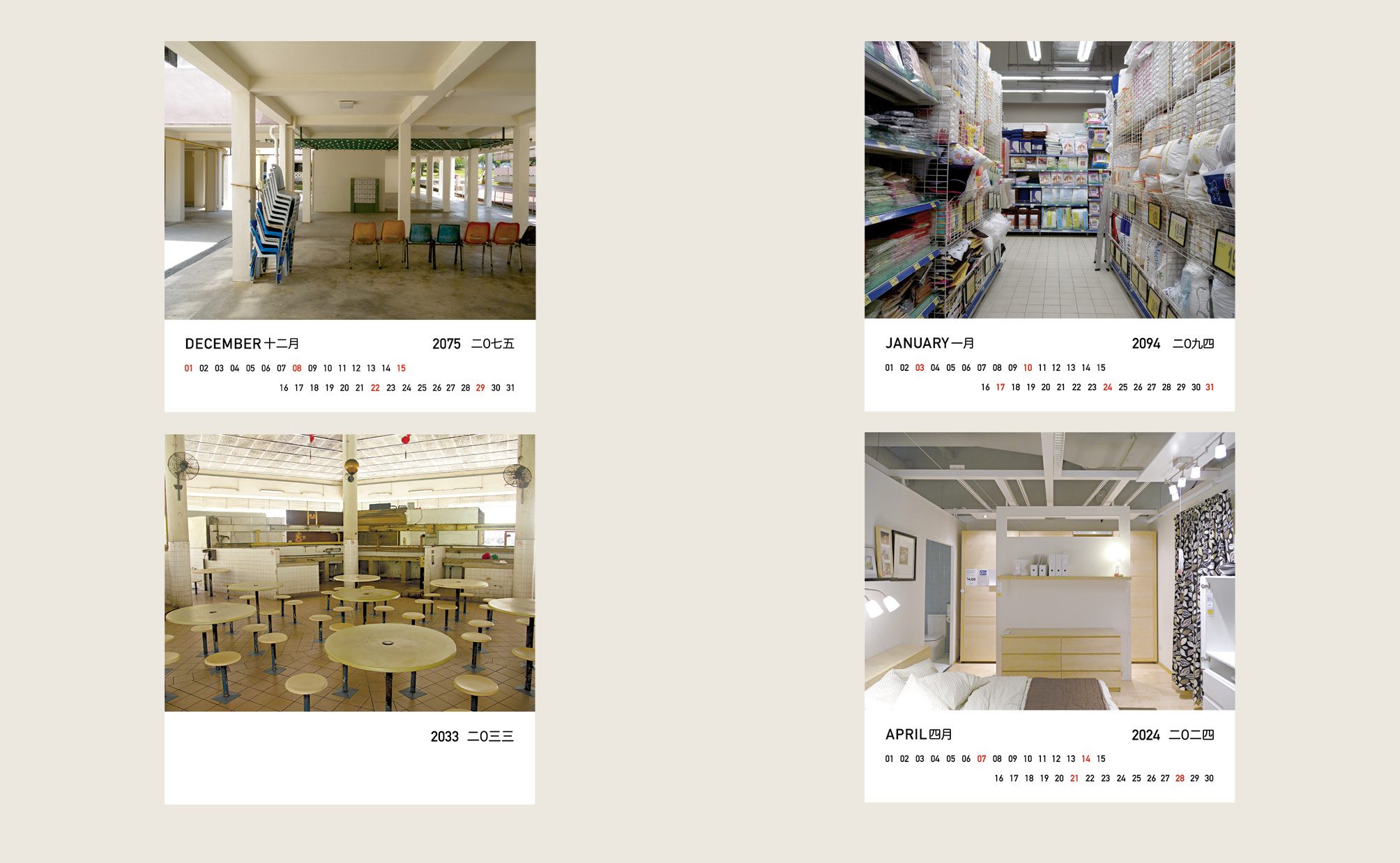
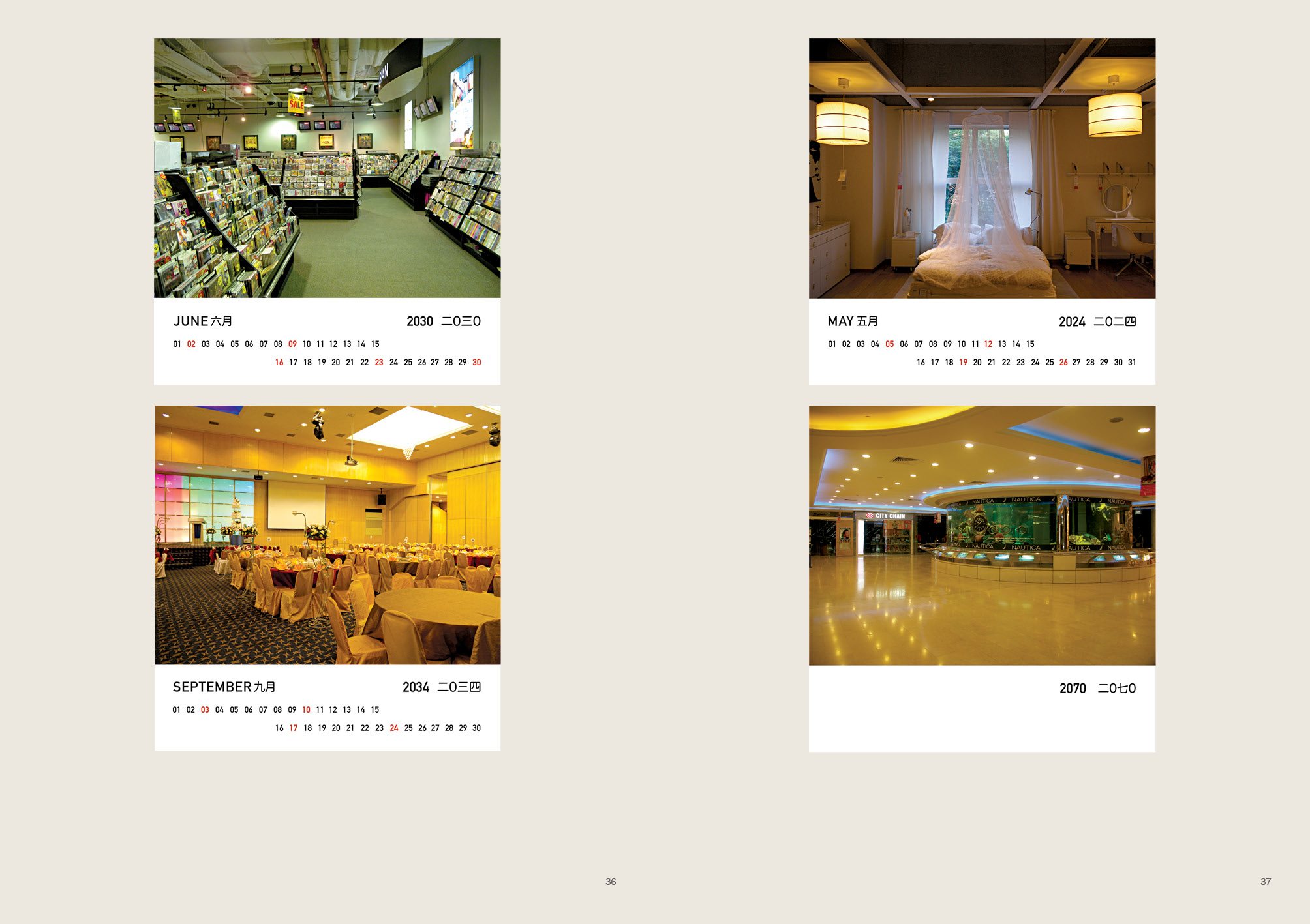
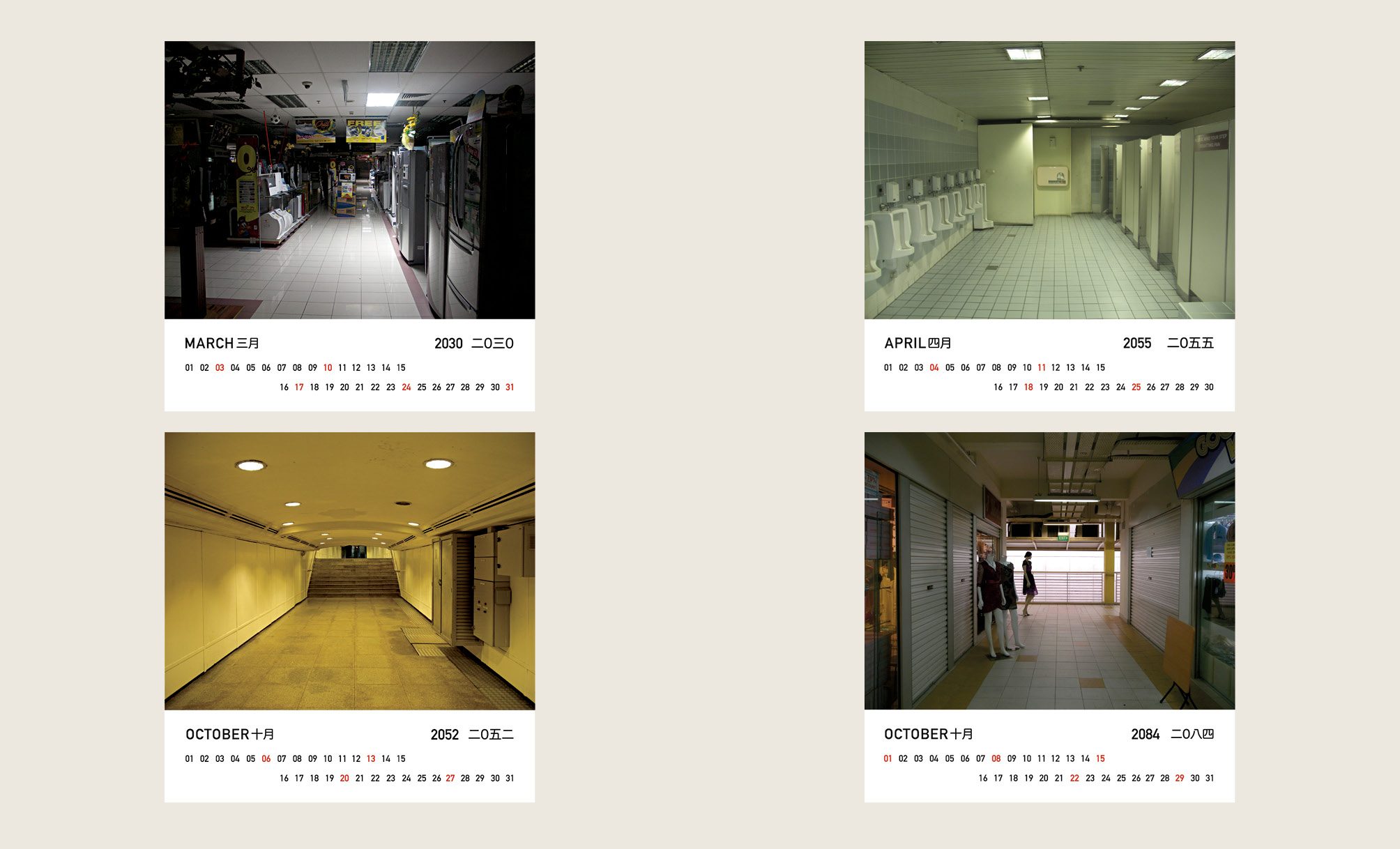
Essays
“The time frame of four minutes and thirty-three seconds is purely an artificial parameter, so that period of time we can listen and concentrate to the music of the environment which is constantly ongoing, it never ceases and is continually varied. We never listen to the environment; we’re too busy listening to the thoughts in our head.” –Margaret Leng Tan, Singapore GaGa
For historians, echo provides yet another take on the process of establishing identity by raising the issues of the distinction between the original sound and its resonances and the role of time in the distortions heard. Where does an identity originate? Does the sound issue forth from past to present, or do answering calls echo to the present from the past? If we are not the source of the sound, how can we locate that source? If all we have is the echo, can we ever discern the original? Is there any point in trying, or can we be content with thinking about identity as a series of repeated transformations? –Joan Scott, “Fantasy Echo: History and the Construction of Identity”
Sound Inventory
We take for granted that smell is a powerful trigger of memory, yet what we often forget is that in an ever-changing urban space like Singapore, smell is elusive and impossible to record. Demolishing old buildings, old spaces, and natural spaces means that these smells are gone for good—to be replaced with smells of new paint, new concrete, new carpet, and regulated temperature-controlled environments. Sounds though, sounds can be preserved, and these sounds become echoes when digitally recorded standing in for a very bodily memory of space. After all, sound is how our city touches us, touches our body by making our very insides vibrate. From the oscillation of our eardrums, to the pounding in our chests and the ringing that remains in our skulls, sound is by definition a corporeal experience.
Tan Pin Pin’s Singapore GaGa is mostly concerned with city sounds of a subtler nature: busker songs that wind their way around our hearts, the cacophony of footsteps in an underpass, the specific hollow echoes of void decks and an eclectic range of songs that reflect the city’s polygot, cosmopolitan, postcolonial nature. Re-watching the film is letting the city caress you all over again, but with the sad awareness that even filmed only nine years ago, Tan’s film is already a dated, historical document. Her insistence on our focus on the aural however, makes for a particularly visceral nostalgia—although it also begs a few questions: what does it mean to be touched by an echo of a past Singapore? And can an echo ever really replace what is lost, or is it, as the theorist Joan Scott suggests, a repetition which “constitutes alteration… the echo [which] undermines the notion of enduring sameness that often attaches to identity” (291)? Is it somehow, radically, even more than the material reality that initially produced it? Every time someone watches Singapore GaGa, sitting through its fifty-five minutes of contemplative, non-narrative musings, we pay tribute yet again to our complicated histories and listen better for their echoes in the spaces in our city.
Since Tan’s film, there have been many other attempts at reclaiming the complexity and sociality of Singapore’s spaces. Aside from Tan’s own work Invisible City (2007), as a scholar of literature, I find I often turn to Tan Shzr Ee’s genre-bending book Lost Roads: Singapore (2006) as a way of re-experiencing the city as:
a scrapbook—of real and imagined experiences; of half-remembered stories from family, friends and strangers; of interrupted memories; of anecdotes disengaging and dysfunctional; of rabidly untrue rumours; of bizarre signs and notices spotted in unremarkable corners; of overheard conversations and useless laundry lists… throwaway epiphanies that have presented themselves in the course of my travels through ulu1 Singapore. (10)
It is this unpredictable inventory of unverified stories, truncated memories and minute throwaway details that disrupt the orderly, conformist and capitalist spaces of the city. These spaces are resolutely not for profit, whether they are sacred, natural, domestic, fictional, or an unwieldly combination of the above. Tan Shzr Ee’s invocation of them can be seen as a tactic in the de Certeausian sense, and Tan Pin Pin’s modus operandi is similar. Both writer and documentary-maker then, inscribe in their work the power to at least temporarily resist the over-planned and over-determined nature of Singapore. While Singapore GaGa is ostensibly a documentary, it latches on to the similarly random, fragmented and unremarkable—“throwaway epiphanies”. Tan Pin Pin’s use of editing techniques also plays with the temporal nature of sound, silence and memory, often holding on to empty frames and pauses to create a contemplative rhythm that is sorely missing in Singapore’s cityscapes. The medium of Singapore GaGa however, means that we physically re-experience this urban inventory with each viewing. In fact, Tan’s curation of these echoes is such that we might even begin to experience city sounds differently after watching her work—perhaps pushing us to a more intimate conception of our city.
What makes the film’s polyphony so powerful is its eschewing of any grand narrative to describe a city-state whose officials are so obsessed with its teleological progress. Indeed, Tan deliberately creates a cognitive dissonance between the official state narrative and everyday life by overlaying the artificial performance of summiting a mountain (complete with patriotic song soundtrack and fake inflatable mountain) during the annual National Day celebrations with the lonely song of a busker plying his trade in an impersonal covered walkway.

This is not to say that there are no narratives in Tan’s work—there are in fact, one might argue, incredibly important ones. And they are all the more significant for having been hidden, forgotten or just ignored in plain sight for so long. On a meta-filmic level, Tan refuses to impose any overarching moral or message to Singapore GaGa. This means that these corporeal echoes stitched together by her work, leave both the stories and the viewers themselves to find a more complex and nuanced meaning in what it means to make echoes in Singapore’s spaces. This is an ongoing phenomenon, since, as Singapore GaGa demonstrates, what we think of as the present is always becoming the past.
Echoes denote spaces enclosed in some form, making them ubiquitous in a built-up city-state like Singapore. Most of Tan’s film occurs in interiors, private and public (even the void deck and the National Stadium are to some extent interior in the sense that their spaces and echoes are delineated by man-made structures)—with the notable exception of a scene towards the end of the film where groups of unnamed people release lighted lanterns into the sky. What follows in these notes then, is a brief revisiting of these spaces of the film and a re-consideration of their echoes both literal and metaphorical. This means focusing on certain parts of Tan’s film at the expense of others—certainly a whole other essay can be (and needs to be) written about Tan’s rediscovery of the stories of the harmonica player Yew Hong Chow, the communist guerilla fighter Guo Ren Huey and the ventriloquist Victor Khoo. But what piques my particular interest is how Singapore GaGa inhabits the spaces that we all share and pass through every day: the covered walkways, underpasses, trains, void decks, streets, and taxis in a constantly kinetic city.
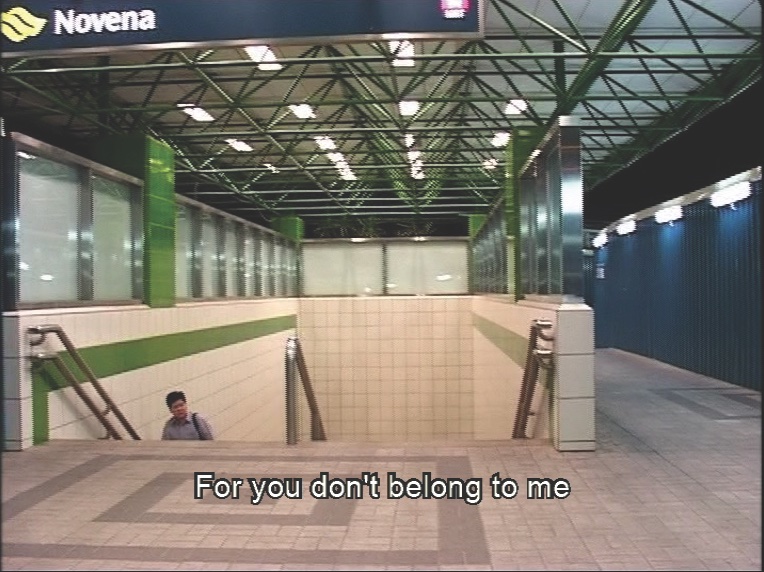
Here is where the city touches us most, where its sounds echo in our bodies, and yet where we are, as Margaret Leng Tan notes, the least aware since “we’re too busy listening to the thoughts in our head.” This is a brief, fragmentary inventory, an echo of other echoes:
Covered Walkway
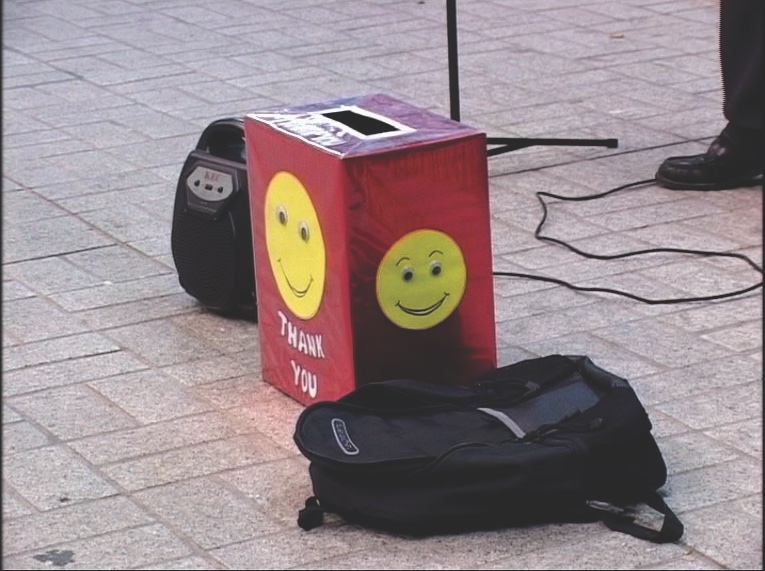
One of Singapore GaGa’s most deliberate cuts—the one that shows an authorial hand immediately in this documentary—is the fade from an audio track of exploding fireworks—the most obvious symbol of patriotism and success in Singapore to the opening chords of the song “Wasted Days and Wasted Nights” performed by the busker Melvyn Cedello. The boom and echo of fireworks, perhaps a little more tinny and canned on screen than in real life, is an annual occurrence in Singapore, and is in fact something that most of us only experience on television. Yet, Tan plays with a deeply ingrained association between fireworks and patriotism in the Singapore psyche, with all its childhood inculcation of national songs, echoing unbidden in our heads. What is everyday life in Singapore however, is but emerging from an MRT2 station into a temporarily covered walkway to come across a busker who is being studiously ignored by all the passers-by. The walkway is a liminal space of transition which makes Tan’s cut to the interior of a plane landing in Singapore all the more logical. They are both places we all pass through, their enclosures echoing with emotion, their time limited and fleeting. The fact that the walkway is boarded off for further construction by sheet metal also highlights the instability of this space, its limits oddly defined by Cedello’s echoey song. His song is makes us realise that even this non-space, this abstract space, is actually a space of potential, of sociality, of the city.
Underpass
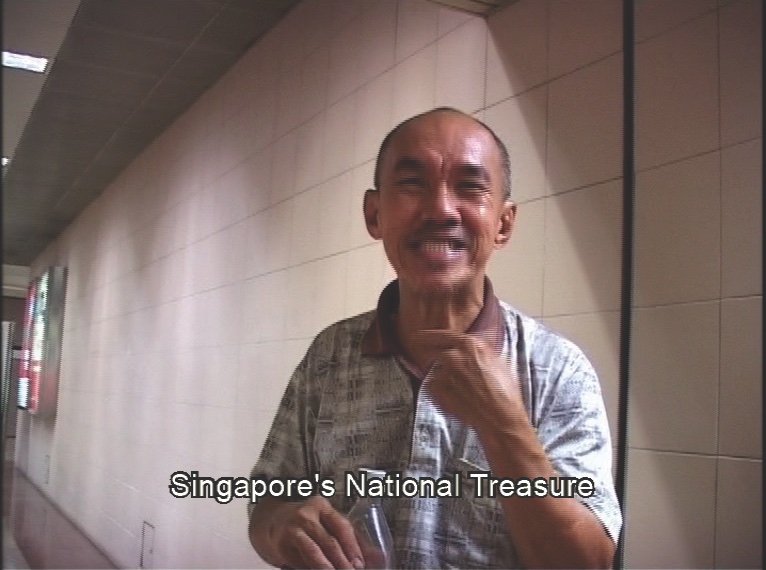
The indifference that greets Cedello is the same one that the busker Gn Kok Lin faces—and in these scenes, in what looks like a downtown underpass just outside a train station, Tan is careful to show the low, claustrophobic ceilings and the closed circuit-camera that seem to pin the people down as they walk rapidly to their various destinations, oblivious to Gn’s enthusiastic performances. His use of the harmonica and popular tunes pierces through the white noise of footsteps and the murmur of the crowd.
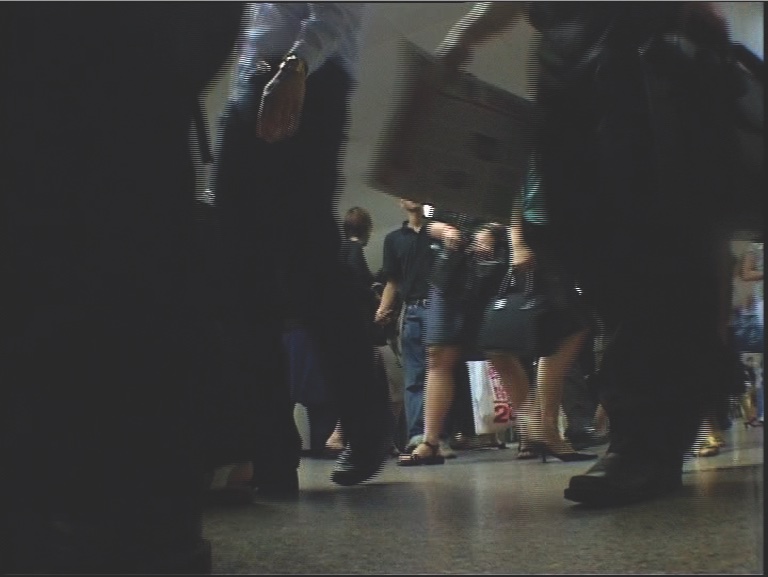
Tan’s increasingly rapid jump cuts in this scene turn the ordinary into a rhythmic symphony, one that is cut short by the intervention of an SMRT official—a reminder that public space or a commons has to be actively sought out and created in Singapore. But how can one miss something that has not been there for so long?
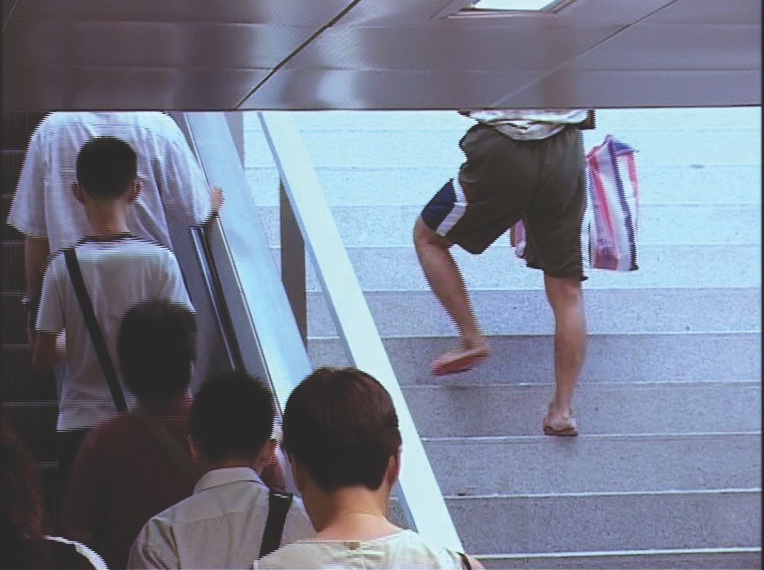
Tan’s film here takes the everyday aural experience of footsteps, the diegetic music of the busker and transforms another anonymous space into one resonant with life and meaning: a subterranean tunnel suddenly awash with the carnivalesque.
Void Deck
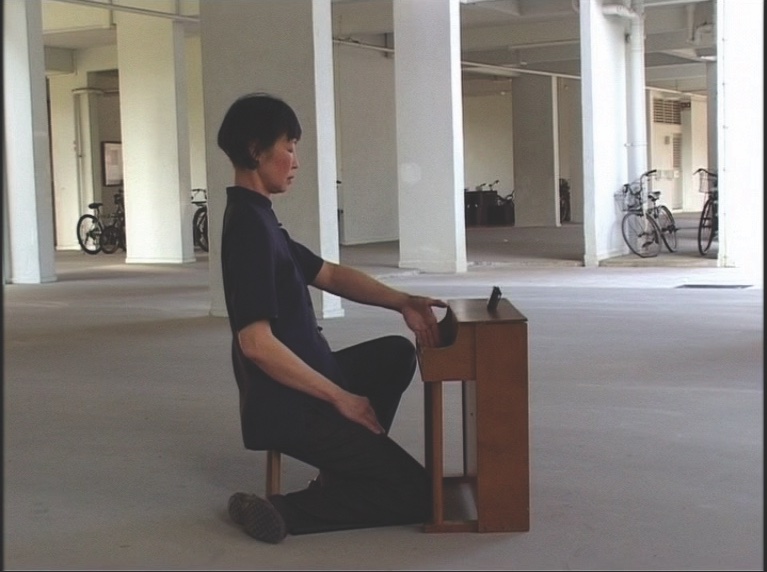
The scene of avant-garde pianist Margaret Leng Tan playing her toy piano in an Ang Mo Kio void deck3 is perhaps the only “staged” scene in Singapore GaGa. In a sense, this makes it the heart of Tan’s film and crucially, a moment of fictionality in what is ostensibly a non-fictional documentary. Having a celebrated experimental pianist set up a toy piano in the void deck of a public housing flat and proceed to perform John Cage’s notorious 4’33” becomes, arguably, a moment where the fantastical encroaches onto the everyday. And the pianist’s choice of music, or rather performative silence, works almost in the genre of magical realism, where the quotidian sounds of the most ubiquitous space in Singapore are amplified and rendered disproportionately significant through the sheer doggedness of our collective focus. This scene turns up the volume of silence; it reveals the minuscule complexities of space produced by the sounds of the environment, what Margaret Leng Tan later calls the “music of the environment.” This moment of fantasy is inherently and intensely participatory in nature. Much of Singapore GaGa invites us to listen to the city’s echoes, but it is in this heart of the movie where we are almost forced or aggressed into doing so. Part of this is of course due to the nature of Cage’s work: 4’33” is a rather difficult 4 minutes and 33 seconds of arbitrary silence—Margaret Leng Tan recounts, in the film, how her first performance of the piece in Singapore, led to an audience member angrily storming out, which she says “was just perfect!” Yet, Tan’s film adds another meta-layer to this, as audiences are expected to sit through a single unwavering shot frame of performer and piano, letting our own minds turn up the volume of the background noise in the scene: the shuffle of feet, the cries of birds, the rustle of leaves, the chatter of inhabitants in and outside the frame. We are called to, indeed coerced into becoming fully aware of this filmic space, through the very bodily experience of sound.
Street/Taxi/Radio
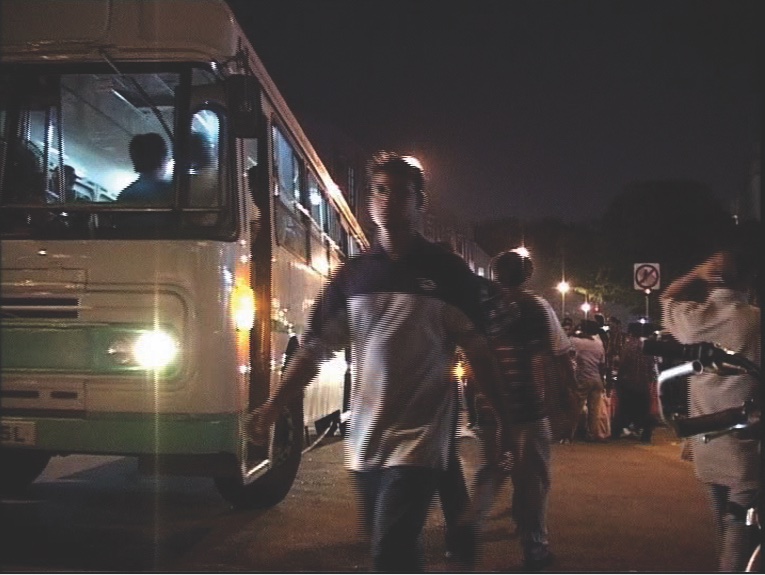
But of course, this moment of singular focus is a moment of fancy—much more in keeping with the rhythms of the city is Tan’s layering of multilingual textures in one of the film’s most complex transitions. It begins with a simple tracking shot of Serangoon Road in Little India where scores of migrant workers are milling about. The sound that cuts above all of the bustle comes from a bus attendant shouting into her loud hailer—her repetitive call of “Kaki Bukit! Kaki Bukit!” while literally naming the destination of her buses also reflects the complex geography of migrant labour as it crisscrosses the island. These echoes illuminate how transnational flows of labour redefine these spaces. But not content with one view, the film reveals that the camera’s perspective comes from inside a taxi.
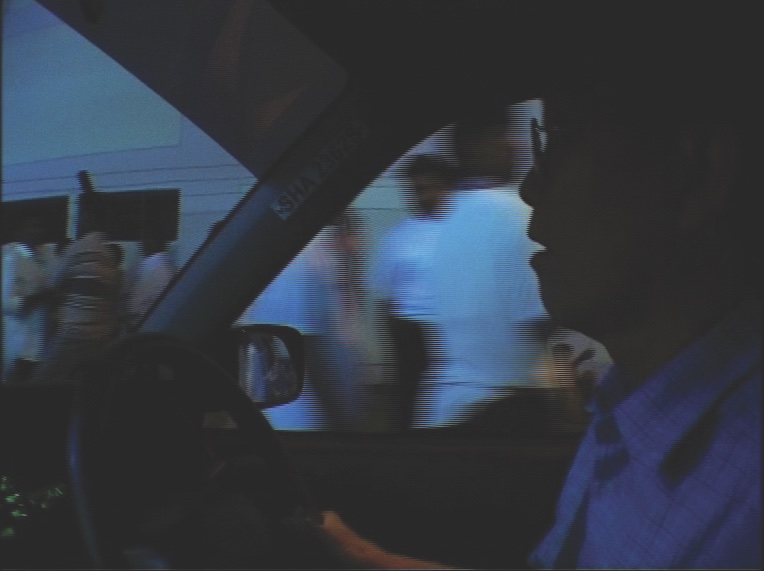
The sound in this segment then abruptly switches to the cocoon-like atmosphere in the taxi: the low hum of the engine and air-conditioning coupled with the deeply nostalgic sounds of a news bulletin in a Chinese dialect. In this scene, Tan offers a distillation of Singapore space; her artistic gesture renders the moment uncanny and highlights the multiple layers of soundscapes in the city, which in turn reference a space at the crossroads of many Asian cultures, histories and classes. This is a complex spatio-temporality—and Tan’s distillation of this single moment, jolt us back into a recognition of the heterogeneity of our spaces.
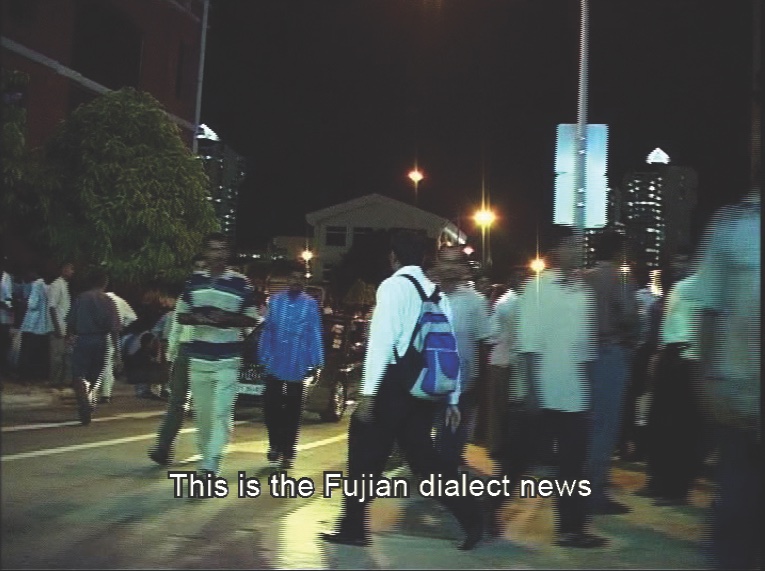
The film’s transition here to the air-tight, sound-proof space of the radio studio is particularly fascinating; the studio broadcasting the Chinese dialect bulletins is a distinctly heterotopic space and one that carries the burden of so many alternate voices and histories. In a sound-proof studio, there are no echoes—yet the voices of these old tongues continue to echo all over the island, as evidenced by their presence in moving taxis. These voices, available for a limited, contained time and space each day, bring to mind a plethora of lost stories, voices of grandparents, babysitters—languages suddenly given a brief flash of recognition when used in official tones for news: economic reports, stories of crime or government policy. One becomes aware of how these are not just languages of transaction, intimacy or the familial—they are also rich with possibility and technical detail. They have the ability to be in fact, both private and public—rendering a misguided debate over a “mother tongue” moot.
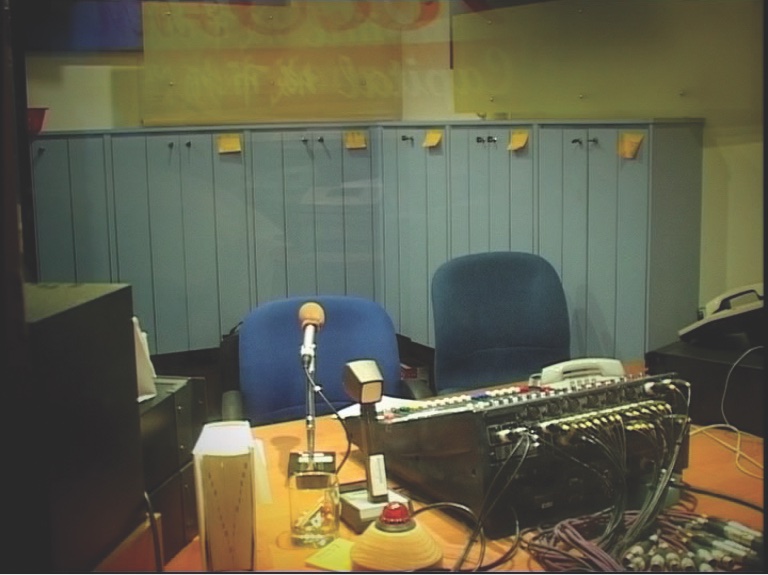
Watching and Re-watching
For me, the twin emotions that are evoked and re-evoked in my watching and re-watching of Singapore GaGa are discovery and loss, uncovering and then losing these already disappearing sounds. Are these echoes more or less than their original sources? In any case, their immortality is ensured by their place in Tan’s work, their deliberately associative meandering defying any attempt at a grand national narrative. The film begins and ends with the National Day Parade and the busker Melvyn Cedello’s rendition of “Wasted Days and Wasted Nights,” a looping echo of the film’s echoes. In the covered walkway, passers-by seem more taken by Tan’s camera than Cedello’s music; counter-intuitively Singapore GaGa nudges us ever so gently to pay more attention to the latter—the source of the recording, not the method or recording itself. Is this at all possible? We are left only with an echo, an echo that changes with us as we listen to it over and over again.
Footnotes
1 A local Singapore term, with origins in Malay, meaning rural, out-of-the-way.
2 MRT: Mass Rapid Transport System.
3 Void Decks are empty first floor voids beneath high-rise public housing blocks of flats.
References
Scott, J. (2001). “Fantasy Echo: History and the Construction of Identity.” Critical Inquiry, 27.2, pp. 284-304.
Tan P. P. (2005). Singapore GaGa. Singapore: Objectifs Film, DVD.
Tan, S. E. (2006) Lost Roads: Singapore. Singapore: SNP Editions.
Essays
In critical discourses on post-Cold War world cinema, there is no term that has become more influential than the term transnational. The phrase ‘from national to transnational’ is now considered one of the best phrases to epitomise the change in the landscape of world cinema over the past two decades. But at this moment, when people are beginning to doubt the celebratory attitude toward transnationalism in the wake of global recession, we need to reassess the phrase to find if there is any missing link or any ‘vanishing mediator’ that we have neglected between this transition from national to transnational. This paper proposes the buried term ‘postnational’ as this vanishing mediator in order to theorise how this term enables us to understand the way in which contemporary world cinema can engage in our imagination of new communities characterized by alterity, openness, and incommensurability rather than by homogeneity, stability, and exclusion. To illustrate the potential of cinema for opening up ways to imagine such postnational communities, this paper closely examines Flight of the Red Balloon (2007) directed by Hou Hsiao-hsien, focusing on how the aesthetics of the spectral is crucial to such an imagination. It should be noted that the film appears characterised as transnational in terms of both its contexts of production, circulation and reception, and its textual elements. My close reading of the film reveals, however, that the transnational approach to the film risks overlooking its other potentials in relation to our imagination of a postnational community.
The Postnational: Bare Life as Form-of-Life
Over the past decade, an increasing number of studies on world cinema have demonstrated how border-crossing movements in terms of production, circulation and reception are crucial to understanding world cinema, especially world cinema in the post-Cold War era. Indeed, this tendency of study complicates the understanding of the nation and national cinema, highlighting how national culture in general and the national cinema in particular can no longer be rigid or pure since they have increasingly been informed by border-crossing cultural flows including multinational co-productions, transnational remakes, and transnational stardom. Moreover, as opposed to the emphasis on the national, which has often been critiqued as homogeneous, territorialised or fixed, the emphasis on the transnational draws our attention to new virtues such as mobility, heterogeneity, deterritorialisation and flexibility.
Despite these and other celebratory achievements and possibilities of the transnational perspective, however, I suspect that this perspective does not fully open the way for the potentials overlooked or blocked by the national. Rather, it tends to embrace only the selected potentials that current neoliberal capitalism makes profitable. In other words, it tends to condone the increasing tendency according to which transnational flow is regulated under the global neoliberal governmentality whereby, as Aihwa Ong notes, flexible transnational elites “claim citizenship-like entitlements and benefits, even at the expense of territorialized citizens” whereas “low-skill citizens and migrants […] are constructed as excludable populations.”1 Consequently, the transnational perspective tends to ignore this new kind of wasted lives who are regarded as worthless and thus excluded from national security, but at the same time also excluded from the border-crossing flow because they appear valueless or even harmful from the perspective of transnational capital. These worthless lives include, but are not limited to, so called ‘internally displaced persons’ (IDPs), those who ‘ha[ve] been forced to leave their homes’ as a result of conflict, natural disasters or development projects, but .']‘remain within the borders of their own countries’2 unlike exiles or refugees. But they are not simply exceptions to the rest of us who live ‘normal’ lives, and it should be noted that we are all virtually vulnerable to such abandonment as can be seen in the recent nuclear disaster in Japan. To foreground this limitation inherent to the transnational and to illuminate the excluded potentials, I propose to call attention to the term postnational.
Although it has not been very popular than the term transnational, the term postnational has been deployed in academia by critics such as Arjun Appadurai and Jürgen Habermas to designate emerging political or cultural phenomena or horizons that transcend the national boundary or cut across nation-states with the decline of the nation-state in the post-Cold war era.3 And yet, these previous deployments of the term have some drawbacks, one of which is that as can be seen in Appadurai’s use of the term, the term is often confused with other similar terms such as global or transnational. Another problem that should be noted concerns Habermas’ understanding of the term. He proposes to understand the postnational as a global public sphere in which we can in principle lead to an agreement concerning any global issue through democratising communication beyond particular national interests. What is important to note here is his suggestion that sustaining such a global public sphere requires as a prerequisite constitutional norms or cooperative legislations that are to work at a global level. Hence, the postnational understood this way runs the risk of excluding non-normative phenomena or thoughts from consideration.4
To avoid these pitfalls, I argue, the term postnational not only needs to be redefined in terms of its temporal rather than spatial character, but also it needs to be redeployed so that it can involve any singular possibilities that cannot be captured either by national or by global norms, rules, or laws. My understanding of the term is greatly indebted to Agamben’s discussion of bare life, especially in his book Homo Sacer: Sovereign Power and Bare Life. The postnational, I propose, refers to the very dimension of what Agamben terms ‘bare life’ that emerges in the state of exception or emergency, such as the state of siege, in which state law is suspended. By the term bare life or homo sacer Agamben means ‘life that may be killed but not sacrificed.’5 As this definition indicates, and Agamben also remarks, the quintessential example of bare life is the concentration camp inmate, who resides outside the applicability of state law and thus whose life and death do not have any meaning or value whatsoever. From this perspective, however, bare life seems to be conceived only in negative terms. Indeed, bare life grasped this way, Agamben notes, is not entirely indifferent to state law, but rather maintains a relation of ban or abandonment with state law whereby bare life is implicated in the sphere of state law through its ‘inclusive exclusion.’6 As the “Final Solution” and any other cases of sovereign violence illustrate, then, bare life here could not be said to embody the postnational given that it is still understood to be at the mercy of national sovereignty.
But there is a different aspect of bare life that we need to highlight in order to illuminate the postnational. This positive potential of bare life, Agamben proposes, is no longer implicated within state law through the relation of ban, but rather emerges in ‘non-relation’ to state law. To put it another way, unlike the aspect of bare life captured by state law as its exception, this new aspect of bare life, or ‘form-of-life’ in Agamben’s vocabulary emerges as an indeterminate remnant or excess of the process of being captured by state law.7 In this regard, rather than being deemed meaningless or valueless from state law’s perspective, bare life as form-of-life involves a multiplicity of singularities that exceed state law’s as well as any global law’s processes of signification or valorisation. If the term the postnational means ‘exceeding all the possibilities allowed by the nation-state including an inclusive exclusion by state law,’ it is best theorised as bare life as form-of-life.
Postnational Communities and the Spectral
Although bare life as form-of-life emerges absolutely outside the nation-state, it does not imply that bare lives have no potential to form a community. Rather, it is possible to imagine a radically different, postnational community that consists of bare lives. Immediately after the collapse of the actually existing socialist regimes, critics have proposed alternative notions of community grounded on alterity, incommensurability and openness as opposed to the old notions of community such as the nation-state or the Soviet Union founded on a body of shared features or a common ideal. Agamben, among others, proposes an alternative notion of community grounded not on any specific identity, but on unconditional belonging. He proposes a community of whatever singularities, which ‘has no identity, [which] is not determinate with respect to a concept, but [which is neither] simply indeterminate, rather [which] is determined only through its relation […] to the totality of its possibilities.’8 In other words, as he paraphrases, the community of whatever singularities is ‘mediated not by any condition of belonging, nor by the simple absence of conditions, but by belonging itself.’9 Significantly enough, his notion of community requires as the condition of its possibility a medium by means of which beings acquire a sense of belonging without losing their singularities. The first and foremost point about this notion is that a community is less a collective of identical or similar beings than a collective of singularities that have nothing specific in common. This means that a community has potential for involving within itself something radically other or the absolute outside. In this regard, this notion of community is an answer to the question of how singular beings as bare lives can form a postnational community. Another important point about Agamben’s notion of community is that he implies the role of media in forming such a community. But it is Derrida’s and Stiegler’s ideas about spectrality that provide more precise understanding of the relationship between a medium and a community.
Indeed, Derrida’s theory of spectrality allows us to understand the precise relationship between mediated perception and the community predicated on alterity or incommensurability. It should also be noted that both Derrida and Stiegler highlight the crucial role of photographic/cinematic/electronic media technology in . However, my understanding of postnational community, in as much as it is predicated on incommensurability or alterity, does not contradict his vision of the utopian social bond. And for the ways in which cinematic technology, among others, produces spectral images, see chapter 6 of Akira Mizuta Lippit, Electric Animal: Towards a Rhetoric of Wildlife (Minneapolis: University of Minnesota Press, 2000) and Tom Cohen, Hitchcock’s Cryptonymies, Vol. 1 (Minneapolis: University of Minnesota Press, 2005) and Hitchcock’s Cryptonymies, Vol. 2 (Minneapolis: University of Minnesota Press, 2005).']producing the spectral.10 In fact, the notion that the communicability of the medium is crucial to our imagination of a community is not a new idea. Benedict Anderson already proposed that media technology such as the newspaper and the novel enables one to develop a sense of national community from other people one has never met. As one comes to know about the lives of others through those media, one becomes acquainted with them and develops a sense of commonality between one and others.11 But as Derrida would have put it, one’s experience of others through media does not necessarily lead to one imagining a national community grounded on homogeneity and commensurability, but it opens up the possibility that one might envision a postnational community characterized by incommensurability and alterity. To clarify the difference between these two, I want to call attention to Derrida’s distinction between the spiritual and the spectral. In deconstructing Marx’s German Ideology, Derrida writes:
The production of the ghost, the constitution of the ghost effect is not simply a spiritualisation or even an autonomisation of spirit, idea, or thought, as happens par excellence in Hegelian idealism. No, once this autonomisation is effected, with the corresponding expropriation or alienation, and only then, the ghostly moment comes upon it, adds to it a supplementary dimension, one more simulacrum, alienation, or expropriation […]. Once ideas or thoughts (Gedanke) are detached from their substratum, one engenders some ghost by giving them a body. Not by returning to the living body from which ideas and thoughts have been torn loose, but by incarnating the latter in another artifactual body, a prosthetic body, a ghost of spirit, one might say a ghost of the ghost.12
To sum up what Derrida states, the spirit is an idea that, sublating (i.e. Aufhebung in its Hegelian sense) all the differences or oppositions between bodies, expresses that which is common to all the bodies whereas the spectre refers to a supplemental dimension of alterity added to the spirit through its reincarnation in an artifactual body. To be more precise, as an excess or supplement added to the spirit, the spectre erodes the unification of bodies that the spiritualisation process performs, and thereby enables bodies to feel their irreducible differences from one another. This distinction between the two terms clearly reveals how the mediated perception of others also enables one to develop a sense of postnational community distinct from that of the national community that Anderson discusses. Anderson claims that when media allow one to imagine a national community, such a community is created to substitute for religion in transforming ‘contingency into meaning,’13 that is, a multiplicity of bodies into a unified collective. Imagining a national community should, then, be understood as a spiritualisation process. In contrast, imagining a postnational community should be understood as a spectralisation process. The reason is because a postnational community, as I discussed, is formed by singular beings and this dimension of singularity is created by the spectralisation process.
Imagining Postnational Communities in Flight of the Red Balloon
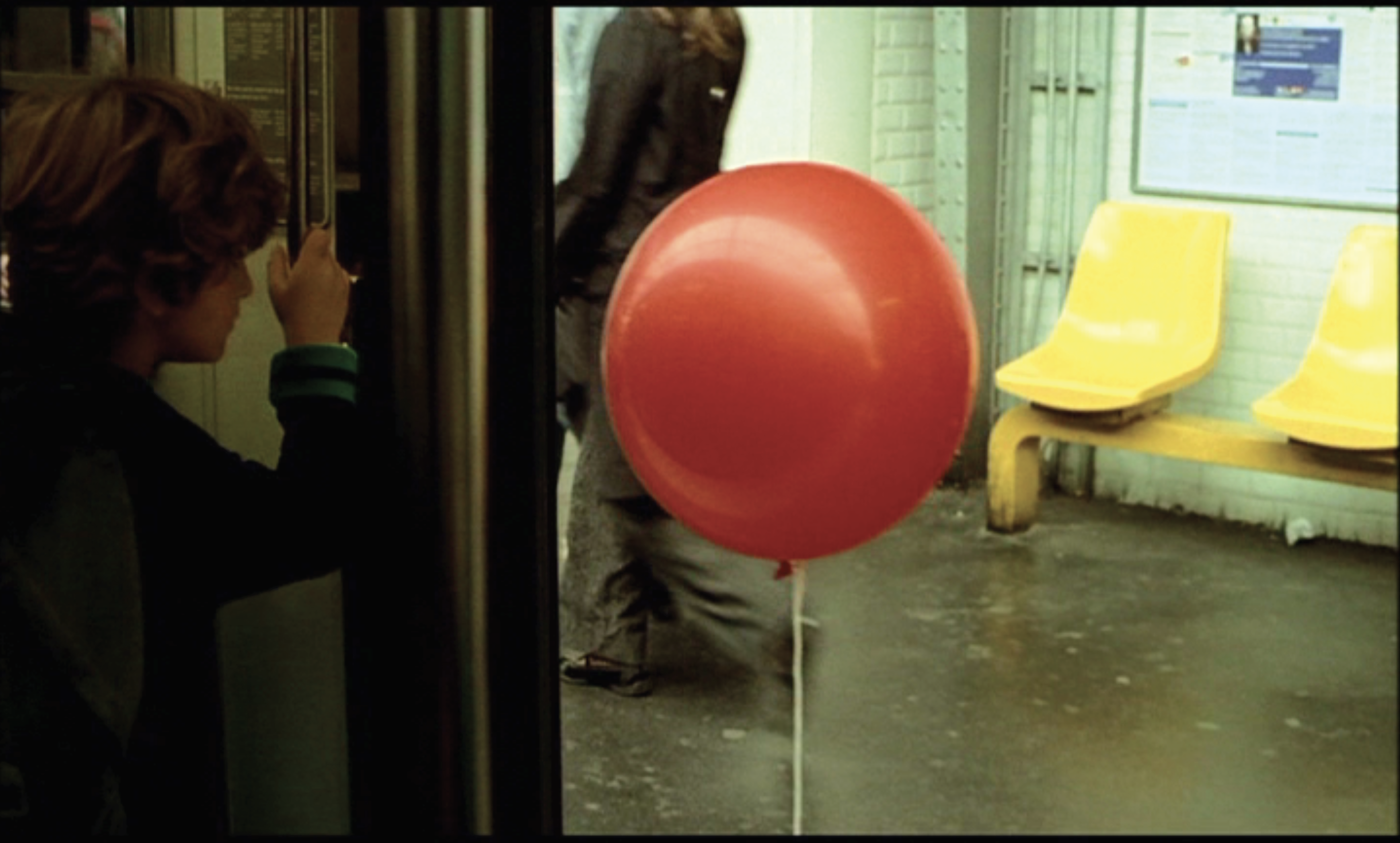
1 Flight of the Red Balloon,
© 3H Productions/ © Margofilms/ © Films du Lendemain
Hou Hsiao-hsien’s films offer us one notable example among contemporary East Asian films that marks the shift from their concern with a national community to that with a postnational community. While Hou began to make so-called ‘national’ films financed by Taiwan national film companies including his own called 3H Productions, later beginning with the film Good Men, Good Women (1995) he transitioned to ‘transnational’ filmmaking involving various European and Asian film companies. During the period of his transnational filmmaking, he has often shot at locations outside of Taiwan such as Mainland China and Japan. The film Flight of the Red Balloon becomes even more significant given that it is his first film that has ever been financed by European film companies and has even been shot in a European location that is Paris. What is even more notable is that the film deals with transnational life as its main subject matter although this kind of life has been included sporadically within his earlier ‘national’ films such as A City of Sadness (1989) and The Puppetmaster (1993).14
As in most of Hou’s films, the storyline of Flight of the Red Balloon is quite simple if one considers only ‘significant’ events at the sacrifice of insignificant details. Song, a Chinese film student, begins to live with a Parisian family as a babysitter for the child, Simon. The latter has lived with his single mother, Suzanne (played by Juliette Binoche), who works dubbing Chinese puppet shows. Song, taking care of Simon, is making a remake of Albert Lamorisse’s 1956 short film The Red Balloon, featuring Simon. Suzanne is having trouble with Marc, her tenant, who does not pay the rent while she waits for her daughter Louise, who lives in Brussels possibly with her father, to return. Last but not least, a strange red balloon floats and sometimes lingers around Simon and Song.
Significantly, the film portrays a Parisian life that is already characterised as transnational in many respects. Indeed, transnational cultural exchanges between China and France appear in the film in a variety of ways: that a Chinese woman works in a French family, that a French woman translates Chinese puppet shows, that a Chinese woman filmmaker makes a remake of a French film (that reflexively refers to Hou’s situation), and so forth.
However, from the perspective of what I have discussed so far, the film is not simply reduced to a multifarious portrayal of transnational life. Indeed, mobilising different types of spectres, the film enables spectators to imagine postnational communities to come. One of the film’s notable visual features is that it often creates doubles of people or objects utilising images reflected in mirrors or windows. It seems normal when both the actual source and its reflected image are simultaneously seen within the frame. But when only reflected images are seen within the frame, this cinematic experience begins to communicate a sense of otherness. For instance, in the scene where Song and Simon are walking in a street, what we see for the first few seconds are only their reflections in a cafe window even though after this short period of time their actual images appear within the frame due to a camera panning. During those few seconds we might get a sense that the reflected images of Song and Simon suddenly look unfamiliar to us even though these images ostensibly resemble their referents outside the frame. This antinomic feeling can be described as the feeling of “uncanniess” (Unheimlichkeit in German) Freud once wrote about, given that he defines the uncanny as “that class of the frightening which leads back to what is known of old and long familiar.”15 This dimension of unfamiliarity within the familiar is also the first and foremost feature of what Derrida terms spectre since as a supplementary dimension added to something, as we discussed, the spectre evokes a sense of alterity. Consequently, during those few seconds we see a spectralisation process emerge because the reflected images add a sense of alterity to the otherwise ordinary perception of Song and Simon. Their spectral doubles enable us to feel as if Song and Simon became endowed with qualities other than what they are, say, qualities other than their national identities. Thus, through this spectral technique, we are given chances to imagine a postnational community of the singularities of Song and Simon over and above chances to see how a transnational relationship between them unfolds.
The film also provides several interesting instances of spectral sound images. Take, for example, the scene in which Suzanne is dubbing a Chinese traditional puppetry into French. During the first few seconds, we hear her vocal dubbing when only the Chinese puppet is within the frame while her visual image is outside the frame. Even though we see her visual image appear in the subsequent shot, during this time we do encounter another instance of spectralisation because it seems as if her voice, temporarily disembodied from her own body, became reincarnated in the puppet’s body, an artifactual body. In Michel Chion’s vocabulary this vocal spectre is an example of ‘acousmêtre.’ Chion defines this term as “a sound that is heard without its cause or source being seen.”16 When a voice becomes an acousmêtre in a film, Chion writes, it acquires a sense of otherness that cannot be attributed to its alleged source, as can be seen in many films such as Norman’s dead mother’s voice in Psycho (Hitchcock, 1960) or the unseen Mabuse’s voice in The Testament of Dr. Mabuse (Lang, 1933). Moreover, in the disjointed juncture of the voice and the body in the scene we are discussing, we not only see a spectralisation of Suzan, but we also bear witness to a spectralisation of the puppet in the sense that the alleged voice of the puppet, disembodied from its body, becomes reincarnated into Suzan’s spectral voice. In this regard, it is a mistake to think simply that the film illustrates a hybrid of Frenchness and Chineseness, or that it exemplifies the cross-border transition from Frenchness to Chineseness or vice versa. Rather, through this double spectralisation, not only does Suzanne potentially acquire a supplemental dimension irreducible to the alleged French national character, but also the puppet undergoes a similar metamorphosis. Hence, it is the postnationalisation process rather than the transnationalisation or multinationalisation process that can best describe the change occurring both to Suzanne and the puppet.
Last but not least, we also need to think about the status of the strange red balloon. Here we should also be very careful not to draw a hasty simple conclusion that the red balloon stands for the transnational exchange between Chineseness and Frenchness given that Flight of the Red Balloon is a transnational (Chinese or Chinese/French) remake of the French film, The Red Balloon. Just as Suzanne’s spectral voice does with respect to the puppet, the red balloon during the process of disembodiment acquires an extra dimension of alterity that cannot be ascribed to a cultural feature of Chineseness or a combination of cultural features of Chineseness and Frenchness. Indeed, the balloon in Hou’s film cannot be thought to have the quasi-anthropomorphic or magical character Lamorisse’s film has, but rather looks ). While their argument is not without pertinence, it does not precisely reflect the key characteristics of the two balloons. Unlike their assessment, the balloon in Lamorisse’s film acts like a human being, thus implying necessity rather than chance whereas the one in Hou’s looks ordinary but also haunted by an extra dimension of alterity.']ordinary.17 But, even though it does not appear to have a purpose or intention, it nonetheless seems to have an unknown extra dimension that cannot be attributed to any positive nature, as can be seen in the scenes in which it attracts Simon’s attention or lingers around him without any explicit reason. Thus, from the Derridian perspective, if Lamorisse’s balloon is understood as a spirit, the one in Hou’s becomes a spectre, obtaining an extra dimension of otherness that cannot be reduced to any positive national character.
However, it is not only in the context of the production of the film that we can see the spectralisation of the red balloon. We can also see how it is spectralised within the film text itself in multiple ways. It is reincarnated, for example, in the one in the painting titled Le ballon by a Swiss painter named Felix Vallotton, in the one painted on the wall of a building on a street in Paris, and in the one appearing in Song’s remake of Lamorisse’s, and so forth. For the audience of the film, these multiple spectralisations not only amplify the visibility of the otherwise barely visible balloon, but also strengthen the feeling of postnational alterity about the balloon that otherwise would embody features of Frenchness, of Chineseness, or a hybrid of features of the two, evoking the national or transnational.
To reiterate, it is this aesthetics of the spectral that enables us to develop a sense of postnational community in the process of watching the film Flight of the Red Balloon. The imagination of national or transnational communities, in contrast, is accomplished through the aesthetics of the spiritual. Obviously, if we see the film through the lens of this aesthetics of the spiritual, we can be given opportunities to imagine a Chinese or a French national community or a Chinese/French transnational community. For instance, if we treat Suzanne and Song simply as representative of Frenchness and Chineseness respectively, we will have a chance to imagine a transnational community that can provide a link between Chineseness and Frenchness. But as we have discussed, once we call attention to a variety of spectral techniques deployed throughout the film, we will also have chances to imagine postnational communities in that we can envision other possible relationships or networks between characters without losing their singularities.
Conclusion: Towards a Postnational Perspective on Cinema
In sum, I proposed the term postnational to call our attention to those wasted lives excluded from both the national security and the transnational flow. As I suggested in my definition of the postnational as bare life as form-of-life, those postnational lives are not exceptional but potentially applicable to anyone or ‘whatever singularities’. In this way, the term postnational involves a new notion of community characterized by alterity, incommensurability and openness, which is radically different from the old notion of national community based on a shared trait or ideal. The second important point I made is that a postnational community can be imagined through the spectrality of media. As I illustrated in a close reading of the film Flight of the Red Balloon, the aesthetics of the spectral in cinema enables us to imagine postnational communities in which we can develop a sense of belonging mediated by a sense of otherness inherent to our encounter with others.
Obviously, the transnational approach to world cinema has contributed much to making visible what has been unthinkable from the national perspective on world cinema. But it is significant to note that the transnational perspective does not fully answer the questions nor fill the voids the national approach to cinema has left behind. The postnational perspective on cinema I propose in this paper is another response to the questions the crisis of the national cinema has opened up.
This chapter has been published in the volume ‘World Cinema and the Visual Arts’, edited by David Gallagher. London: Anthem Press, 2012. ISBN: 9780857284389
Footnotes
1 Aihwa Ong, Neoliberalism as Exception: Mutations in Citizenship and Sovereignty (Durham, NC: Duke University Press, 2006), p. 16.
2 <http://www.idpguidingprinciples.org> [accessed June 25 2011].
3 For Habermas’s and Appadurai’s understandings of the postnational, see chapter 4 of Jürgen Habermas, The Postnational Constellation: Political Essays, trans. by Max Pensky (Cambridge, MA: The MIT Press, 2001) and Arjun Appadurai, Modernity at Large: Cultural Dimensions of Globalization (Minneapolis: University of Minnesota Press, 1996), pp. 164-72.
4 Pheng Cheah pertinently draws our attention to the normative and thus exclusive character of Habermas’ notion of the postnational. See chapter 2 of Pheng Cheah, Inhuman Conditions: On Cosmopolitanism and Human Rights (Cambridge, MA: Harvard University Press, 2006).
5 Giorgio Agamben, Homo Sacer: Sovereign Power and Bare Life (Stanford, CA: Stanford University press, 1998), p. 83.
6 For more details about law’s inclusive exclusion of bare life, see Agamben, Homo Sacer, p. 15-29.
7 For the detailed account of the notion of bare life understood as form-of-life, see Agamben, Homo Sacer, p. 54-62.
8 Agamben, G. (1993). The Coming Community. (Minneapolis: University of Minnesota Press, , 1993), p. 67
9 Ibid., p. 85.
10 Jacques Derrida and Bernard Stiegler, Echographies of Television (Malden: Polity Press, 2002). Derrida is hesitant to use the term community because for him it presuppose commonality, ‘a unity of languages, of cultural, ethnic, or religious horizons’ [ibid, 66]. However, my understanding of postnational community, in as much as it is predicated on incommensurability or alterity, does not contradict his vision of the utopian social bond. And for the ways in which cinematic technology, among others, produces spectral images, see chapter 6 of Akira Mizuta Lippit, Electric Animal: Towards a Rhetoric of Wildlife (Minneapolis: University of Minnesota Press, 2000) and Tom Cohen, Hitchcock’s Cryptonymies, Vol. 1 (Minneapolis: University of Minnesota Press, 2005) and Hitchcock’s Cryptonymies, Vol. 2 (Minneapolis: University of Minnesota Press, 2005).
11 Benedict Anderson, Imagined Communities: Reflections on the Origin and Spread of Nationalism (New York: Verso, 1991).
12 Jacques Derrida, Specters of Marx: the State of the Debt, the Work of Mourning, and the New International (New York: Routledge, 1994), p. 26.
13 Anderson, Imagined Communities, p. 11.
14 Even when Hou addresses the colonial period of Taiwan in his earlier ‘national’ films such as A City of Sadness (1989) and Puppetmaster (1993), he often portrays an innocuous friendship between Taiwanese and Japanese without recourse to any antagonistic or condescending stance. This signals that Hou’s so-called national films had already germs of postnational imaginations that his more recent transnational films are dedicated to.
15 Sigmund Freud, “The Uncanny,” The Standard Edition of the Complete Psychological Works of Sigmund Freud Vol. XVII, trans. and ed. by James Strachey (London: The Hogarth Press, 1957), p. 220.
16 Michel Chion, The Voice in Cinema, trans. by Claudia Gorbman (New York: Columbia University Press, 1999), p. 18.
17 In comparing Lamorisse’s and Hou’s film in terms of the nature of the balloon, Sean Metzger and Olivia Khoo point out that the balloon in the former film is ‘guided by the exigencies of chance” whereas that in the latter is “paced by non-events.’([Sean Metzger and Olivia Khoo, “Introduction,” Futures of Chinese Cinema, ed. by Sean Metzger and Olivia Khoo (Chicago: Intellect, 2009), p. 15]). While their argument is not without pertinence, it does not precisely reflect the key characteristics of the two balloons. Unlike their assessment, the balloon in Lamorisse’s film acts like a human being, thus implying necessity rather than chance whereas the one in Hou’s looks ordinary but also haunted by an extra dimension of alterity.
Essays
On Dying Alone
C. K. was a friend from National Service1. I was a trooper and he was a medic from another platoon in the same company. Even then, I remember having chatted with him on various occasions. Neither of us particularly enjoyed national service, but he had a cheerful disposition, which might have been his coping strategy. After our discharge from the army in 1993, we kept in minimal contact. I learnt that he became an award-winning journalist and an occasional film actor. On November 3, 2012, in The Straits Times, for which he once worked, I read of his death. He had been found dead two evenings earlier on his bed in his single-occupant apartment; a doctor certified that he had died of heart failure. He was 39 years old.
I gagged upon reading about C. K.’s death. Perhaps it was my body’s gut response to the sad and shocking news. He was a peer, a year younger. His diabetic condition reminded me of my mum’s and my own possible affliction of the same. I became aware of my minuteness, mortality and vulnerabilities, especially since I was living alone in my personal studio during the harshest winter ever in Berlin: I could well be in C. K.’s shoes anytime.
Regardless of differences in living conditions and belief systems, most people are afraid of dying. I think there are three main reasons why people fear death. First, they fear the unknown; those who think there is heaven fear what they will get in hell. Second, they fear the pain before death. Third, they fear losing the things they have in this life—the pleasures, the material things, their loved ones. Furthermore, people don’t like dying alone because, as a conclusion to life, dying while having people around you means you have had a well-lived life. Dying knowingly alone means you are weird or you have not lived well. Dying helplessly alone implies some regret in life.
Before learning of C. K.’s death, I was researching into solo passing as a largely academic exercise. Around that time, I was in the midst of preparing for my solo exhibition (entitled Some Detours), which was a requirement as a resident artist at Künstlerhaus Bethanien in Berlin. Aiming to map out the variety and complexity of solitary situations as a way to editorialise my own solitude, I had planned to produce and show three new works: a set of paintings of floor plans referring to solitary spaces, from the series Dwelling; Skeletal Retreat No. 1, a sculpture of the framework of a tree house; and, Corridors No. 1: Solitude, a collection of texts on solitude. For this purpose, I had already started a small archive of news clippings about people who had died alone. The art pieces planned were abstractions of my ongoing research.
C. K.’s passing grounded things in reality. Instinctively, I started expanding and systematising my existing archive of solitary death case studies. With the help of a research assistant, I amassed more news clippings of lone deaths and disappearances and had the information keyed into specific cells on a spreadsheet. It soon dawned on me that another new work had to be made.
The philosopher Gilles Deleuze observes that domestic cats know better than humans how to die: They will slowly walk towards a corner before stopping, then quietly collapsing and passing out for the last time; some even leave their owners’ home, as if wanting their departure to be a private and fuss-free affair. That dying alone seems less an issue for cats than it is for humans led me to wonder: Did C. K. suffer much, or did he die peacefully, or cheerfully even, in his sleep— which is, for some, the most ideal way to go? Did he prefer leaving alone as he did, or with loved ones around? Could C. K.’s lone death be less wretched and terrifying than I had first imagined? Why should C. K.’s death be a matter of concern for the rest of us anyway? I wanted to make a matter-of-fact piece to work through my questions about dying alone. And I wanted it to be as indifferent about dying alone as cats appear to be.
The eventual piece, entitled Gone Solo, is a fourteen-minute video obituary of lone deaths or disappearances. It consisted only of text—no image or sound—collected and selected from the mass media about people who died or were last seen alone.
Of the hundreds of case studies of solo goers in my archive, about forty made it into the work. My selection was based on diversity: a variety of age groups, ethnic backgrounds, places and time periods of death, occupations and contexts was as important as a mix of famous names and unknown ones. I initialised the first names as I did not want the obviousness of the deceased’s gender to hinder viewers’ identification. Each case study appears through a two-step fade-in: First the deceased’s name, age and profession (or social category) appear at the centre of the otherwise black screen. Then the cause and place of death follow below, if not the context of the discovery of his or her body or body parts. The order of appearance, alphabetical by first names, is aimed at conjuring the most startling juxtapositions.
Quite a few featured cases involved a time lag between death and discovery. This often happened to people who lived alone (such as Y. Vickers, a former Playboy model, who was found in 2011, a year after dying at home), or those involved in unfortunate situations like murders (R. Boyd) and suicides (fashion designer A. McQueen).
Not all the deaths were necessarily painful and long-drawn. D. Carradine, an actor and martial artist, was found dead in a hotel room in Bangkok of autoerotic asphyxiation.
The situation-specific deaths were especially poignant. The bookseller C. W. Law was crushed to death in 2008 by falling books in his stock room in Hong Kong, giving a most ironic twist to the common wish to die in the company of one’s loved ones. Or consider A. Hugeuenard, whose life work was in nature conservation and who died a day after a fatal bear attack in a national park in the USA. G. Park passed away in his prison cell, as did many of his fellow convicted murderers.
After reading a few cases, as I have observed, the viewer will get into the rhythm and start making calculated guesses and precise recollections of how each person had died. At times, they are correct, especially for famous cases like B. J. Ader’s disappearance at sea on a lone sailing trip between Massachusetts and Ireland. Most of the cases, however, throw viewers off their expectations. These include those bordering on the bizarre: Pope J. Paul I, who died seated upright, must be one such case, as is A. E. Lim, who was found dead on the wires of a generator. Sometimes, no body was found. Only two pieces of bones of S. Fossett, a businessperson and aviator, were found a year after he was reported missing on a lone flight. There are even cases where the lone death occurred in the busiest of public spaces: Architect L. Kahn was found three days after dying of heart attack in a toilet in a train station, and an unnamed lone traveller was discovered dead sitting among fellow travellers on a bench in a train station.
Gone Solo is not an expression of admiration for or an appeal to sympathise with those who had died alone. It is perhaps more a token of gratitude to those people who had found themselves in situations of solitary departures, whether intentionally or helplessly, gracefully or wretchedly, happily or miserably. They have nothing to teach or tell us. Even if they set out to impart something to us, I doubt we can understand what they have been through. So why am I grateful? I thank these soloists, reclusive leavers and vanishing acts for rehearsing on our behalf the end of our own meagre lives.
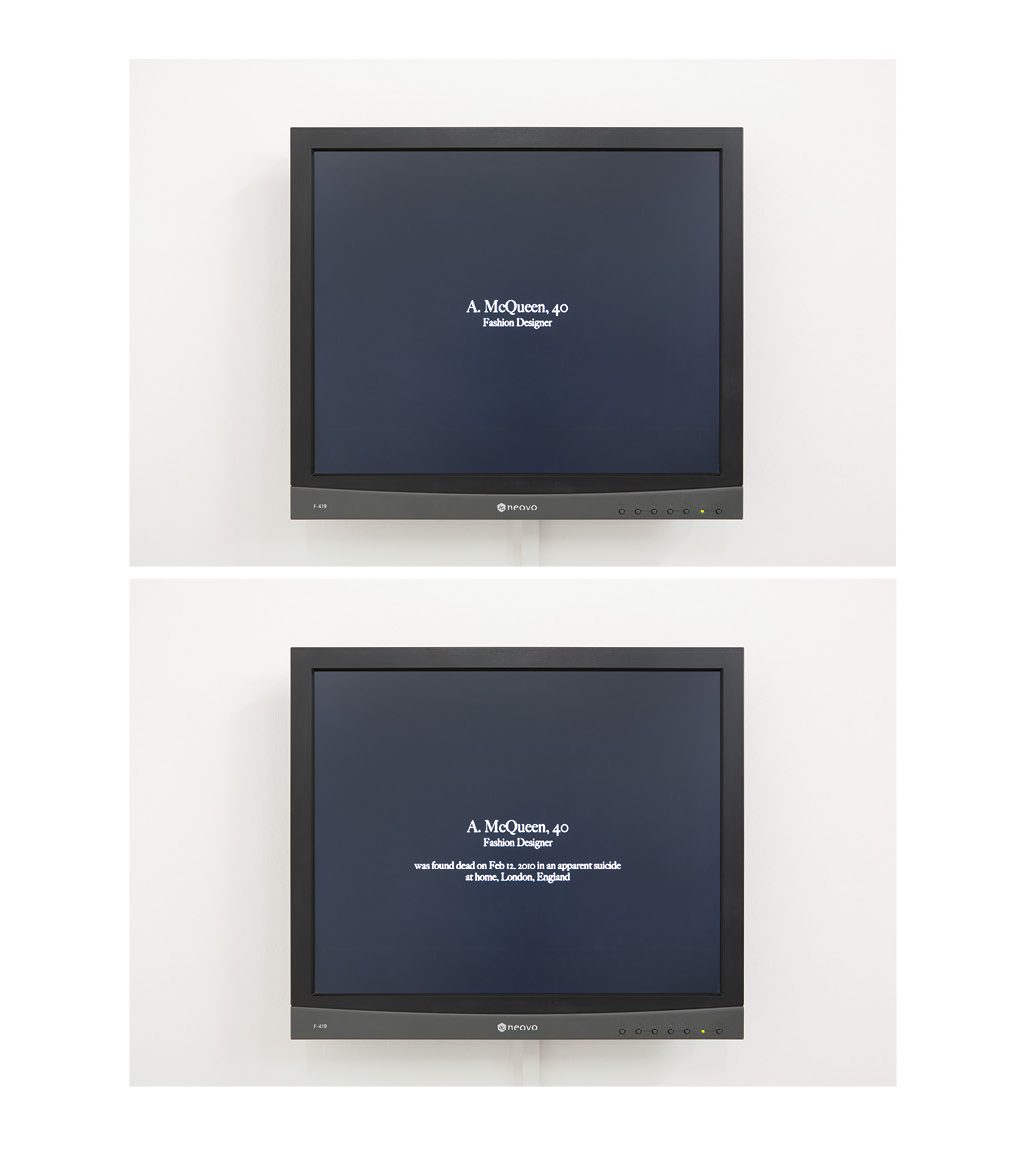
Michael Lee
Gone Solo (14 of 90 video stills)
Digital Video – 14min
2013
Edition of 6 + 2 AP
Photo: Ute Klein
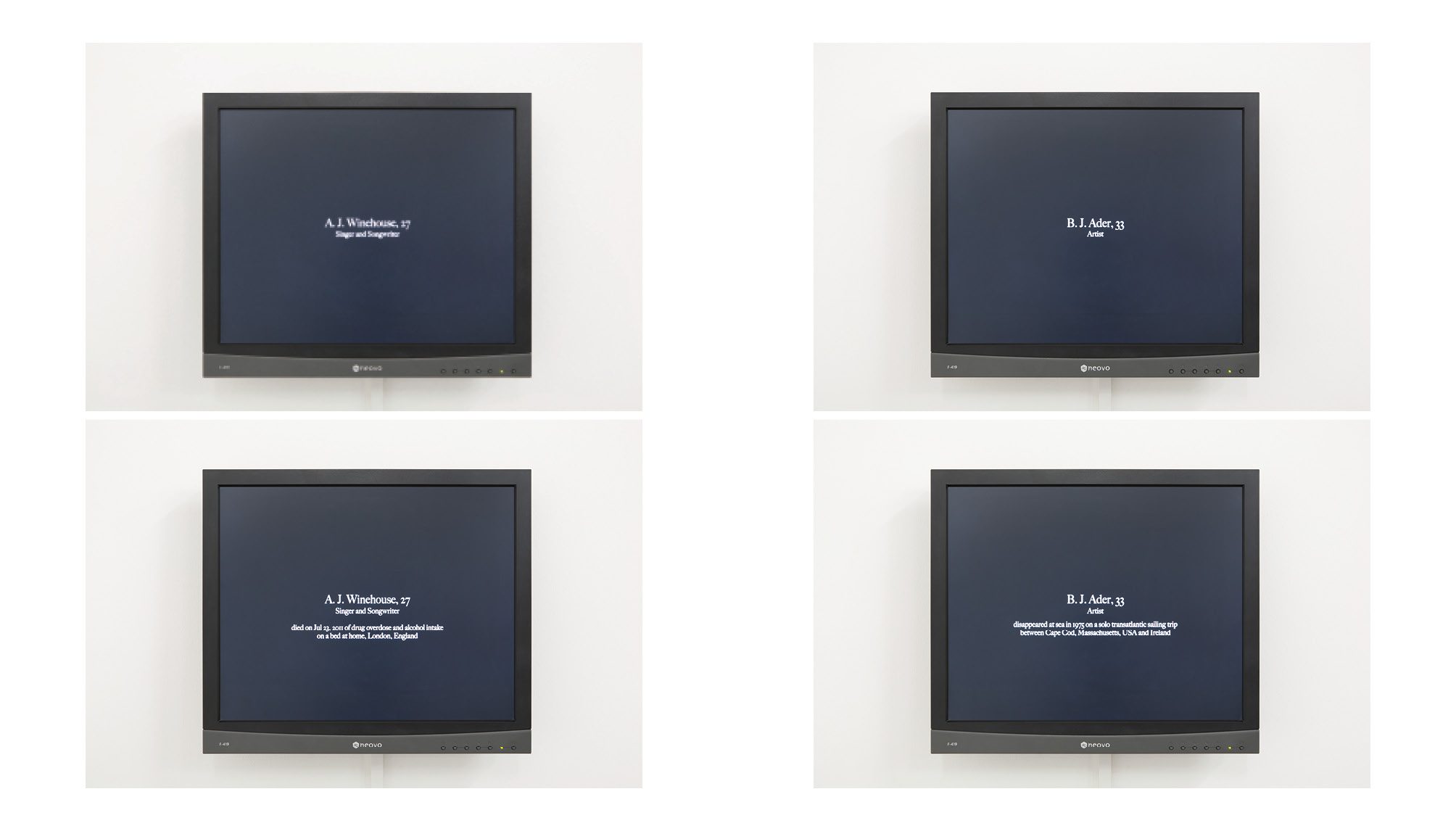
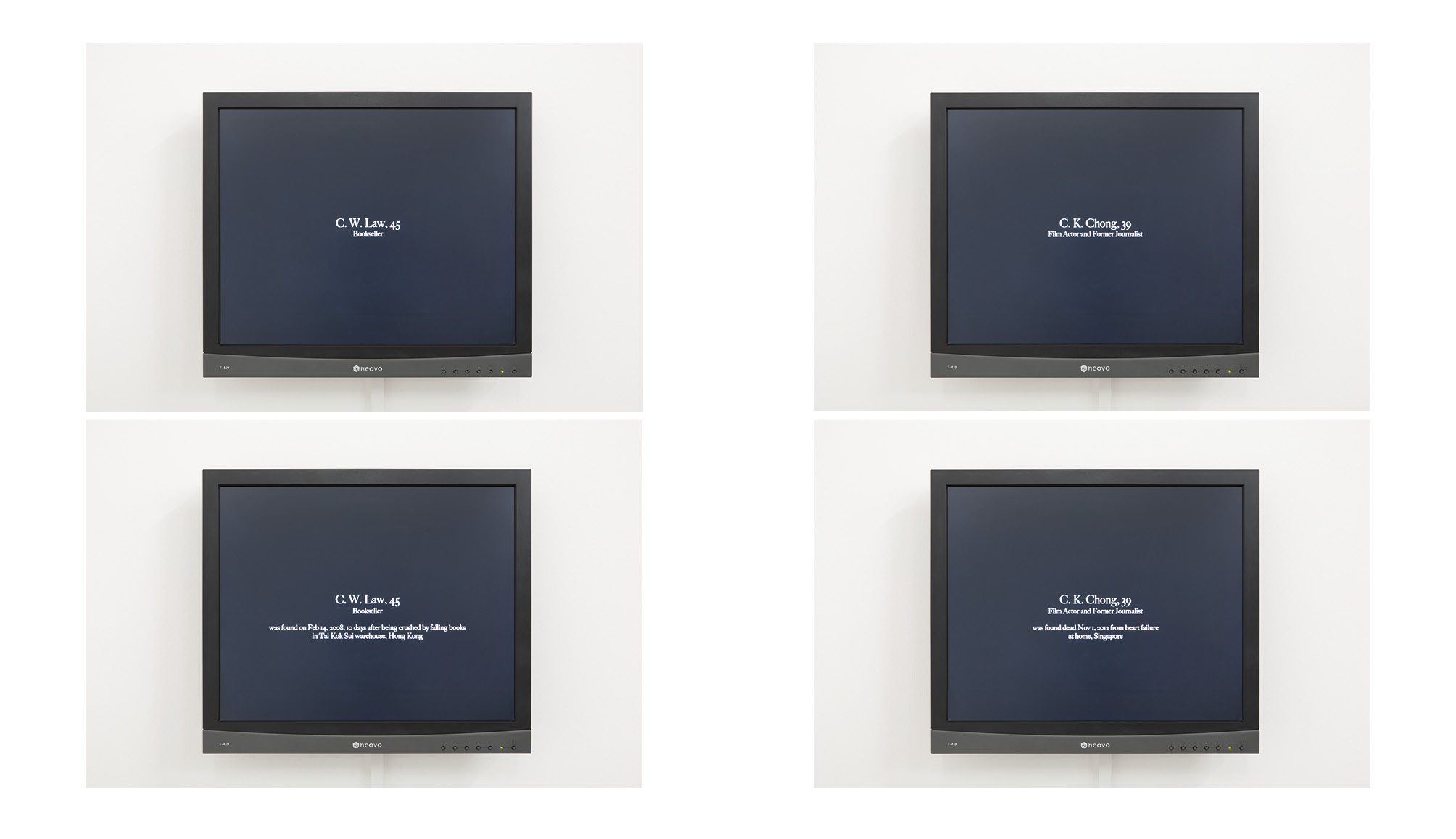
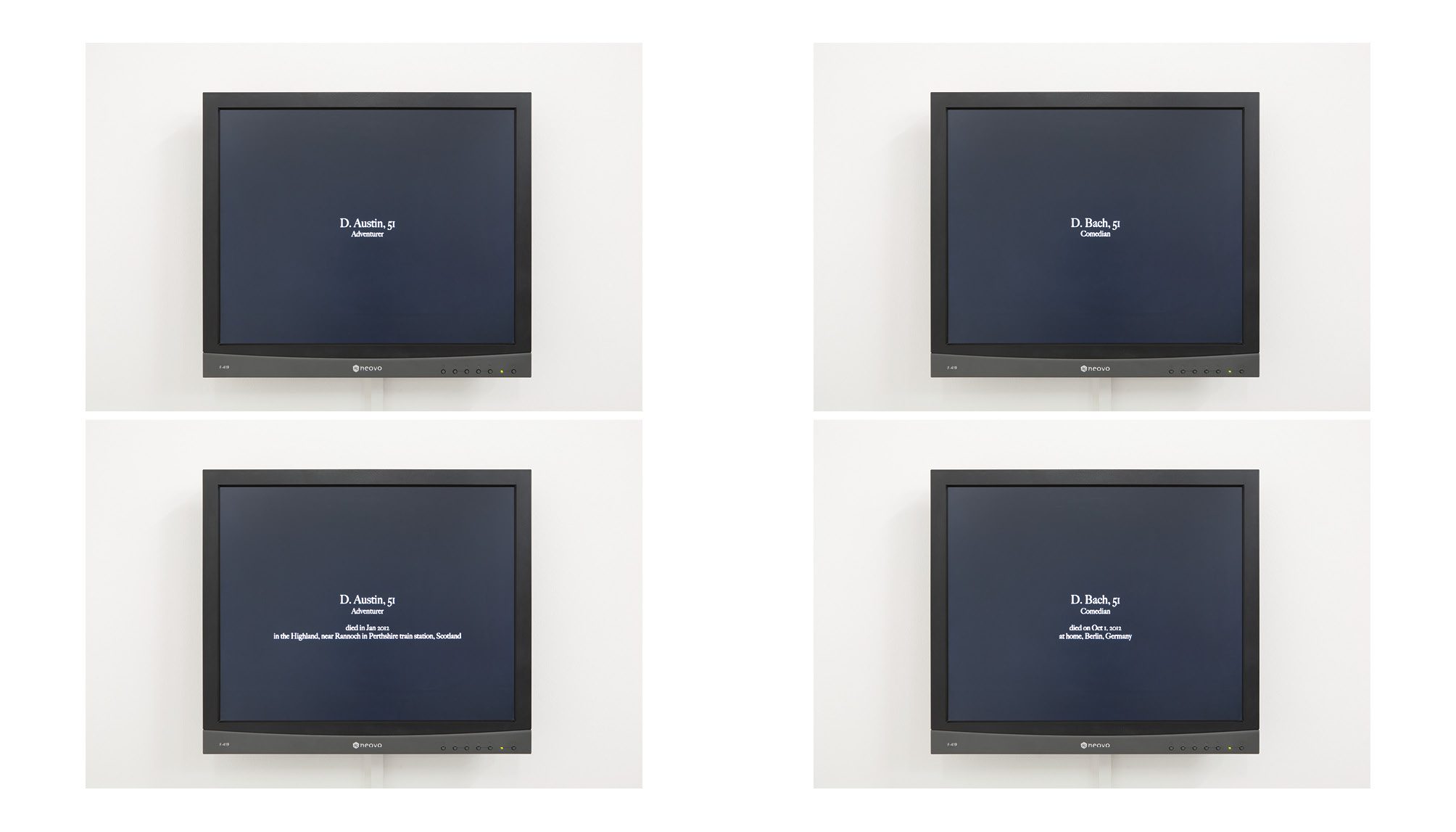
Exhibition
Gone Solo was exhibited at Some Detours Künstlerhaus Bethanien, Berlin, Germany 2013.
Footnotes
1 National Service refers to service in the Singapore Armed Forces.
Essays
From Plato’s Cave to the Bat Cave
In 1974, American philosopher Thomas Nagel in his critique of materialist theories of the mind asked: “What is it like to be a Bat?”1 In his paper, he argues that within the conscious mind is a subjective mechanism that allows us to formulate the “what would it be like to be” interrogative construction that cannot be explained only through the examination of electrical impulses and the physiology of the brain alone. While Nagel’s focus remains primarily on consciousness, as with other philosophers from Adorno to Sloterdijk, as an internal conversation with oneself, I’d like to only use this formulation as a lead-in to another question: the relation of resonance and space, and ultimately an investigation of the echo as a speculative probe into our understanding of reality as it is mediated through art, culture and technology.
Plato argued in his famous allegory of the cave that we are deceived by our own senses having mistaken the projected shadows on the wall for reality. Indeed if there were bats in that cave, might their sonic experience be different from a visual one? By emitting frequencies and detecting their echo, bats are able to sense physical space and would certainly detect the actual and miss the shadow entirely.
It has also been documented that certain humans, not unlike the comic hero Daredevil, have been able to develop sonar-like abilities known as Human Echolocation. Research existing since the 1950s records demonstrations where the trained blind are able to emit a clicking pulse from within the mouth while their ears detect echoes that judge not only proximity, but in cases the shape and density of nearby objects. In one documentary, an echo-locator walks down a street pointing out types of buildings and with amazing precision correctly distinguishing waste bins from parked cars. In another scenario, through echolocation the blind are able to navigate complex riding trails on mountain bikes. Human vision and hearing both rely on the detection of waves of energy and in the last century we have been able to exploit this similarity swapping the properties of one for the other. Sound and resonance-based technologies have given us at least two familiar staples of modern medical imaging equipment: ultrasound (ultrasonography) and magnetic resonance imaging (MRI). A particular flavour of resonance imaging is the EPI (Echo-Planar Imaging) which has been used as a diagnostic tool in understanding epilepsy, a condition suffered by artist Kurt Schwitters.
The worst epileptic seizures, formerly known as Grand Mal (the great bad) seizures, are currently referred to as Tonic Clonic seizures, the name itself nearly an echo. Whereas the electronic impulses between the two hemispheres in the brain normally are out of sync, epileptic seizures often occur as a result of synchronicity, or, with a slight stretch of the imagination, in the absence of an echo.
Architectures have been designed throughout history for both the amplification and the elimination of echo. Those built to enhance or prolong are referred to as echo chambers while those designed to reduce resonance are referred to anechoic. With regard to the design of contemporary anechoic spaces, flat hard surfaces are replaced by soft materials with deep crevices to absorb and trap the sound vibrations. Everyday anechoic spaces include recording studios with walls and ceilings that resemble early avant-garde sculpture and installations not unlike Schwitter’s own Merzbau.

1 Kurt Schwitters. The Merzbau (1933).
A precursor to the anechoic chamber
or the externalisation of the epileptic brain?

2 F.T Marinetti cover of Zang Tumb Tumb (1914).
Another form of sonography: from sound to image. Public Domain.
Strangely enough, electric guitarists can be found in these anechoic spaces geared up with a myriad of pedals designed specifically for echoes and delay effects. Prior to the invention of analog and digital effects, artists simply had to simulate echoes, often with only their own bodies. Among Schwitter’s contemporaries in the Futurist, Dadaist and Surrealist movements, the echo was often utilised in the sound art and poetry performances, notably in both the graphic design and spoken performance of Filippo Tommaso Marinetti’s Zang Tumb Tumb (1912-1914).
The short-lived Echo magazine (1960) features the hilarious recording of a dialogue between Salvadore Dali and Edward Mulhare where Dali instructs Mulhare in Dalinguistics, echoing the method of distorting the accent, pitch and diction of words similar to Schwitter’s own earlier experiments with his work, Ursonate.2 During this exchange, Mulhare proposes a word which is then Dali-nised to be then echoed by Mulhare.
A condition known as Echolalia is sometimes found among autistic children which involves the automatic and repeated vocalisations of other people. Considered as a normal stage of language development in infants (such as the vocalisation, not the art movement, Da-Da), this normal speech act becomes a medical condition when older children cannot help but repeat whole phrases spoken by others before a short delay in responding further with their intended response. An example of echolalia where the echo of Person 1 is automatic and will always precede Person 2’s own intended speech act:
Person 1: “What would you like to drink?”
Person 2: “What would you like to drink”, followed by a short delay or pause, “I would like some milk please.”
A wonderful account of the wonders of language development can be found in Daniel Heller-Roazen’s book, Echolalias, published by Zone Books, MIT Press.
In the same year as Echo Magazine, the United States released a postage stamp commemorating Project Echo, a balloon satellite that reflected microwave radiation. It was through these satellites and other experiments that we were first able to detect the echoes of radiation created in the earliest moments after the Big Bang (a source of the first order). It might be said indeed the universe and reality nothing more than the echo of that first event.
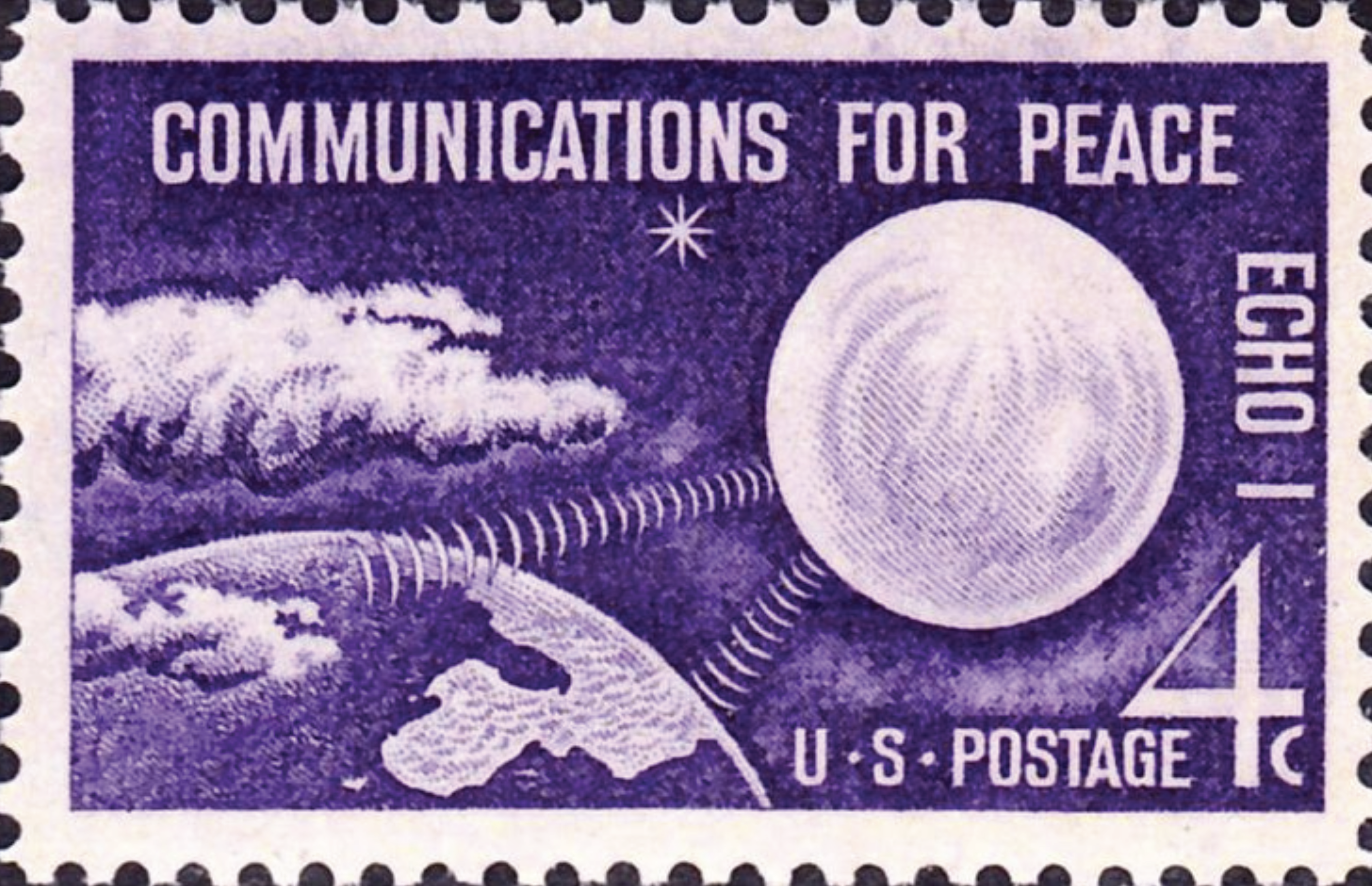
3 U.S. Postal Stamp Echo 1. December 1960. Public Domain.
It has been calculated that within audible frequencies the typical human ear cannot distinguish between an echo and the original sound if the delay is less than 1/15 of a second which is under normative conditions is approximately 11.3 meters apart. While this might not apply to the heightened senses of the human echo-locator, it is remarkable that echolocation might be used for anything within ten metres. Another technique for the physical manipulation of sound is known as phase-cancellation, which is the broadcast of an inverse wave or frequency. Commercial applications include noise-cancellation headphones. Much like its visual counterpart, the mirror which reflects the image in reverse (or in the cases of lenses, upside down), the phase-cancel take the original sound, echoes it back to the source in an inverted form, in effect producing a mute.
If our perception of reality is defined by the detection of energy waves, our future experience may increasingly be mediated by the technological manipulation of image and sound allowing us to simultaneously be both human and bat inside the cave. In other words, a bat-man.
In the 1999 comic version of Bat Man, a character known as Echo3 undergoes a surgical procedure called “The Turing Project” allowing her to read the “minds” of both humans and computers, yet rendering her with incredible migraines.
Footnotes
1 Nagel, Thomas. “What is it like to be a bat?” in Peter Alan Morton. A Historical Introduction to the Philosophy of Mind, Broadview Press, 1997, p. 391ff.
2 Dali, Salvador. Salvador Dali Speaks (1960). Echo Magazine. Recording located at <http://www.ubu.com/sound/dali.html>
3 Greenberger, Robert (2008), “Echo”, in Dougall, Alastair, The DC Comics Encyclopedia, New York: Dorling Kindersley, p. 112.
References
1. Nagel, T. (1997). “What is it like to be a bat?” in Morton, P. A. A Historical Introduction to the Philosophy of Mind, Broadview Press, p. 391.
2. Dali, S. (1960). “Salvador Dali Speaks”, Echo Magazine. <http://www.ubu.com/sound/dali.html>
3. Greenberger, R. (2008). “Echo”, in Dougall, A. The DC Comics Encyclopedia, New York: Dorling Kindersley, p. 112.
4. Hellen-Roazen, I. (2005), ‘Echolalias’; On The Forgetting of Language, New York: Zone Books.
Essays
Echo as a Musical Metaphor
In his book, Music: A Very Short Introduction, Nicolas Cook comments on the relationship between music and metaphor stating:
In its patterns of similarity and difference, divergence and convergence, conflict and resolution, music has a generality that is inevitably distorted by the elaboration of any individual metaphor we use for it. Metaphors focus music. They give a specific expression to its latent qualities. But these latent qualities must in the first place be there in the music, in its patterns of similarity, divergence, and so on; otherwise the metaphor will be entirely unpersuasive. (1998: 121)
In describing the relationship between music and metaphor, Cook highlights the notation of music’s potential for multiple interpretation by commenting that it is actually music’s relationship with words that translate potential meaning in music, commenting that “music is pregnant with meaning; it does not just reflect verbal meaning. But words function, so to speak, as music’s midwife. Words transform latent meaning into actual meaning; they form the link between work and world.” (ibid.) We are bound by words in representing music with meaning.
This paper proposes the metaphor of the echo to represent the transmission process within musical traditions that connects the past with the present. The use of the term ‘transmission’ within a musicological or ethnomusicologist context describes “the passing on of specific bodies of knowledge that underlie many music cultures” (Schippers, 2009: xvi). Transmission is an essential part of any tradition, musical or otherwise. Aubert (2007: 16) states that tradition “defines a transmission process, a chain joining the past to the present, as well as that ‘which is transmitted’ (traditum); in other words, it refers to a specific inheritance of a collective phenomenon.” Transmission forms a framework for future cultural, and in this case, musical activity.
The transmission process is a necessary constituent in the relationship between music and tradition—one which has been a much debated theme in musicology and ethnomusicology. It is a relationship that is more often ‘understood’, remaining difficult to define. Aubert (ibid.) considers that the relationship between music and tradition “is complex, insofar as the term tradition is itself ambivalent.” In much the same way music is transmitted within a tradition, tradition in itself is an experiential phenomenon, making it difficult to determine the parameters that define it. The use of metaphor provides a method to put into words that which is difficult to express.
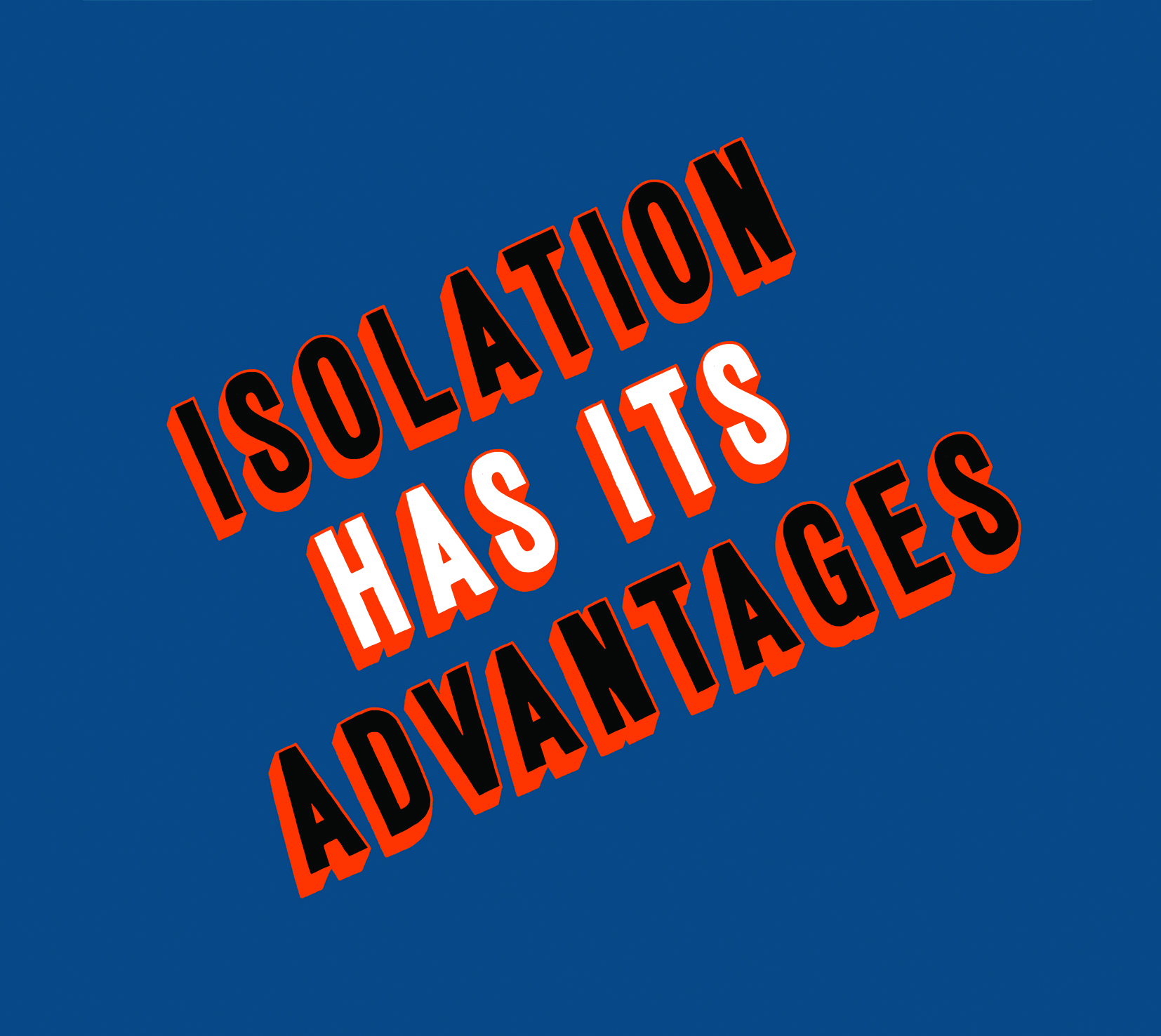
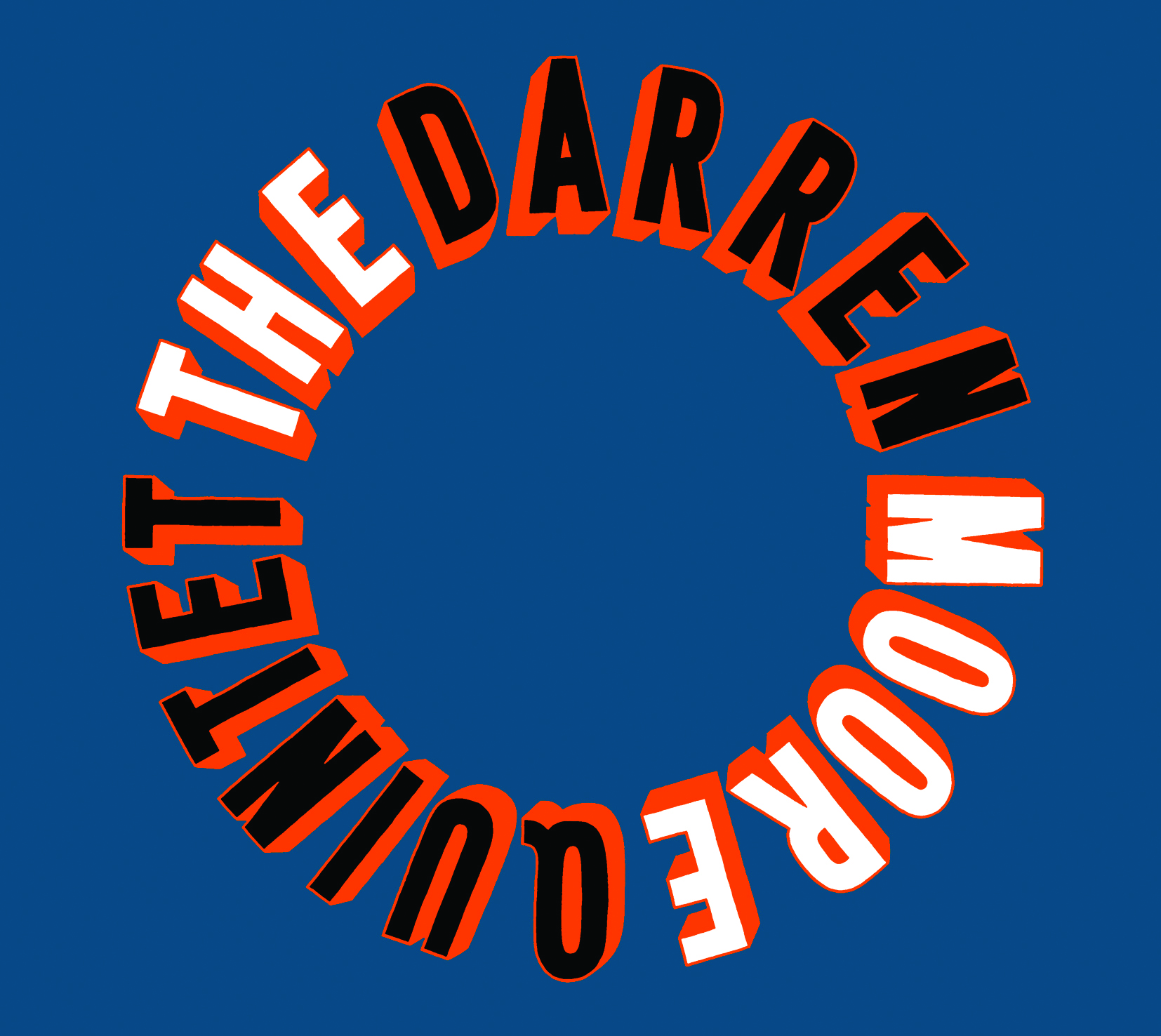
Isolation has its Advantages, backcover, frontcover
Adaptation and Recontextualisation
In a literal sense, an echo is a reflection of sound. It is a repetition, altered from the original source. What we hear is a representation, a copy. The degree that the copy differs from the source is determined by time, distance and medium. The further a sound travels in time, the less it represents the original. Mediums alter the nature of the sound, transforming elements into related but different forms. It can describe both the evolutionary and the devolutionary. My own practice can be seen as an amalgam of musical echoes from various sources—some strong, others faint rumblings. This has always been my aim as a practitioner to incorporate a multiplicity of influences to consolidate a personal syntax and a distinctive voice as a musician.
My recent doctoral work highlighted the transmission process through documenting the learning, adaptation and recontextualisation of new musical elements into an existing musical practice. Specifically, the doctorate centered on the incorporation of rhythmic elements from South Indian Carnatic music into my drum set performance practice framed within contemporary music-making situations, in particular jazz and improvised music forms. Carnatic music contains a highly sophisticated system for the organization of rhythm, Carnatic percussion and scholar Trichy Sankaran states that:

Territorium, frontcover
Many music scholars consider India’s rhythmic system to be the most highly developed in the world, particularly notable for its thorough and logical treatment of movement in time. There is perhaps no parallel to the cohesive way in which rhythms are organised in the Indian musical system as manifested in the art of Karnatak (South Indian Classical) drumming. The elaborate theory and astonishingly complex performance practice of Indian rhythms have become a major area of study for scholars and musicians from the West. (2010: xi)
The focus of the research was to observe the transmission process that occurred through learning Carnatic rhythms and applying them to the drum set. The transmission process was observed over a two-year period through analysing my drum set performances on two albums specifically recorded for the research. The first recording titled Isolation has its Advantages (2009) featured a Singapore-based quintet featuring myself on drum set, Tim O’Dwyer and Greg Lyons on saxophones, Andrew Lim on guitar and Tony Makarome on bass, framing my performance practice within a jazz/improvised music context. The second recording titled Territorium (2011) featured percussion and drum set improvisations between Carnatic percussionist Suresh Vaidyanathan and myself. Territorium framed my playing within a percussion duo setting that brought together drumming techniques from contemporary music styles such as jazz, funk and rock with Carnatic rhythms. The focus on ‘audio-as-research’ placed listening as the central method of transmission, highlighting the significance of the recordings as the primary vehicles to investigate my performance practice.
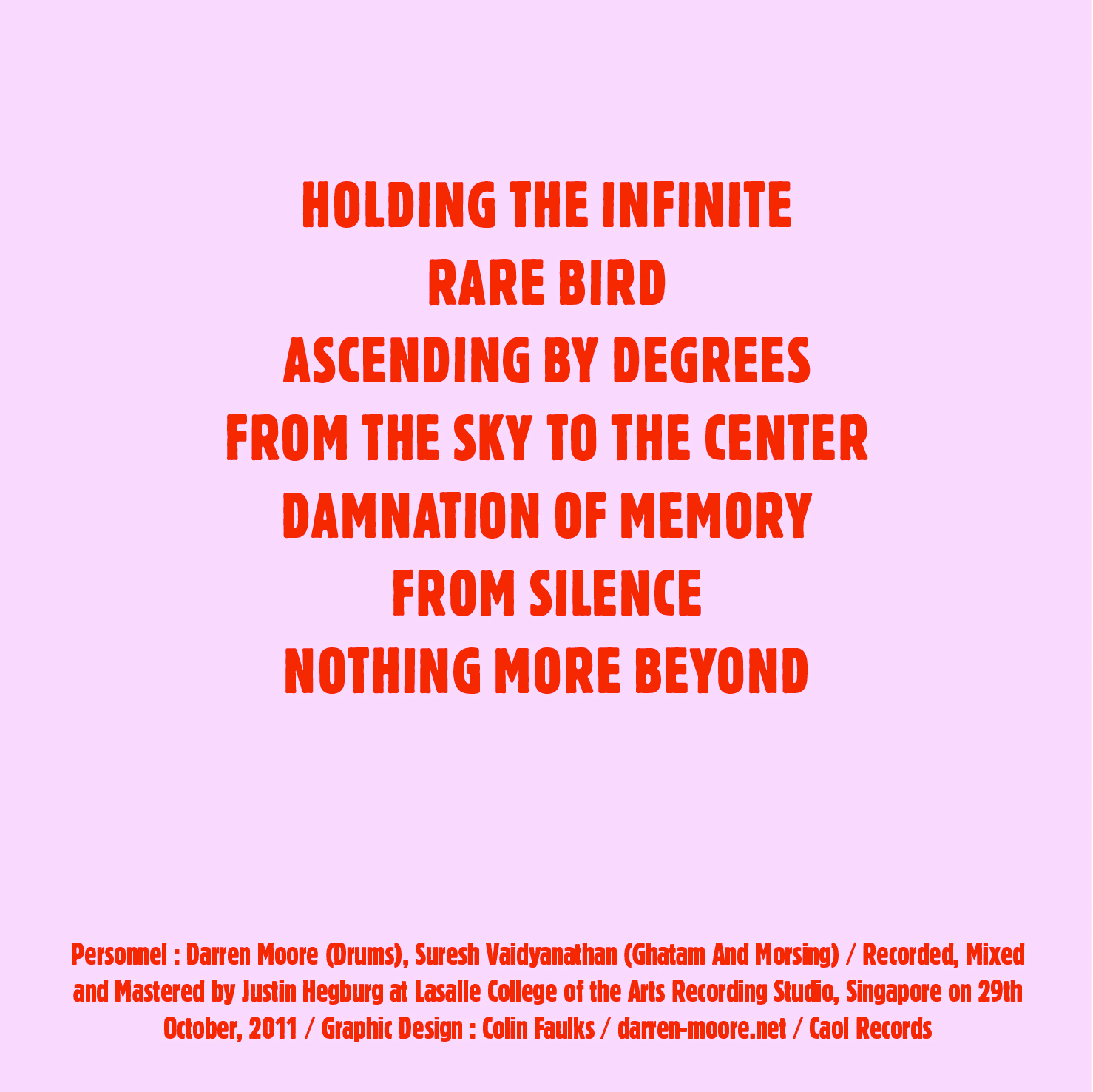
Territorium, backcover
Improvisation
Central to both albums was the element of improvisation, although within two different contexts. Isolation has its Advantages framed the improvisation within jazz style compositions; loosely following a head-solo-head format, which involves the statement of the main theme or melody followed by solos by the members of group on a cyclic form and ending with the reiteration of the main theme. The focus within the ensemble was on playing the set compositions and using elements from the compositions as source material for the improvisations. The compositions were essentially vehicles for improvisation. Each member of the ensemble had a defined role to fulfill that was dictated by the compositional framework. For the drums, this meant being responsible for timekeeping duties whilst conversing rhythmically with the other members of the ensemble.
In contrast, Territorium offered a different playing environment based around improvisation as opposed to a compositional framework. The playing and form of each track was created extemporaneously around a common tempo or textural area. The roles that both I and Vaidyanathan had throughout the recordings were not discussed beforehand, encouraging a high degree of interplay that oscillated between both soloistic and timekeeping functions. The absence of predetermined roles commonly inherent within a compositional framework allowed more freedom as a performer with the result being a rhythmic dialogue built around interaction. Individual tracks evolved by either member proposing an improvisational area at the beginning of the track, which was collectively explored and finally concluded. Each track was held together by common elements, forming a cohesive trajectory. The use of repetition, permutation and development of thematic material was the central method used to create the improvisations. Using the echo metaphor once again, each track is akin to an echo: one that is born, incorporates the influences of the surrounding environment, evolves and eventually subsides.
With improvisation being a common element to both the jazz and Carnatic music tradition, it becomes an important bridge in which the transmission process can occur. Improvisation can be seen as the temporal manifestation of echoes—the real-time, stream of consciousness iteration of the past in the present. In this regard, the drum set playing on the recordings were reactions to what was happening in the present offering a more accurate representation of how Carnatic rhythms had influenced my playing. This is in opposition to playing premeditated rhythmic patterns, which although might be impressive in their design and execution, do not represent the degree of influence the study of Carnatic rhythms has had on my playing. The focus on the extemporaneous creates a framework whereby the manifestation of learnt material could be perceived to flow into conscious insight.
What was interesting about observing this transmission process within my doctoral work was the way that the Carnatic rhythms manifested themselves within my playing. Through transcribing excerpts from both recordings and then codifying rhythmic elements into thematically related material, the analysis revealed a definite influence of Carnatic rhythms on my playing, in particular on Territorium. This occurred as a result of several factors: firstly, I had more time to internalise the Carnatic rhythms learnt during lessons throughout the research period by the time I had recorded Territorium and secondly, playing with a Carnatic music practitioner also led to Carnatic rhythms becoming a common syntax with which we conversed musically.
The echoes of the Carnatic tradition within my playing often manifested altered from their original form as a result of engaging with a different medium (myself) and context. As a general rule, the larger the Carnatic rhythmic element or design, the more probability that it would contrast from its original form within my improvisations. The result is sometimes only an outline of the original form that does not adhere to the rules governing the rhythmic design. The rhythmic vocabulary found in the Carnatic tradition consists of smaller rhythmic cells that are combined to form larger rhythmic designs. The rules governing the Carnatic rhythms serve a similar function to grammar within language, aiding in the comprehension of what is being played and enabling an entry point into the musical conversation.
My method for adapting Carnatic rhythms to the drum set was to use them as rhythmic templates, providing a framework in which the content can be variable. The adaptation of Carnatic rhythms to the drum set opens up the possibility of an almost infinite amount of variations and permutations when combined with different sticking patterns, orchestrations around the drum set and varying contexts. The sum of all of these variables can sometimes lead to the rhythms being unrecognisable from a Carnatic context. As an example, when the Carnatic rhythms are played within a free jazz context, the deconstruction of time and pulse inherent in free jazz recontextualises the rhythms. As rhythms are defined by their relationship to a time cycle (Tala) in Carnatic music, the absence of a time cycle hence transforms the meaning of the rhythm.
Medium
Just like its physical counterpart, the nature of a musical echo will change depending on the medium it is transmitted through. This can refer to the individual as medium or the transmission method as medium. In addition to the master-disciple learning method prevalent in the Carnatic tradition, there are many varied methods of transmitting Carnatic rhythms ranging from sound recordings, books, video recordings, interactive web-based platforms, live streaming and video communications. Due to the Internet it would appear that we are in an age of unsurpassed access to musical materials and methods of learning, but is it effective? Does it supersede the traditional methods of transmission from master to student? Joseph Kerman in his book Contemplating Music comments that:
A music tradition does not maintain its ‘life’ or continuity by means of books or book-learning. It is transmitted at private lessons not so much by words as by body language, and not so much by precept as by example. Only exceptionally is this process broadcast into a semi-public arena, usually in a not very satisfactory form, at master classes where voyeurs and auditeurs strain to catch something of the intercourse between the master and pupil. The arcane sign-gesture-and-grunt system by which professionals communicate about interpretation at rehearsals is even less reducible to words or writing. It is not that there is any lack of thought about performance on the part of the musicians in the central tradition, then. There is a great deal, but it is not thought of a kind that is readily articulated in words. (1985: 196)
Although Contemplating Music was published in 1985 prior to the Internet entering the public domain, the argument put forth highlights the challenges in transmitting musical tradition outside of the traditional master-student method and the importance of immersion and prolonged exposure to the environment in which the tradition exists. It is the elements that cannot be articulated into words that often define the tradition. From my own experience, receiving lessons from master Carnatic percussionists T.R. Sundaresan and Suresh Vaidyanathan proved extremely beneficial to my comprehension of Carnatic rhythms and their application. There are a number of books, DVDs and online material available in this area, but the feedback loop is one-way, and there is no input from an external source guiding one in the accepted methods of the tradition.
Interestingly, Vaidyanathan conducts many lessons online with students from Europe, Japan and Australia from his home in Chennai, India. In addition to online lessons, which resolve the issue of distance, almost all of the students come to study with Vaidyanathan in India to immerse themselves in the culture and tradition of Carnatic music. In particular, many travel to Chennai for the annual ‘music season’ which is a month-long festival of Carnatic (and some Hindustani) classical music in December and January each year. This would suggest that although the web-based lessons are effective, the tradition one-to-one music lesson in the presence of the teacher is still preferred over other methods. Moreover, the immersion in the environment from which the tradition stems is still an important factor in the mastery of the tradition.
In conclusion, the transmission process in musical traditions creates a continuum of practices and belief systems that give birth to an ever-evolving body of musical styles and genres defined by the collective contributions of individual practitioners. In my own work, my interpretation of musical echoes from multifarious sources provides the opportunity for the continued evolution for myself as a musician, which in turn contributes back to the traditions in which I borrow from.
References
Aubert, L., Seeger, A., & Ribeiro, C. (2007). The Music of the Other: New Challenges for Ethnomusicology in a Global Age. Aldershot, England; Burlington, VT: Ashgate.
Beard, D. G. (2005). Musicology: The Key Concepts. London: Routledge.
Cook, N. (1998). Music: A Very Short Introduction. London: Oxford University Press.
Kerman, J. (1985). Contemplating Music: Challenges to Musicology. Cambridge, Massachusetts: Harvard University Press.
Moore, D. (2013). The Adaptation of Indian Carnatic Rhythmic Structures and Improvisation Methods into Drum Set Language and Performance Practice. Unpublished manuscript, Queensland Conservatorium, Griffith University, Brisbane, Australia.
Moore, D. (2009). Isolation has its Advantages [Audio CD]. Singapore: Caol Records
Moore, D. (2011). The Devil’s Tattoo [Audio CD]. Singapore: Caol Records.
Sankaran, T. (2010). The Art of Konnokol (Solkattu): Spoken Rhythms of South Indian Music. Toronto: Lalith Publishers.
Schippers, H. (2009). Facing the Music: Shaping Music Education from a Global Perspective. New York: Oxford University Press.
Essays
Music sits firmly at the core of Song-Ming Ang’s artistic practice. The subjects of his artworks have included pop-stars, music playlists, and aural ‘guilty pleasures’. Rather than focusing purely on the sonic dimensions of music, Ang frequently examines the reception of music, what it means to us and how it shapes our selves as cultural beings. Listening is rarely simply listening. We oscillate between the beat of the music, its lyrics, melody, how it makes us feel and the memories and emotions that it triggers. A connection is formed between the sound of the music, and what is lodged within us.
Ang did not become an artist via the usual art school route. He has a Bachelor of English Literature from the National University of Singapore (2005) and a Masters in Aural and Visual Cultures from Goldsmiths College (2009). This diverse background is reflected in his approach to making art: Ang does not limit himself to one particular medium or method, working instead from an idea for which he tries to find the best process and outcome. His practice has spanned sound to writing, painting to video, interactive performance to reassembling an entire piano (Parts and Labour, 2012).
Ang engages primarily with popular music. By ‘popular’ music, I specifically mean music that, according to Theodor Adorno’s definition, adheres to a standardised formula, as opposed to ‘serious’ music1, which includes national anthems, church hymns, jazz (famously railed against by Adorno), rap, rock and the genre of pop music. All of these forms of music are subject to their own particular structure, though one that evolves and shifts over time.
A Metallica fan, versus a Bob Marley fan, versus a Celine Dion fan all carry very different cultural stereotypes. Our musical choices allow us to cultivate our own identity, both through what we relate to, and what we exclude. This is seen clearly in Ang’s performance Guilty Pleasures (2007), which explores musical shames in the format of a listening party. Here, Ang engages his audience to share and talk about a song that they consider to be their guilty pleasure, before playing the song for all to listen. It has since become a published book containing selections from a hundred contributors: artists, curators, musicians and writers. The project highlights the way that music is coded so that certain types of music imply certain types of people. In the nineties in Singapore, when Western rock was ‘in’, seventeen-year-old Ang suddenly felt ashamed of his love of Leon Lai, one of the biggest pop-stars in the Mandarin/Cantonese pop circle2. Sometimes the music that we love does not fit with the external image that we wish to portray or the group that we wish to fit into, which is often why we do not dare to admit to certain private pleasures.
Fulfilling a very specific stereotype of tween idolatry is Justin Bieber, a teenage singer who has been transformed into a product through the careful cultivation of symbols surrounding him—initially, and most notably, his hairstyle. Ang’s installation My World (2013) appears as a shrine to the pop icon. The piece includes gold-tinted mirrors arranged in the shape of a crucifix, purple high-top sneakers identical to the singer’s atop a glass table, an autographed poster of Bieber, a silver ‘painting’ made from the endless lines of the marker pen used to sign the poster, and finally a 35mm slideshow that document three months’ worth of Bieber signatures practised by Ang.
The revelation that the poster is not the real deal but instead the final outcome from the painstaking signatures by Ang the imposter, emphasises that in the music world there is a doubling between the real Justin Bieber, who exists somewhere eating, sleeping, breathing; and this other fake constructed Justin Bieber which has become a greater force composed of symbols that we can primarily buy: the haircut, sneakers, drop-crotch pants. On closer inspection we also see that one sneaker is stuck down with a piece of chewing gum, implicitly suggesting that not all is as it seems and this constructed shrine (and by extension Bieber’s constructed image) could all fall down at any minute. Ang simultaneously positions himself as pretend-fan by making the monument, and imitator of the symbolic Justin Bieber. The gap between the ‘authentic’ version and the fake of Bieber & Bieber, and Ang & Bieber share a tenuous link, where the imposter can potentially take on a life of its own and overtake or replace the ‘real’. Music here is notably absent, acting instead as the spark for the constructed image of Bieber and therefore becoming intertwined in our consciousness with these symbols.
Following a more innocent idea of music that is emotionally transferred onto a treasured object is Ang’s Stop Me If You Think That You’ve Heard This One Before (2011). Here, the vinyl album sleeves of Belle and Sebastian, indie darlings of the early noughties, each sit below a painted watercolour circle of a single hue that is derived from within the original album cover. Belle and Sebastian are one of Ang’s personal sentimental favourites. Here, album covers become precious objects, imbued with the music that they represent, and can mean almost as much as the songs themselves for the memories of a particular time, place and emotional connection that they generate.
Despite the Belle and Sebastian album sleeves, the artwork takes its title from The Smiths’ song “Stop Me If You Think That You’ve Heard This One Before”. Indeed, it turns out we have ‘heard’ this one before. In a clever double twist, Ang’s work is an appropriation of Jonathan Monk’s 2003 piece of the same title. Visually, the main difference between the two is that Monk uses The Smiths’ records while Ang uses Belle and Sebastian’s. It is almost as if Monk set himself up for Ang’s appropriation by using this title about repetition. Given the popular music subject of the work, perhaps it is more appropriate to step outside art world terminology (appropriation) and instead suggest that Ang has created a ‘cover version’ of Monk’s artwork Stop Me If You Think That You’ve Heard This One Before, performed by Belle and Sebastian, produced by Song-Ming Ang.
The ‘cover version’, where a song originally recorded or made popular is recorded by somebody else, is a unique example of music’s ability to transport us or even split us in two (metaphorically of course). In Ang’s recent performance Can’t Help Falling in Love at Insitu in Berlin (2013) he spoke about how, when listening to a cover, he still hears the initial version echoing underneath the track; or in his words, ‘experiencing one while thinking of the other’. He compared Joy Division’s dark and despairing original, “Love Will Tear Us Apart”, to Nouvelle Vague’s troppo-café-lite version. Ang couldn’t resolve whether or not this was an insult to its predecessor as it completely erased the melancholy and weight of the original; or whether it was a pleasant tune unto itself, perhaps adding light to the dark. For Ang, it is the tension between the original and the new version that determines the value of a cover version. Despite the sweetness of the Nouvelle Vague version, in this case it is impossible to listen to it without hearing the Joy Division version. Like a ghost, the original piece haunts it.
Music is particularly good at conjuring spirits. David Toop writes: “Listening… is a specimen of mediumship, a question of discerning and engaging with what lies beyond the world of forms.”3 It allows us to do the impossible, to travel back in time, to feel things that we have once felt and to imagine things that we may one day feel. The voice of a dead singer can be brought immediately to us via a stereo, just as a particular track may take us to a former version of ourselves, in a different location with people who no longer exist in our lives.
Ang deliberately bridges this psychic gap between the past and present in Be True to Your School (2010), which is a five-channel video work where former students of a Japanese primary school attempt to remember their school song. Lines include “Looking up Mount Tsukuba, I set my dreams high as the mountain. Dedicated to study with high spirits are four hundred robust youths”. In the videos, there is a disparity between the aspirational words that the men sing, and their older bodies in adult attire. One can’t help but wonder whether or not they have indeed fulfilled the hopes and dreams outlined in their school song.
Looking then at the men’s faces smile and fill with pride as they recall the song lyrics, they seem to turn back into their schoolboy selves. It is as if a spirit is conjured up and the young boy and older man coexist for a moment in time. Similar to what we see in the video, The Fugs’ band-member Steven Taylor writes: ']“I had experienced in the punk clubs, the sense of being in-between, neither inside of nor outside of myself, in a place where individual identities are not lost in undifferentiated wholeness, but rather seem to phase in and out.”4 Through the recollection of music, these men can be multiple selves: not only do they themselves experience this, we as viewers can also see it.
These fluid identities spoken about by Taylor allude to the fact that music can transform and transport. Music not only activates multiple beings within us; it can be used by us to form our own identities (as we have seen earlier with our guilty pleasures) as well as consciously or unconsciously summon up past feelings and experiences. Ang’s practice points towards the notion that music does not function simply unto itself. Through his exploration of our diverse relationships to music, we see the various shifts that music undergoes within us: from the symbols that overtake the original sound, as with Justin Bieber; and the sentimental attachment to physical objects such as album covers; to the more complex overlays of past and present in cover versions and remembered childhood songs. Music has a tendency to separate itself from its source and mutate within us. There is a split that occurs between the music itself, its multiple meanings and the way that it adheres to our psyches and surrounding objects. In Ang’s works, echoes ring out from the original sonic triggers and duly assume lives of their own.

Be True to Your School (2010)
Five-channel video (each video approximately 2-3 minutes)
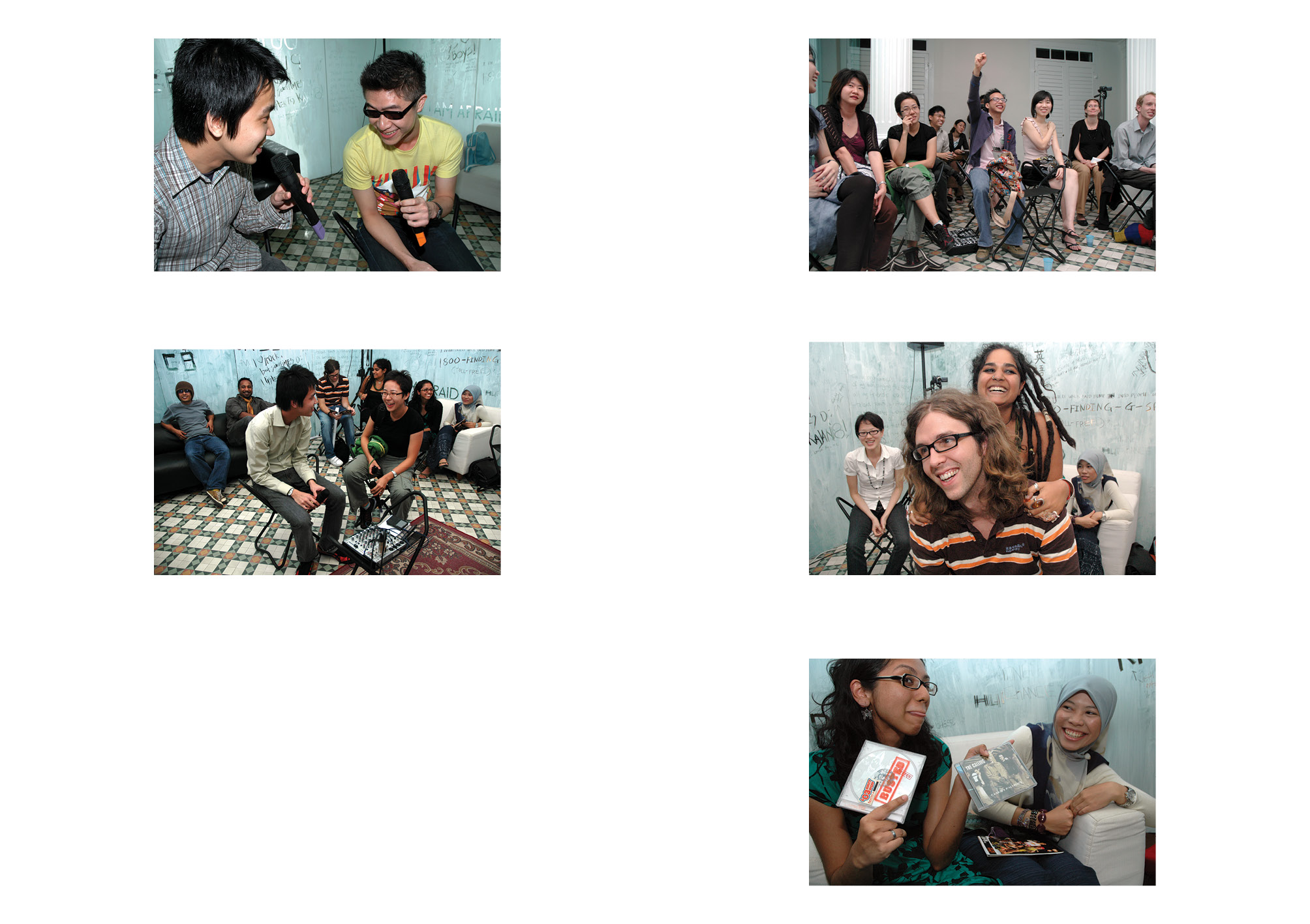
Guilty Pleasures (2007)
Listening Party
Photo credit: Jan Rothuizen

My World (2013)
Installation: autographed poster, slide projection, framed photograph, marker painting, gold-tinted mirrors, glass table, clear mirror, sneakers, chewing gum
Photo credit: Deanna Ng
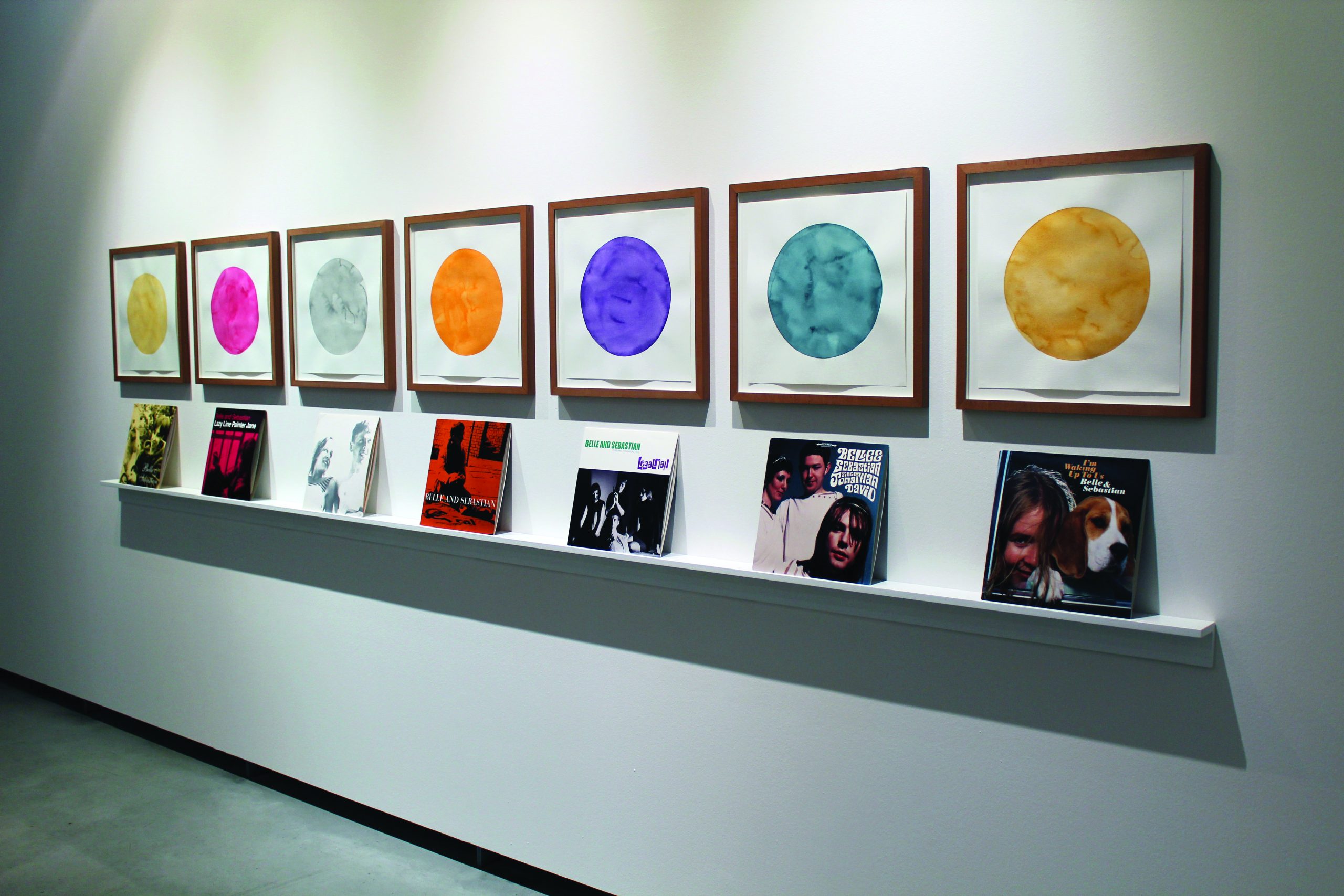
Stop Me If You Think That You’ve Seen This One Before (2011)
Seven water colour paintings and seven 12” vinyl records.
Each painting 52 x 52 cm (framed). Each record 32 x 32cm.
Footnotes
1 Adorno, T. (1941). “On Popular Music.” Studies in Philosophy and Social Science. Vol. IX. New York: Institute of Social Research pp. 17-48.
2 Ang, S-M and Cascone K. (eds). (2011). The Book of Guilty Pleasures, Singapore, self-published.
3 Toop, D. (2010). Sinister Resonance: The Mediumship of the Listener. New York: The Continuum International Publishing Group Inc.
4 Taylor, S. (2008) “Is That a Real Reality, or Did You Make It Up Yourself?” <http://www.realitysandwich.com/is_that_a_real_reality_or_did_you_make_it_up_yourself>, [accessed... June 16 2013]
Essays
Digital Mediation Ecologies: The Role of Translation in an Online Archive
In this article, I will describe a project which is still in progress: a translated video archive of radical re-elaborations of Javanese wayang kulit puppetry. Although this project is very specific in terms of its content, its philosophy and methodologies might be akin to those of projects in other fields and artistic disciplines. Therefore, although I will describe the specificities of this project, my objective is to examine its more general implications.
Translation on the website is not limited to a direct rendering of the words used in the performances in another language. Rather, it encompasses contextual explanations specific to each performance, general introductory notes and glossaries. All of these elements, taken together, add an explanatory layer to the videos. This layer was designed to provide the visitors of the website with an interactive set of options, allowing them to navigate through the subtitled videos—pausing and rewinding them at will—while reading through the notes and consulting the explanations. Since all of these materials are interrelated and serve the same purpose, I propose to call them the ‘Digital Mediation Ecology’ of this online archive. Mediation here means that these materials have an intermediary role, allowing for visitors that are not familiar with the cultural and linguistic universe of wayang to learn about the complexities of this art form and about the rich web of references that springs from the performances.

1 A screenshot of the development version of the online archive.
I believe that this understanding of translation places this project after a long line of anthropological and humanist projects that aim at offering an understanding of how art works within different cultures. As Edward Said wrote: “The task of the humanist is not just to occupy a position or place, nor simply to belong somewhere, but rather to be both insider and outsider to the circulating ideas and values that are at issue in our society or someone else’s society” (2004:76). Inspired by this understanding of humanism, this web archive aims to allow for this dual perspective, by opening up an avenue into the understanding of that which is at stake, ethically and aesthetically, in the most radical re-elaborations of Java’s oldest performance tradition.
The Archive
The Contemporary Wayang Archive (CWA) includes two dozen video recordings of new versions of Javanese wayang kulit called wayang kontemporer [contemporary wayang]. All of these performances were recorded in the past decade. Five of them were recorded especially for the archive, while the rest were part of the personal collection of the dalang (puppet-masters). Combining tradition and new influences, these performances are more accessible than the traditional ones and they represent, thematically and formally, key trends in sociocultural change patterns in Indonesia.
In order to appreciate the significance of these new versions, there are several features of traditional performances which one must consider. Although traditional performances are still common and held in high respect, young people living in cities consider them too inaccessible for three reasons. First, they are too long. A traditional performance lasts seven to eight hours. Not surprisingly, barely anyone witnesses the entire show, which begins at 9pm and ends at around 4am. The first scene, called adegan jejeran, conventionally consists of an audience scene in front of a king. This scene can last up to two hours and most of the dialogue consists of formulaic exchanges between the king and the emissaries who wish to address him. This formulaic talk is a necessary precursor to the discussion of the main problem or perkara. In other words, during most of this scene there will be no direct mention of the main dramatic problem of the performance. The perkara will only be discussed toward the end of this scene, which might well be one hour and a half into the performance. This usage of time sits in stark opposition to the fast-paced narratives to which many people are becoming used to through mass media.
Secondly, the performances are linguistically complicated. A traditional performance is delivered in Javanese, a highly registered language. In a Javanese conversation, speakers must chose the correct register or level in which to address an interlocutor, which can be ngoko, madya or krama. Each of these levels has its own vocabulary set and there is very little overlap among them. This high degree of semantic variation is so diverse that one could almost think of the levels as constituting independent languages. Young people living in cities are increasingly less interested in mastering all these levels, and the most polite one, krama, is falling in disuse. Besides these conventional levels, a wayang performance also makes use of kawi, an old version of Javanese which is closely linked to Sanskrit and which few people understand nowadays.
Thirdly, the performances are too far removed from the everyday life of young spectators. The stories are based on the spiritual quests of the heroes of the Mahabharata and the Ramayana, the Javanese adaptation of the eponymous epics of Indian origin.
However, new versions of wayang bend these traditional rules. The performances in the archive last between forty-five minutes and three hours, and they often use exclusively the lowest register of Javanese (ngoko) or they are delivered in Indonesian instead, the official language which is rapidly replacing the vernacular languages in the performing arts. The stories are also adapted to be closer to the world of spectators. They can be adaptations of old stories or new stories all together. Sandtiama Lagu Laga (2012), by Nanang Hape, is an example in case. This combination of theatre and wayang explicitly compares the biography of two wayang characters, Gatotkaca and Karna, with the lives of young people living in Jakarta.
Another example is Pertaruhan Drupadi by Slamet Gundono. This performance narrates the episode of the Mahabharata where Puntadwa loses his wife Drupadi on a bet. Eventually, he will gain her back, but in the meantime she faces the threat of rape by the Kurawa—the sworn enemies of Puntadewa and his brothers. Infuriated, she sets on a trip around the world, seeking justice, and meets then-president of the United States George Bush. This scene is a good example of how the comic genius of Slamet Gundono brings together the Mahabharata story and contemporary affairs.
DALANG. So George Bush was taking a shower. He came out of the White House, looking arrogant and vain because he had just attacked Iraq and won the war against Saddam Hussein. Apparently his favorite music was not dance, disco or jazz... but Bendrong from Banyumas.
BUSH. Who is looking for me?
DRUPADI. I am the one looking for you.
BUSH. Who are you? I am busy.
DRUPADI. Are you truly George Bush?
BUSH. Yes. The President of America.
DRUPADI. I ask for your help, the Kurawa want to rape me.
BUSH. And you are asking for my help? Alright. What do I get in return?
DRUPADI. I ask for help and you immediately talk about payment. Is this really a president? I don’t have anything.
BUSH. Then it’s impossible. There must be something given in return. Something that will benefit my country. We accept oil, we would really like some oil, even if it’s cooking oil.
DRUPADI. This can’t be true, I am asking for help! You are supposed to look after the safety of the world. You should be able to help anyone. I was neglected by my husband who put me in danger.
BUSH. Oh, that’s a menial problem. I am only interested in big events, such as the presidential election in Indonesia. [...] Your problem is insignificant.
Similar instances of comic—and more serious—adaptations of the stories to the contemporary world populate the performances in the archive. Aesthetically, these performances are a mixture of traditional conventions and new media. Some of them use other music, such as Hip Hop, Rock and Jazz instead of the conventional gamelan musical accompaniment. Another dimension of aesthetic experimentation refers to the puppets and the materials from which they are made. The word kulit means leather, which refers to the material conventionally used for making the puppets. But in kontemporer versions, leather is often replaced by other materials, such as old bicycle parts, plastic, condoms, dried grass and cooking utensils.
By shortening the duration of the performances, adapting the stories to the contemporary world and introducing new media, the dalang have found a way to maintain the relevance of the wayang tradition. These performances matter because they show how tradition is being adapted to current times. As such, they offer a kaleidoscopic view of sociocultural change in contemporary Java.
Challenges
The objective of the translation on the website is not only to offer a version of the Javanese and Indonesian utterances in English, but to explore the subtleties and richness of the allusions, jokes, and parodies contained in the wayang kontemporer performances. Wayang is highly allusive and the jokes depend on the interpretive competence of the spectators. This project aims to generate a sense of this competence through subtitles, notes and explanations. Wayang is also highly symbolic and relies on very stable, strict and easily recognisable conventions. The transgressions and modifications of these conventions are only meaningful when one understands how they differ from normative expectations.
The translation notes in the website will not only clarify aspects of the language which are difficult to translate into English; they will also explain the usage of music, stories and movement conventions. It aims to allow for an understanding of why these choices are meaningful—or offensive or critical—in their original context. Explaining the complex network of allusions and re-elaborations of aesthetic conventions in kontemporer performances poses different challenges, linked to wayang-specific performance conventions, language games and topical allusions. In what follows, I will explore different examples of all of this.
Conventions
As an example of the conventions used, we can consider the kayon, a large puppet that has very important symbolic and dramatic functions. Shaped like a leaf, this symbol-laden object represents the world in its entirety. In the front, there is a house guarded by two giants armed with club-like weapons called gadha; they represent the dangers in the world. Half-hidden by the building, a pool located beneath the house represents life. The face of kala makara, which represents time, is placed over the house and flanked by a buffalo (representing honesty) and a tiger (representing strength). A tree, which symbolises an individual person’s life journey, grows on top of the head of kala.
The kayon is always planted at the centre of the gedebog or banana tree at the beginning of a performance. When the performance begins, the dalang will move it to the side. At the end of each scene, it will be shortly placed in the centre once more. A slight inclination of the kayon indicates the progression of dramatic time: depending on the angle, one can know the pathet of a particular scene. The pathet structure corresponds to subdivision of the performance into three main sections, with specific musical modes. A kayon can also be used to represent transformations of characters from one state to another, and forces of nature, like fires and floods.
The wayang kontemporer performances often respect the conventions of the kayon’s iconography and functions. However, an extra layer of meaning is often added when new versions of the kayon—with specific meanings—are made for the performances. An example is Catur Kuncoro’s Wayang Republik, a performance that retells the story of the participation of the city of Yogyakarta in the Indonesian struggle for Independence against the Dutch in 1943-45. Although the kayon in this performance has the same shape as a traditional one, its symbolic tapestry has been adapted to represent the city of Yogya. It is believed that the spiritual power of the city depends on the fact that the kraton or Sultan’s palace is located in the centre of a line between the sea and the volcano. The palace, the ocean and the volcano are all represented in the kayon. This puppet fulfills the same dramatic function as the traditional ones. But its subtle re-elaboration of the symbols of the kayon add to the semiotic complexity of the performance. It is not discussed in the play by the dalang, but the notes explain its symbolism. As such, this explanation is part of the translation efforts of the website.
References to Topical Events
Many of the performances refer to topical political figures and events, which also require contextual explanations. As an example, I will discuss Enthus Susmono’s version of the story Dewa Ruci. A conventional wayang show always includes a scene called gara-gara where the punokawan or clown servants come on stage and make jokes that relate the world of the story being presented to the world of the spectators. In this particular performance, Enthus references specific politicians in Indonesia by name, and imitates the voice of the late ex-president Gus Dur. These linguistic and metalinguistic references are also explained by the contextual notes.
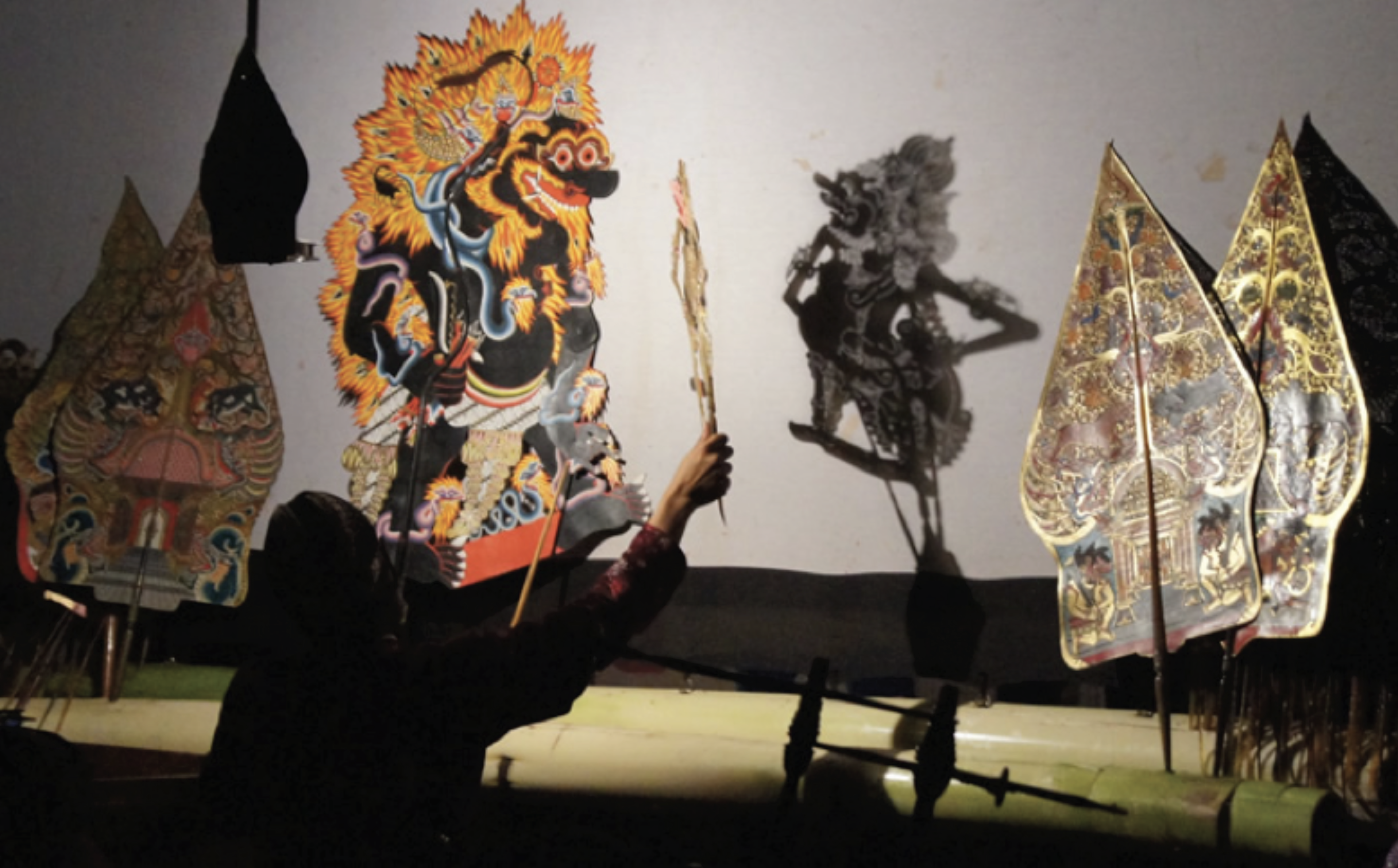
2 A conventional kayon used in a performance
(four kayon can be identified in the image).
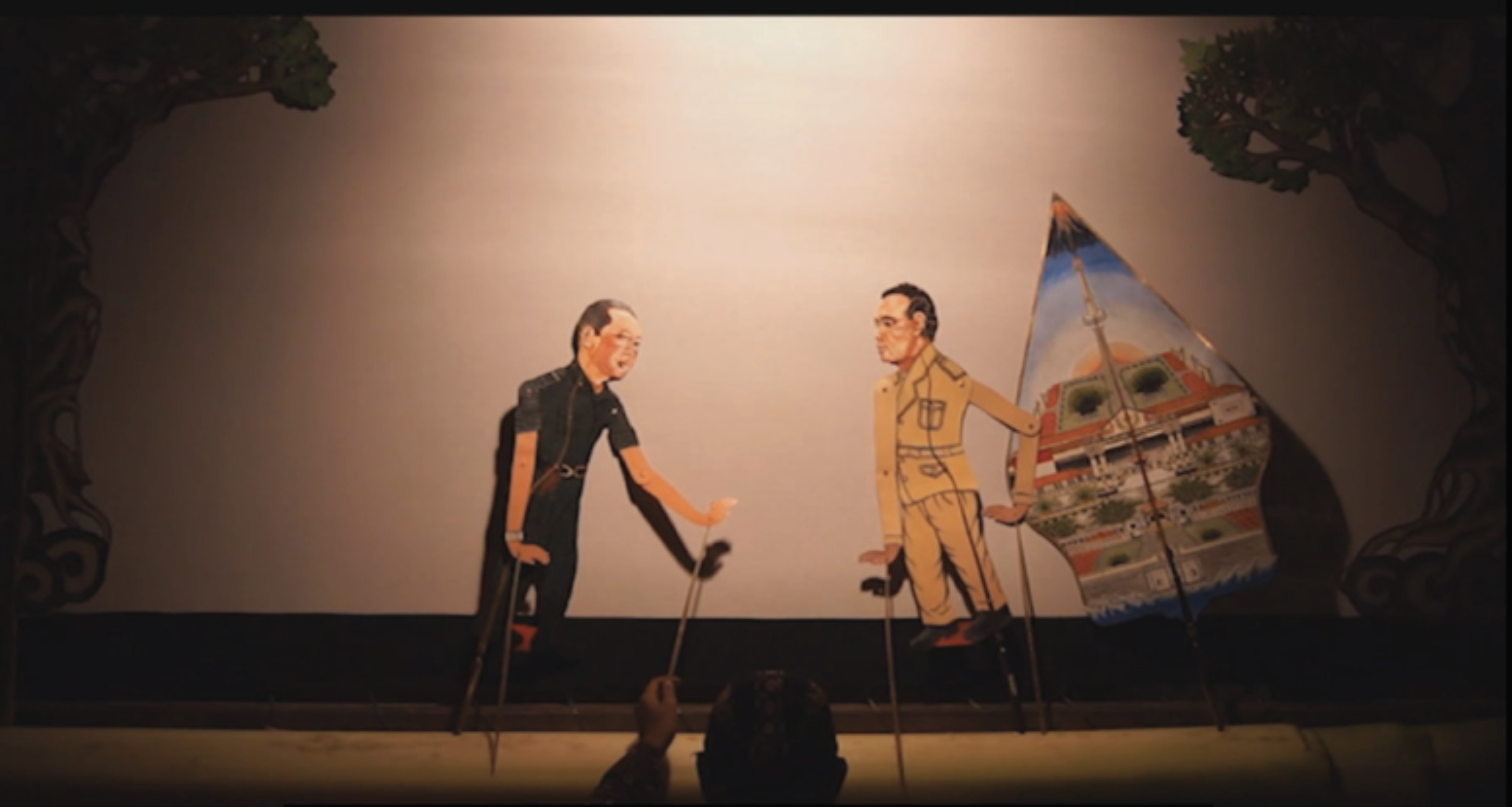
3 The kayon especially made for Wayang Republik.
Sometimes the references to topical events are not made through words and voices, but through the shape of the characters used. For example, in Wayang Kampung Sebelah, some ‘guest’ performers are introduced. One of them is Minul Dara Tinggi. From her appearance, people now that this puppet represents Inul Daratista, a famous dangdut singer whose provocative, sexy performances and scanty clothes caused a great controversy in Indonesia at the beginning of the twenty-first century.
Linguistic Playfulness
Even though the linguistic conventions of kontemporer performances are simpler than those of traditional performances, they still rely on a complex usage of the language. An understanding of the linguistic jokes is crucial to the enjoyment of a performance. As an example, we can consider Wayang Kancil, a performance that uses folk tales protagonised by animals to explore pressing environmental concerns. In one of the episodes of the performance, the main character is a crocodile, which is introduced by the dalang in the following way:
DALANG. It is said that once, on the banks of the Bengawan river, there was a creature, called Crocodile. He was a crocodile, and not a playboy. [1]
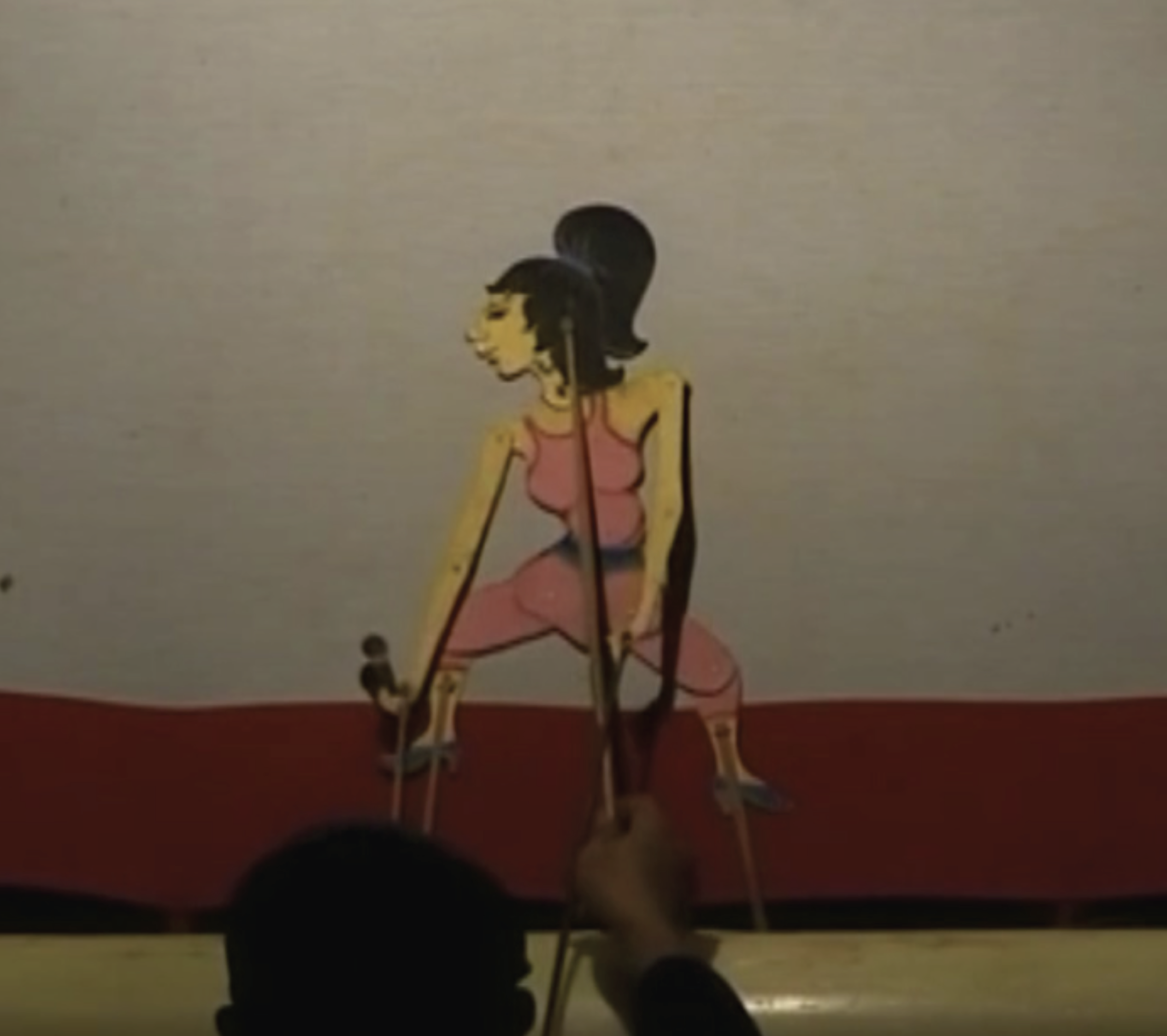
4 A puppet representing Inul Daratista.
The number in brackets refers to one of the translation notes. The translation in English tries to maintain the meaning of original utterance, but the play on the sounds is lost. In Javanese, the word bajul [crocodile] is phonetically close to mbajul [a verb that means “to try seduce women, especially ones that one was not previously acquainted with”].
Though similar phonetic jokes abound, there are other ways in which the playfulness of the language is important for understanding the performances in the archive. It has already been explained that the way one addresses an interlocutor in Javanese depends on the relative status of speakers. Even though kontemporer performances privilege the usage of ngoko [low Javanese] and Indonesian, the characters still address each other by choosing one of thirty-two honorifics which demonstrates their relative status. These honorifics range from sinuwung, which is used to address a God, to mas bro, a slang honorific of recent invention used to address friends. A direct English translation would overlook the playfulness and diversity allowed by this choice of honorifics. Therefore, the translation has chosen to preserve the original honorifics in the English subtitles. An information box next to the explanations and translation notes, contains a full list of the honorifics, with explanations and usage examples.
This section has explored the main challenges of translating the wayang kontemporer shows and explained how subtitles, notes and explanations of visual and additive signs were built into the Digital Mediation Ecology of the website.
Specificities
Translation is perhaps as old as language itself. But there are some specificities of using this within a digital environment worth considering. These features are also possible due to the accessibility of the archive, whic will be freely available online.
Correctability: The accessibility also implies that inaccuracies in the translation can be detected by a large community of users and that different versions of the translation can be made available. It is in principle possible to host entirely different translations of the same videos in the same server, allowing viewers to compare the perspectives of different translators.
Modularity: The project can be used as a component of other research projects. A built-in capacity to generate links to specific parts of the videos will be included, making it easy for other researchers or students to share links to specific parts of the videos, easily embedding this in other academic works.
‘Close watching’: The videos can be seen over and over. As the users go back and forth, they can choose from the different array of explanatory material made available, allowing for a different kind of attention to be paid to specific parts of the videos. We can think of a ‘close watching’, as a parallel to close reading.
None of these features are unique to this project and that is where their strength lies. Several similar archives exist and we can expect many more in the near future. It is not a stretch of the imagination to picture that this might become a new research paradigm in the performing arts, where online translated videos supplement more conventional performance analysis. In such a case, Digital Ecologies of Mediation would certainly change the way that academic writing is carried out.
Images courtesy of the Contemporary Wayang Archive.
References
Said, E. W. (2004). Humanism and Democratic Criticism. New York: Columbia University Press.
Essays
[I]t was as if the phrases he had in front of him had become suddenly familiar, were starting irresistibly to remind him of something, as if on to each one that he read there had been imposed, or rather superimposed, the at once precise yet blurred memory of a phrase almost identical to it that he had perhaps already read somewhere else... — Georges Perec, “The Winter Journey.”
Rereading a text can often call to mind echoes of previous readings, and at the same time create a feeling that something has altered or become distorted in the process of translating between the first and subsequent readings. This essay investigates how this notion of rereading as echo is both more pronounced and at the same time different in interactive stories, where readers rarely engage in a single reading and yet where each subsequent reading may, literally, be different from the previous readings.
We begin by discussing how critics and literary theorists have characterised the act of rereading, and look briefly at how researchers in the area of interactive storytelling have approached this process. We then introduce a model for how, and why, people reread in interactive stories. We explore the implications of our model through a close (re)reading of “A Family Supper” by Emily Short, discussing how the work initially encourages rereading for closure, but eventually frustrates attempts at further rereading beyond closure. This suggests that rereading in interactive stories, like an echo, can initially sustain interest but that this interest dissipates as the original, narrative motivation for reading is lost and readers begin to ‘play’ with the text to see how the form of the story can be distorted and broken. The challenge for authors of interactive stories is to discover ways in which this form can encourage the type of sustained, long-term interest in revisiting the story that keeps people coming back to re-experience traditional, non-interactive stories.
What is rereading?
Rereading has long been seen as an important way to distinguish a work of literature from other texts. As C. S. Lewis claims, a book can be seen as having lasting value if there is even one reader for whom that book has “been a lifelong delight, who had read and reread it, who would notice, and object, if even a single word were changed” (Lewis, 1961: 108). It is not so clear, however, what a reader is actually doing when rereading, and how rereading relates to reading.
When a reader reads a text a second time the reader already knows what is coming. This can change the experience and also the motivations for reading, since “during the process of reading, there is an active interweaving of anticipation and retrospection, which on a second reading may turn into a kind of advance retrospection” (Iser, 1980: 282). As a result, what a reader is looking for and experiencing on a second or subsequent reading can be very different from the original reading. What the reader may be looking for is not clear. According to Leitch, “[r]ereading is never simply rereading: it is always reading for something, reading from a new point of view, with new presuppositions, motives, and requirements” (Leitch, 1987: 507). In contrast, Barthes feels that a second reader is looking “to multiply the signifiers, not to reach some ultimate signified” (Barthes, 1974: 165). This suggests a need for subsequent readings to add to our experience, rather than simple recreate it. Brooks highlights the problems this creates, arguing, “unless the work gains in irony for each loss in mere mystery, second readings will be disappointing” (Booth, 1961: 285).
Despite these difficulties with the concept of rereading, there have been a number of attempts to categorise the ways in which people reread stories. Calinescu (1993) has identified three types of rereading: partial rereading, where the reader has not full comprehended or appreciated the text; simple rereading, where the reader rereads to recapture the experience of the first reading; and reflective rereading, where the reader returns to the text to look for something more—for example, to look for deeper insights, additional meanings, or to appreciate the techniques used by the author. Similarly, Bacon (2007) distinguishes between two categories of motivation to reread: the desire for sameness and the desire for novelty. He sees these two types of motivation as working together “in a complementary fashion in aesthetic reexperience” (Bacon, 2007: 1).
The tension between the desire to reread to see something new and at the same time to recapture something of the original experience in such a way that the experience remains fresh is something Kenner sees demonstrated in Joyce’s Ulysses:
Joyce’s aesthetic of delay, producing the simplest facts by parallax, one element now, one later, leaving large orders of fact assembled late or another time or never, in solving the problem of novels that go flat after we know ‘how it comes out’ also provides what fiction has never before really provided, an experience comparable to that of experiencing the haphazardly evidential quality of life; and moreover, what art is supposed to offer that life can not, a permanence to be revisited at will but not exhausted. (Kenner, 1987: 81)
The complexity of Joyce’s prose provides a reason for readers both to go back to figure out what is actually happening in the story, and to go back to recapture the enjoyment of the experience of reading the text.
Rereading in an interactive story
These discussions of rereading all make a common, perfectly reasonable assumption: however much the reader’s understanding, expectations or experience of the text may change, the text itself does not literally change between readings. Any difference in experience when rereading may be influenced by our previous readings, but the text remains invariant. This is not necessarily the case, however, in an interactive story, where the reader may be making choices that literally change what text the reader encounters, and may even possibly alter what happens in the story. This renders the traditional models of rereading somewhat problematic as it is no longer clear what, exactly, is being reread.
To explain the differences between rereading in non-interactive and interactive stories, we have proposed a model of rereading in interactive stories (Mitchell & McGee, 2012). According to this model, readers of interactive stories are initially rereading for closure, where closure is defined, after Carroll (2007), as a feeling of resolution or completion when “all the questions saliently posed by the narrative are answered” (Carroll, 2007: 1). This search for closure may involve repeatedly returning to an interactive story to try out different paths through the story and explore different variations. What is important to note here is that, although they may have ‘completed’ the story on each reading, readers who have not yet reached closure do not consider this to be rereading. It is only once the reader has reread to the point where she ‘gets the gist’ of the story, either in terms of what ‘really’ happened, finding the ‘best’ ending, or feeling that they have exhausted the possibilities, that a reader will consider subsequent readings to be rereading. At this point, the reader of an interactive story will begin to engage in something equivalent to Calinescu’s simple or reflective rereading.
The problem is that it isn’t clear what it means for either simple or reflective rereading to take place in an interactive story. For simple rereading, a reader is trying to recapture the original experience. If the story is different on each reading, it is not clear how this original experience could ever be repeated. A reader may be trying to recreate exactly the same path through the story—in this case the experience is not truly interactive, as the reader is attempting to avoid making different choices. On the other hand, the reader may be trying to recapture the experience of making choices—in this case the focus is on the choices, and not so much on the story, and the process becomes more like playing a game than experiencing a narrative. For reflective rereading, a reader is likely to be attempting to explore the ways in which the underlying interactive system works. This suggests a focus on the system rather than the story, again leading to a game-like rather than a narrative experience. This also has the implication that readers may not actually engage in reflective rereading of the story, but instead will be attempting to play with and break the system by ‘messing’ with it in ways that the author neither intended nor accounted for in the design of the system.

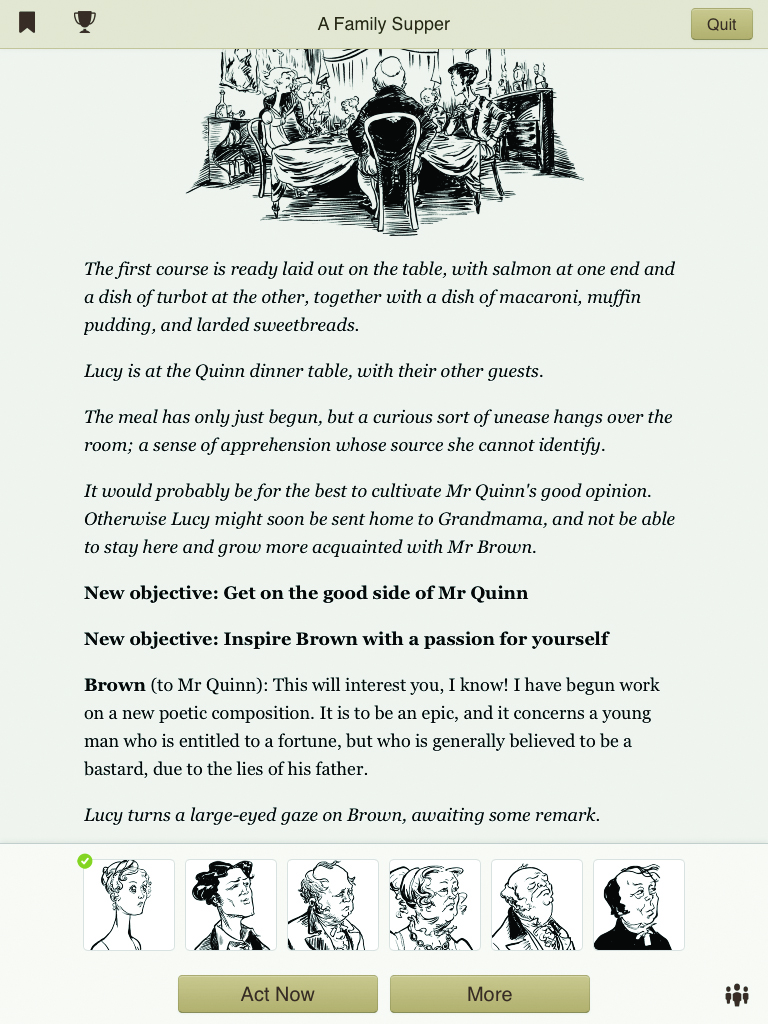
1 Emily Short’s “A Family Supper”: making a choice (left) and seeing the outcome (right).
Reading, and rereading, “A Family Supper”
To illustrate the issues that arise when considering rereading in the context of interactive stories, we present a close reading of a recent interactive story, Emily Short’s “A Family Supper”1. The story is based in England during the ‘regency’ era, and is heavily influenced by the works of Jane Austen, in particular Pride and Prejudice (Short, 2013). The reader controls one of five possible characters (Lucy, Elizabeth, Mr. Collins, the Dowager or Miss Bates), the choice of which will impact the options available in the story. The story is told through text, accompanied by simple illustrations. As the story progresses, the reader is asked to make decisions as to what the main character says in response to the other characters in the story (Figure 1). The reader is also able to determine what actions the character takes, such as moving from room to room within the house where the story is set. Other characters’ actions, and the unfolding of events in the story, are controlled by the underlying computational system, and are influenced by the reader’s choices.
The story consists of three distinct scenes. In the initial scene the reader’s chosen character, the evening’s hosts and the other dinner guests are gathered around the dinner table. This scene allows the reader to explore possible topics of conversation and get to know the various characters and their relationships. The second scene is similarly unstructured, allowing the reader to find out more about specific characters and relationships. This scene is interrupted by a disturbance in the drawing room where one of the guests has collapsed, apparently poisoned. The third and final scene involves the reader directing the main character to move around the house to look for clues, interrogate other characters, and eventually make an accusation.
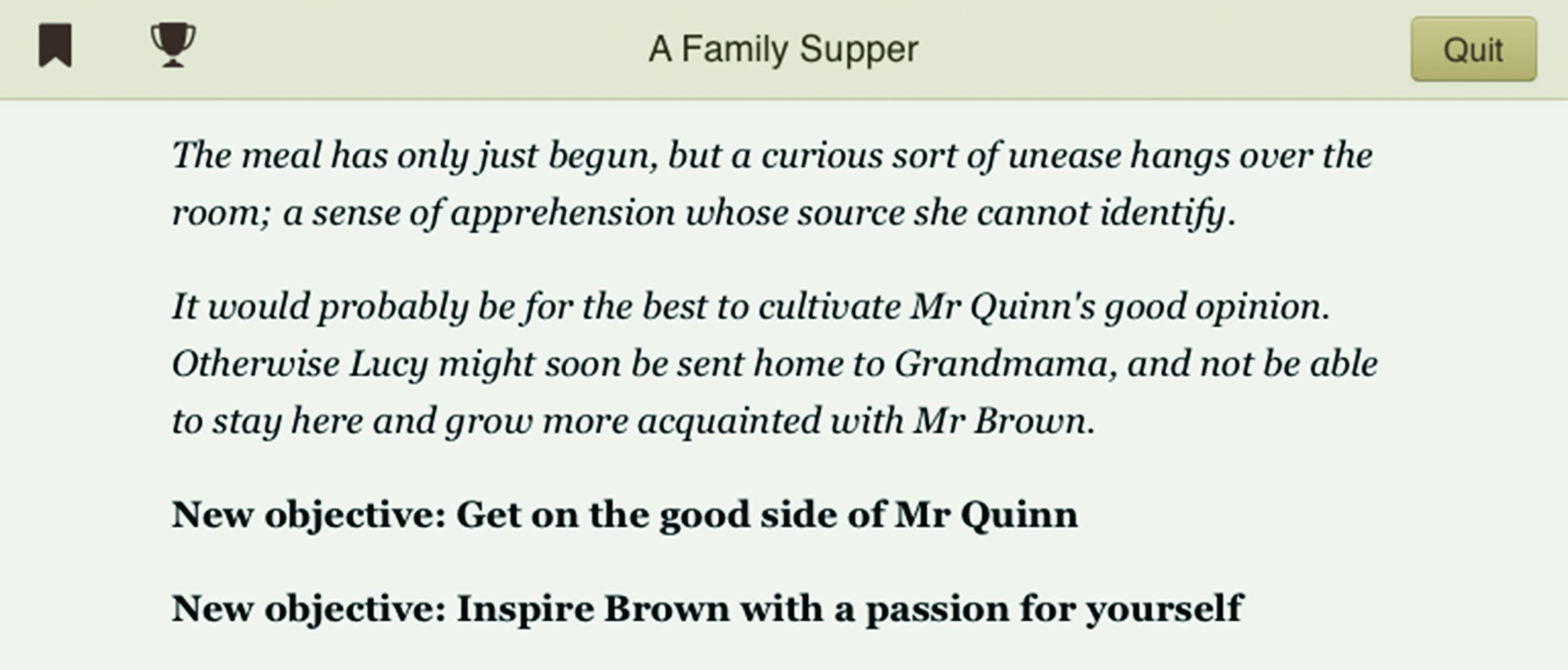

2 Objectives guide the reader through the story, and are rewarded by “achievements”.
Rereading for closure
When first encountering “A Family Supper”, the reader is strongly encouraged to reread for closure. As the story begins, the narrator provides explicit guidance as to what the reader should do. For example, the initial text in the character Lucy’s story reads: “It would probably be for the best to cultivate Mr. Quinn’s good opinion. Otherwise Lucy might be sent home to Grandmama, and not be able to stay here and grow more acquainted with Mr. Brown.” This suggests two motivations to the reader: to stay on the good side of Mr. Quinn, the host, and to pursue Mr. Brown, one of the dinner guests. In fact, these goals are shown explicitly as ‘objectives’ (Figure 2), upon completion of which you are granted a game-like ‘achievement’. This creates a very goal-oriented experience, with the reader always aware of the objectives that have not yet been accomplished.
As the story progresses, other goals are brought to the reader’s attention, helping to guide the reader through the story. For example, as the story changes to a murder-mystery in the third scene, two very specific objectives are introduced: “Who has the motivation to kill Brown?” and “When you know the motive for killing Brown, tell the Doctor.” Once these objectives have been accomplished, the goals become: “Who had the opportunity to kill Brown?” and “Who had the motive to kill Brown?” This series of objectives focuses the reader on a desire for completion and closure.
The choices the reader makes in the third scene can lead to several possible outcomes that may or may not satisfy this need for closure. For example, it is possible that the reader may not have gathered enough evidence to make an accusation. Here, the reader may choose to “wait for the magistrate to arrive and let him sort out this mess”. At this point the story became non-interactive, ending with a long sequence in which the magistrate arrives and determines that Brown killed himself. This is unsatisfying on two levels: the reader’s character has failed to solve the mystery, and the murderer was not caught. This provides an initial motivation to reread: to succeed at the objectives put forward by the story and bring the story to a satisfying conclusion. In this case, the reader will go back to the start of the story and read again with the final goal in mind, carefully looking for missed clues with the foreknowledge gained in the first reading. Consistent with our model, this is analogous to partial rereading, as the reader is attempting to gather information that was missed on the first reading.
If, instead, the reader has managed to gather enough evidence, the story comes to a decision point where Quinn asks the main character directly: “What do you say? Need we report all this to the magistrate?” Several options are available: excuse the murderer, speak for Brown, or “hesitate”. Once the choice is made, the story ends with the murderer either let free or hung. This choice provides a further motivation to reread: to explore the various possible endings, as a way to determine which of these endings is the ‘best’ or most appropriate ending.
A brief epilogue explains the fate of the main character. For example, choosing to “speak for Brown” as Elizabeth leads to the murderer being hung, and Elizabeth continuing her life “unmarried and a disappointment to her family”. A certain amount of closure had been achieved, as the murder was solved and the murderer caught. However, this is a rather lacklustre outcome from Elizabeth’s perspective, introducing an additional motivation to reread: to try to improve the main character’s fate.
These examples show that, after an initial reading, the reader will be motivated to reread either to successfully solve the murder and make sure the murderer is caught, or to explore different endings to find the best ending. Both of these motivations are explained by our model of rereading, which states that a reader will initially be rereading for closure. The reader will not, however, actually consider this to be ‘rereading’ as she is still working out her initial understanding of the story, and each reading may involve different choices, resulting in variations of the original reading that are similar to, but not the same as, the original reading.
Micro-rereadings
When rereading for closure, it is possible for the reader to go back to the start and reread the entire story. However, “A Family Supper” provides the ability to create a ‘bookmark’ at any point in the story, and then ‘reload’ the story and continue reading from that point. This feature introduces an interesting variation on rereading: ‘micro-rereading’. With the ability to go back and reread an interactive story from a bookmark, readers are able to explore possible variations without rereading the entire story. For example, rather than choosing to ‘speak for Brown’ in the final accusation scene, the reader might want to see what happens she chooses to have the main character “excuse him because hanging him is pointless”. In addition, the reader may be happy with her choices up to that point, and therefore not have any interest in rereading earlier scenes.
Once the ability to ‘bookmark’ is available, the reader may completely abandon the notion of rereading from the start and instead focus on exploring smaller paths that branch off from the ‘bookmarked’ point in the story. As a result, the reader may become disengaged from the story, instead focusing on exploration of possible variations for their own sake. This suggests that bookmarking may actually detract from the reader’s desire to reach narrative closure, replacing this desire with either a more game-like need to ‘win’, or an urge to exhaustively uncover all the possible variations. This desire for completeness is further encouraged by the ‘achievements’, which are awarded when certain goals are accomplished and are tracked across readings.
Rereading for variation
Once a reader has managed to reach closure, an issue that arises is whether there are other motivations for rereading beyond this point. The range of characters that the reader can control provides a further reason to reread: to read the story as a different main character, which may lead to interesting variations and new discoveries.
In addition to the overall story goals, each character has his or her specific goals. Once the reader has solved the murder she may choose to focus on these character-specific goals. For example, Mr. Collins is motivated by the desire to find a wife and ‘improve his prospects’. Focusing on these goals, the reader can use the unstructured and conversational nature of the first and second scenes to have Collins flirt with Lucy and strike up a friendship with Mr. Quinn’s son, Frank. Once the murder occurs, however, the reader will find herself fighting against the narrative impetus of the system, which is designed to support the murder-mystery structure of the third scene. Even though it is possible to continue to engage in conversation with Lucy and Frank, eventually the doctor will approach and insist that Collins continue with the murder investigation. The tight narrative structure of the system makes it difficult for the reader to pursue the desire to explore Collins’ character and motivations, frustrating the desire to reread to explore variation.
In the face of this frustration, one response is to try to find ways to subvert the narrative structure. This can lead to the reader ‘playing’ the system in an attempt to break it. For example, the character of the Dowager, “the granddaughter of a duke, a lady who has spent her whole life getting her own way”, presents the possibility of disrupting the story while remaining in character. However, although the Dowager can disrupt the flow of conversation in the first two scenes by constantly interrupting and taking control of the discussion, the story moves inevitably towards the final scene, where the reader will once again have to re-enact the murder investigation. In addition, the disruptive actions on the part of the Dowager do not contribute to the narrative in any way. Similar to attempts to focus on character motivations, the desire to play with the system will ultimately be frustrated by the structure of the system.
In both of these situations it is not clear how “A Family Story” can support rereading beyond closure. When trying to reread beyond closure, readers who are motivated to reread to explore variation by playing different characters or to subvert and disrupt the narrative structure will find their attempts at doing so frustrated by the constraints of the system, and will likely stop rereading at this point.
Rereading to ‘multiply the signifiers’
Although we have argued that it is difficult for readers to satisfy their desire to reread beyond closure, there are ways that ‘A Family Supper’ begins to support some form of reflective rereading. During the second reading, there are certain passages that take on new meanings in light of the reader’s knowledge gained in the first reading. For example Brown’s description of his poem, which at first may have seemed unimportant, now can be seen to mirror the situation in the main story, giving this story-within-a-story a deeper significance.
It is this multiplication of signifiers that Barthes refers to in his discussion of rereading Balzac’s Sarrasine, where ‘this retrospective reading bestows upon Sarrasine’s kiss a precious enormity: Sarrasine passionately kisses a castrato (or a boy in drag); the castration is transposed onto Sarrasine’s body and we ourselves, second readers, receive the shock’ (Barthes, 1974: 165). Similarly, as a second reader we realise that Brown is talking about himself, a realisation made more powerful by our awareness that he is about to be murdered because of this situation. This suggests that at least one form of reflective rereading is possible in an interactive story.
Rereading (other) previous texts
Readers may also find satisfaction in a realisation that there are connections between A Family Supper and other stories they have previously encountered. Short has clearly indicated that she is building on the storyworld and characters from Austen’s work (Short, 2013). In fact, certain characters, such as Mr. Collins and Elizabeth, share motivations and personality traits with the characters in Pride and Prejudice, similarities which the reader may notice, and by influenced by, when reading the story and making choices. For example, the reader may find herself trying to act the part of Elizabeth based on previous readings of Pride and Prejudice.
This introduces an additional layer of rereading: the experience of a story in which the characters and situations are making reference to, and building upon, earlier texts. Genette calls this type of work a hypertext: “any text derived from a previous text either through simple transformation… or through indirect transformation” (Genette, 1997). This makes (re)reading “A Family Supper” not just an echo of earlier readings, but also an echo, and translation from print to interactive media, of Austen’s work.
Looking back: reflections on rereading “A Family Supper”
In the above discussion we have described several ways of rereading “A Family Supper”. After an initial reading, the main motivation for rereading is to reach closure. This may involve rereading the entire story, or may take the form of “micro-rereadings” of the story from a major decision point. This desire to find the most satisfying ending or to uncover all of the details of the story are explained by our model of rereading in interactive stories, as these motivations are both based on a desire for closure.
After reaching closure, the reader may be motivated to reread for variation by taking on the role of different characters. However, the ways in which the system tries to move the story forward can frustrate these attempts at rereading for variation, leading to disruptive play where the reader tries to ‘break’ the system rather than reread for the story. There are, however, ways in which rereading can lead to other types of satisfaction, such as the discovery of foreshadowing and connections with other earlier texts. This suggests that there are, in fact, possibilities for reflective rereading in interactive stories.
Conclusion
From our close reading of Emily Short’s “A Family Supper”, we have seen that there are some similarities between rereading in non-interactive and interactive stories. In both cases, subsequent readings contain echoes of previous readings, and potentially give rise to new discoveries not present in the original reading. There are also ways in which rereading an interactive story can be quite different from rereading a non-interactive story, as a reader’s actions can open up entirely new variations during rereading. The desire to explore these variations may encourage micro-rereading rather than complete rereading of a work, and may draw the reader away from engaging with the story and instead encourage the reader to play with and try to ‘break’ the system.
The challenge for the author of an interactive story is how to use the ability to create variations as the result of reader choice to sustain the desire to reread, not just to play with the system, but also to engage with the stories that emerge from the process of play. Doing so would allow for interactive stories that, on rereading, create a myriad of interesting, engaging echoes that continue to reverberate with meaning, rather than fading and dissipating after only a few repetitions.
All images are from Short, Emily, “A Family Supper”, in Versu, Linden Research, Inc.
Copyright © 2012-2013 by Linden Research, Inc. Used by permission of Linden Research, Inc.
Footnotes
1 “A Family Supper” is implemented in the Versu storytelling system. It runs on the iPad, and is freely available from the Apple App Store. See http://www.versu.com for details.
References
Aarseth, E. (1997). Cybertext: Perspectives on Ergodic Literature . Baltimore and London: The Johns Hopkins University Press.
Bacon, H. (2007). “Cognition and the Aesthetics of Reexperience”. In Anderson, J. D. & Anderson, B. F. (Eds.), Narration and Spectatorship in Moving Images. Cambridge Scholars Press, pp. 260-276.
Barthes, R. (1974). S/Z. (Miller, R. Trans.) New York: Hill and Wang.
Booth, W. C. (1961). The Rhetoric of Fiction. Chicago: Chicago University Press.
Calinescu, M. (1993). Rereading. New Haven: Yale University Press.
Carroll, N. (2007). “Narrative Closure”. Philosophical Studies, 135(1), pp. 1-15.
Genette, G. (1997). Palimpsests: Literature in the Second Degree. (Newman, C. & Doubinsky, C. Trans.) Lincoln and New York: University of Nebraska Press.
Iser, W. (1980). The Act of Reading: A Theory of Aesthetic Response. The Johns Hopkins University Press.
Kenner, H. (1987). Ulysses. Baltimore and London: The Johns Hopkins University Press.
Leitch, T. M. (1987). “For (against) a theory of rereading”. Modern Fiction Studies, 33(3), 491-508.
Lewis, C. S. (1961). An Experiment in Criticism. Cambridge University Press.
Mitchell, A., & McGee, K. (2012). “Reading Again for the First Time: A Model of Rereading in Interactive Stories”. International Conference on Interactive Digital Storytelling 2012 (pp. 202-213). Berlin: Springer.
Murray, J. (2011). “Why Paris Needs Hector and Lancelot Needs Mordred: Using Traditional Narrative Roles and Functions for Dramatic Compression in Interactive Narrative”. In Si, M., Thue, D., Andre, E., Lester, J. C., Tanenbaum, J. & Zammitto, V. Interactive Storytelling (Vol. 7069). Berlin: Springer.
Short, E. (2013-11-3). Versu and Jane Austen. Retrieved 2013-4-7 from Emily Short’s Interactive Storytelling <http://emshort.wordpress.com/2013/03/11/versu-and-jane-austen/>
Woolf, V. (1966). “On Re-reading Novels”. In Woolf, V. Collected Essays. London: Hogarth Press.
Contributors’ Bios
Contributors’ Bios
Song-Ming Ang lives and works in Berlin and Singapore. He uses music as his starting point to produce artworks from the overlapping positions of an artist, fan, and amateur. These rule-based compositions consist of pushing an idea to its logical conclusion, or constructing situations in which events unfold. Ang has presented solo shows at Future Perfect (Singapore), Künstlerhaus Bethanien (Berlin), SoundFjord (London), Spring Workshop (Hong Kong), and The Substation (Singapore). In 2011, he was conferred the Young Artist Award by the National Arts Council of Singapore.
Heman Chong is an artist, curator and writer. He received his M.A in Communication Art & Design from The Royal College of Art, London in 2002. His conceptually-charged investigations into how individuals and communities imagine the future generates a multiplicity of objects, images, installations, situations and texts. In 2006, he produced a writing workshop with Leif Magne Tangen at the Project Arts Center in Dublin where they co-authored Philip, a science fiction novel, with Mark Aerial Waller, Cosmin Costinas, Rosemary Heather, Francis McKee, David Reinfurt and Steve Rushton. He is currently working on Moderation(s), a project that spans 2013 at the Witte de With and Spring Workshop.
Michael Lee is an artist, curator and publisher based in Berlin and Singapore. He researches urban memory and fiction, especially the contexts and implications of loss. He transforms his observations into objects, diagrams, situations, curations or texts. He has staged solo exhibitions at Künstlerhaus Bethanien (Berlin), Hanart TZ Gallery (Hong Kong) and Baba House (Singapore). He exhibited in The 3rd Kuandu Biennale 2012, The 2nd APBF Signature Art Prize 2011 (Winner, People’s Choice Award), The 3rd Singapore Biennale 2011, The 8th Shanghai Biennale 2010, The 4th & 3rd Guangzhou Triennial 2011 & 2008, and The 2005 World Exposition (Singapore Pavilion).
Joanne Leow is Vanier Canada Graduate Scholar and third-year PhD candidate in the Department of English and the Centre for Diaspora and Transnational Studies at the University of Toronto. Her dissertation theorises the role of contemporary literary texts in conceptions of late capitalist cities. She is particularly interested in spatial theory, collective memory, nostalgia and the politics of urban spaces. She has an M.A. in Literary Studies from the National University of Singapore and a B.A. in Comparative Literature and International Relations from Brown University. Her scholarly work has been published in the Journal of Commonwealth Literature, Canadian Literature, Southeast Asian Review of English and Studies in Canadian Literature. She spent most of her twenties as a broadcast journalist, television producer, morning-show host and news presenter in Singapore.
Akira Mizuta Lippit teaches film and literature at the University of Southern California in the United States. He is the author of Electric Animal: Toward a Rhetoric of Wildlife (2000), Atomic Light (Shadow Optics) (2005), and most recently, Ex-Cinema: From a Theory of Experimental Film and Video (2012). At present he is completing a book on contemporary Japanese cinema and the concept of the world.
Ahmad Mashadi is the Head of NUS (National University of Singapore) Museum, Singapore, where he recently curated Camping and Tramping: Through the Colonial Archives (2011), tracing the museological imaginary of colonial Malaya, and Heman Chong: Calendars 2020-2096 (2011), featuring the artist’s latest body of photographs based on Singapore. Mashadi has been instrumental in initiating “Curating Lab” (2012) at NUS, an intensive curatorial and internship programme for Singaporean students and recent graduates. He is the author of several catalogue essays and articles, including the seminal text “Framing the 1970s,” published in Third Text in 2011.
Alex Mitchell teaches interactive media design in the Department of Communications and New Media at the National University of Singapore. Alex’s current research investigates various aspects of computer-based art and entertainment, focusing in particular on interactive stories. This work involves creating digital and non-digital interactive storytelling systems, using these systems to develop creative works, and observing how people respond to the resulting pieces. It also involves theoretical work to understand what is happening in and around this process. His creative work has been shown at venues such as the Science Museum in London, Graphite 2004 at the Nanyang Technological University in Singapore, the Creative Curating Lab at the Singapore Art Show 2005, and Displacements. His fiction has been published in Dark Tales, an anthology published by the National Library Board, Singapore, and Twenty-Four Flavours: Sushi, a collection of flash fiction published by Math Paper Press.
Darren Moore is an Australian drummer, sound artist, composer and educator based in Singapore. He performs regularly on drum set, electronics and modular synthesizer in predominantly jazz, experimental and improvised music styles. Darren is an active member of the music scene in Singapore and performs extensively in Australia, Southeast Asia, Japan and Europe with leading musicians in his field. Darren is a Lecturer in Music at LASALLE College of the Arts, Singapore and is also pursuing a Doctorate of Musical Arts at Griffith University in Brisbane Australia, which looks at the adaptation of Carnatic Indian rhythms to drum set.
Jecheol Park is an assistant professor in the Department of English Language and Literature in the National University of Singapore. His research interests are in contemporary East Asian cinemas, Korean film and media, postcolonial and global non-Western cinemas, and the politics of aesthetics and affects in film and media. His recent essays have appeared in the journal Film Criticism and the collection World Cinema and the Visual Arts. He is currently working on a manuscript on the politics of aesthetics and affects in contemporary East Asian films entitled The Vicissitudes of Postnational Affects: Visuality, Temporality, and Corporeality in Global East Asian Films.
Lauren Reid is an independent curator from Melbourne, Australia, currently based in Berlin, Germany. She is also Coordinator at the Node Center for Curatorial Studies, and develops social media for the Künstlerhaus Bethanien. From 2009-2011 she was Gallery Coordinator at Grantpirrie Gallery, Sydney. Reid holds a Bachelor of Arts/Visual Arts (Honours) from the Australian National University.
Richard Streitmatter-Tran is an artist based in Ho Chi Minh City and director of the contemporary art studio and experiment, dia/projects. He is also Senior Lecturer of Design at RMIT University Vietnam.
Tan Pin Pin’s films about Singapore and her histories, have screened at Berlin, Pusan, Cinema du Reel, Viennale, Visions du Reel, Rotterdam, MOMA and at the Flaherty Seminar. They have also screened internationally on Discovery Networks. In Singapore, they have received sold-out theatrical screenings, toured schools and have been acquired by Singapore Airlines for their in-flight entertainment services. Cinema du Reel, in its award citation, describes Invisible City as “a witty, intellectually challenging essay on history and memory as tools of civil resistance”. The Straits Times describes Singapore GaGa, voted the Best Film, 2006, as “one of the best films about Singapore”. Moving House, her thesis film, won the Student Academy Award for Best Documentary.
Trinh T. Minh-ha is an internationally renowned independent filmmaker, writer, artist, and music composer, and is well regarded for her perspectives as a feminist and post-colonial theorist. She is Professor of Gender and Women’s Studies and Rhetoric at the University of California, Berkeley. Both her teaching and work focus on cultural politics, post-colonial studies, contemporary critical theory and the arts; among the many books she has written are Woman, Native, Other: Writing Postcoloniality and Feminism (1989); When the Moon Waxes Red: Representation, Gender and Cultural Politics (1991); Framer Framed (1992); Cinema Interval (1999), The Digital Film Event (2005) and most recently, Elsewhere, Within Here: Immigration, Refugeeism and the Boundary Event (2010). She has also produced numerous films, such as Night Passage (2004), The Fourth Dimension (2001), A Tale of Love (1996), Shoot for the Contents (1991) Reassemblage (1982), Naked Spaces (1985) and Surname Viet Given Name Nam (1989); all seven feature-length films have been screened in some forty four retrospectives around the world, garnering several awards, among which are the Trailblazers award at MIPDOC, Cannes; the Jury’s Best Cinematography Award at the 1992 Sundance Film Festival; and the Blue Ribbon award for Best Experimental feature at The American International Film Festival. She has also participated with large multi-media installations at the Guangzhou Art Triennial, the Okinawa Prefectural and Fine Arts Museum, the Kyoto Art Biennale and the Yerba Buena Center for the Arts, San Francisco.
Miguel Escobar Varela is interested in the intersections between art, digital media, and intercultural communication. He has explored these intersections as a translator, web developer, video editor, teacher and performer, while living in Mexico, The Netherlands, Singapore and Indonesia. His publications on digital art and intermediality have appeared in the Boekman Tijdscrhift (Dutch Journal of Art and Cultural Policy) and in Performance Research. He is currently a PhD candidate at the National University of Singapore.
Venka Purushothaman is an art writer, academic, and arts and cultural manager. He is currently Vice-President (Academic) and Provost at LASALLE College of the Arts, Singapore. He has researched and written extensively on visual arts, performing arts and arts management with an interest in contemporary art. He has written essays on numerous artists including Pierre & Gilles (France), Nathalie Junod Ponsard (France), Parvati Nayar (India), Salleh Japar (Singapore). His artist monographs include: Dance Me through the Dark: The Photography of Tan Ngiap Heng (2008); and Salleh Japar: Gurindam dan Igauan (2004). His books on arts and culture include Making Visible the Invisible: Three Decades of the Singapore Arts Festival (2007) and Narratives: Notes on a Cultural Journey, Cultural Medallion Recipients, 1979-2002 (2002). His forthcoming book is The Art of Sukumar Bose: Reflections on South and Southeast Asia published by the Institute of Southeast Asian Studies.
Susie Wong is an art writer, curator and artist. She contributes to several publications in Singapore: she was a regular art reviewer in the 1990s for The Straits Times, Singapore, and is a regular art feature writer for magazines such as ID, and d+a in architecture and design, among many others. She has also written for publications such as Southeast Asia Today, 1995. She is a member of AICA (International Association of Art Critics - Singapore Chapter).

